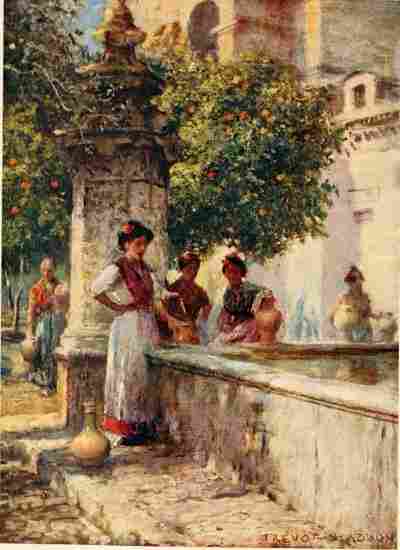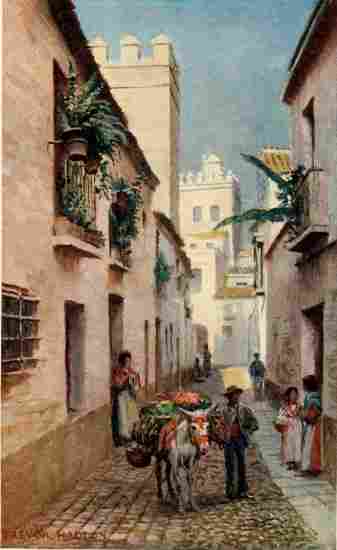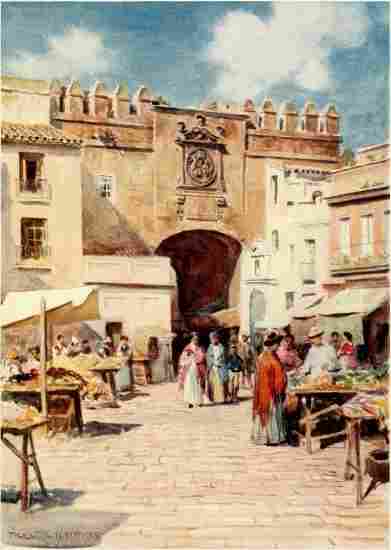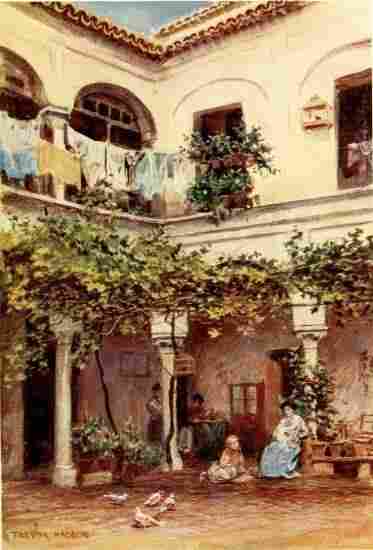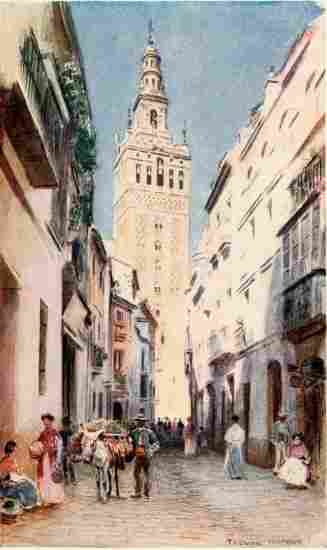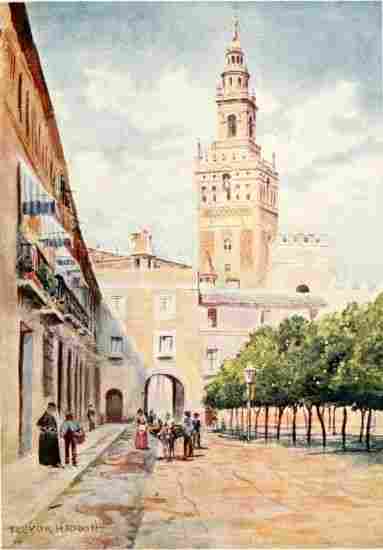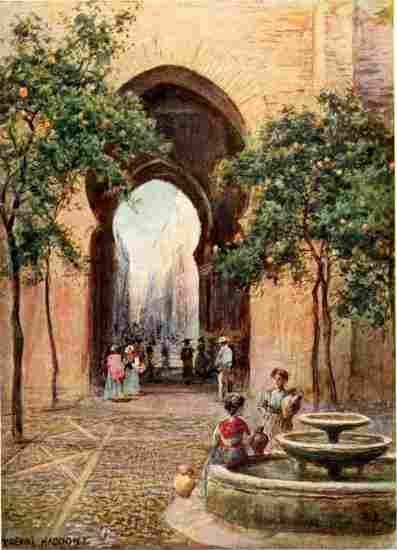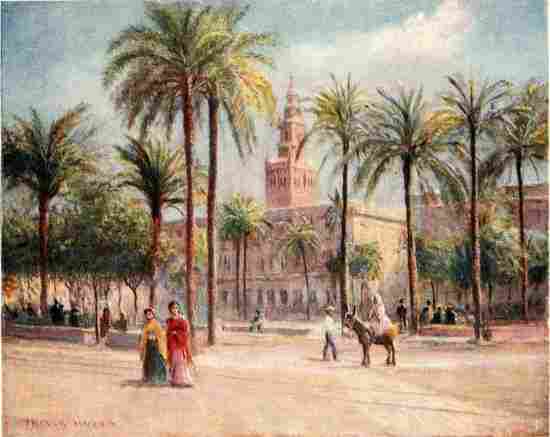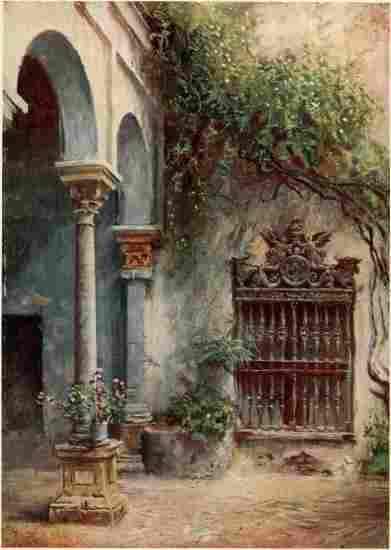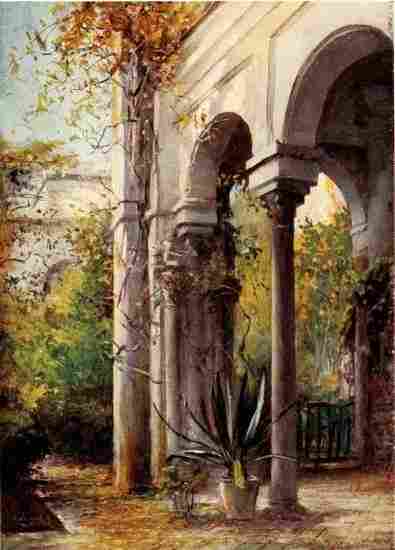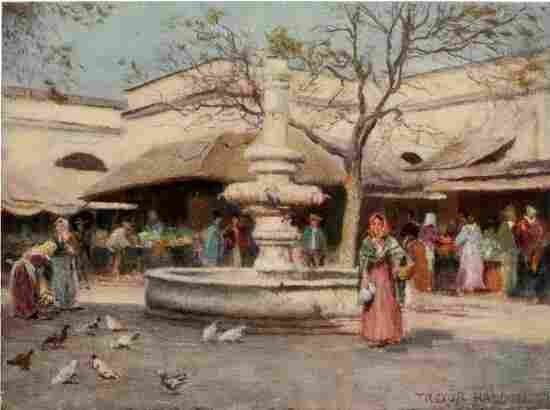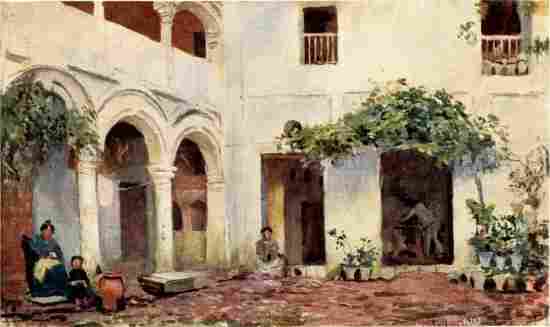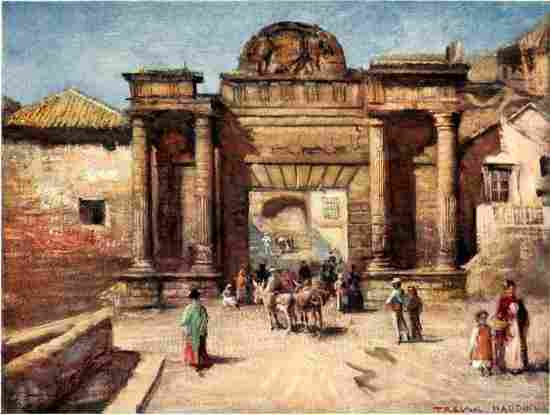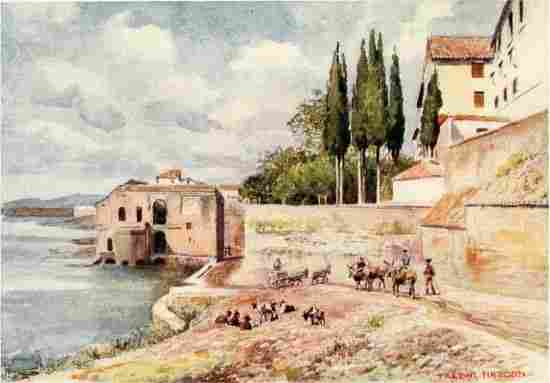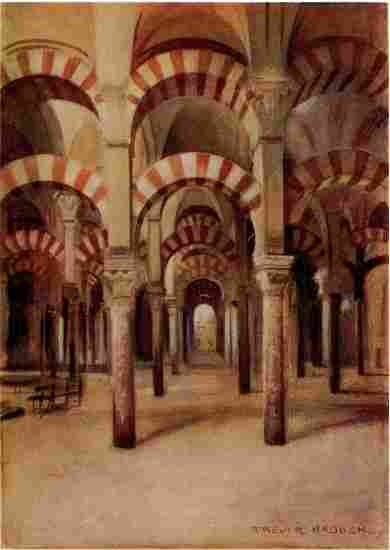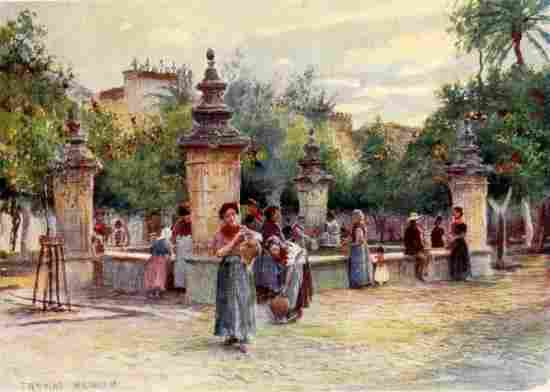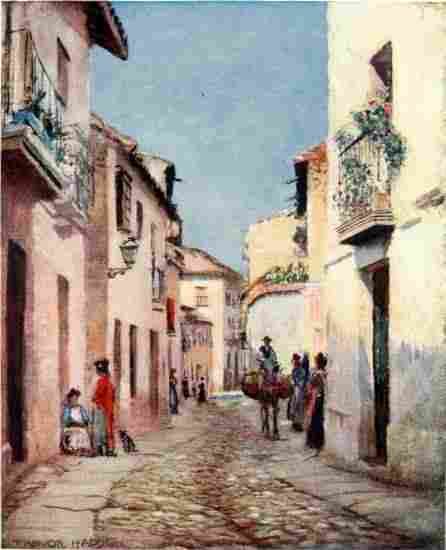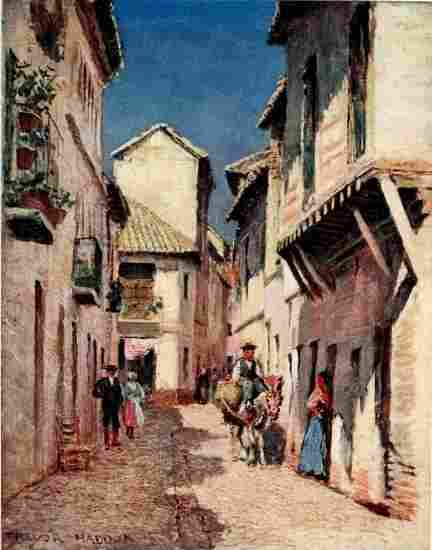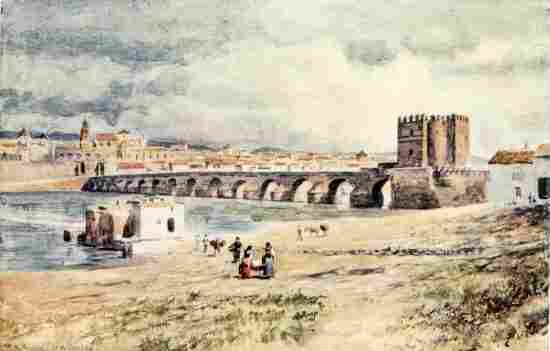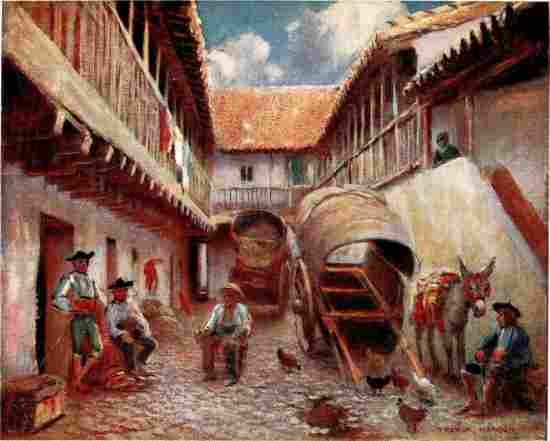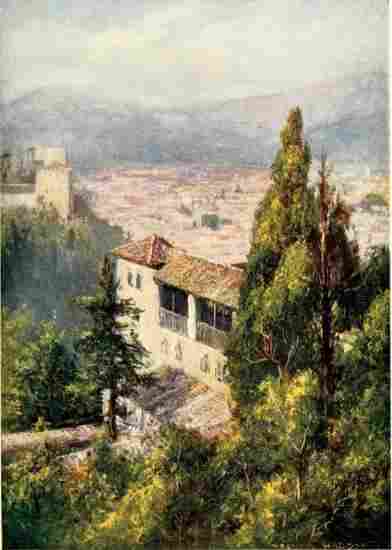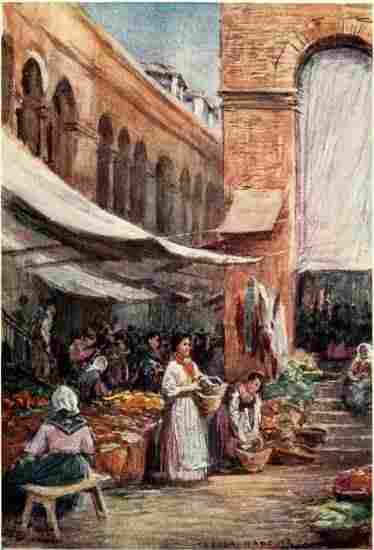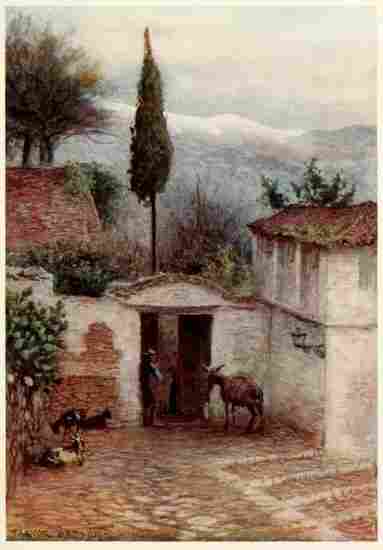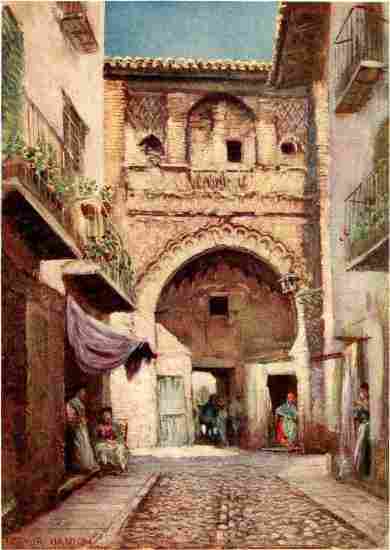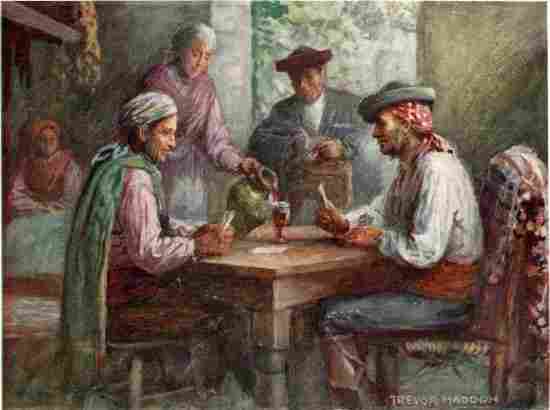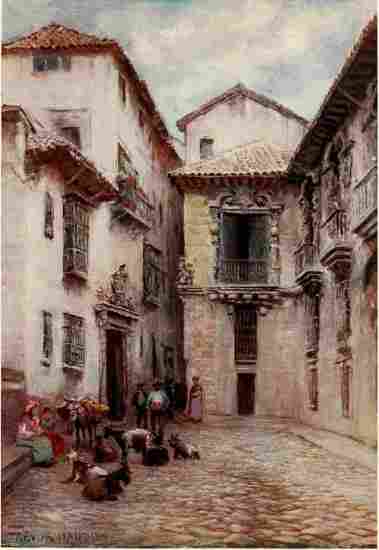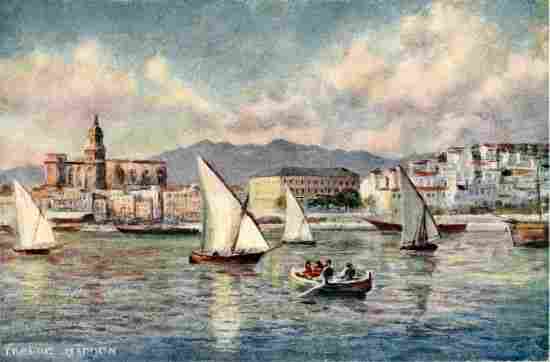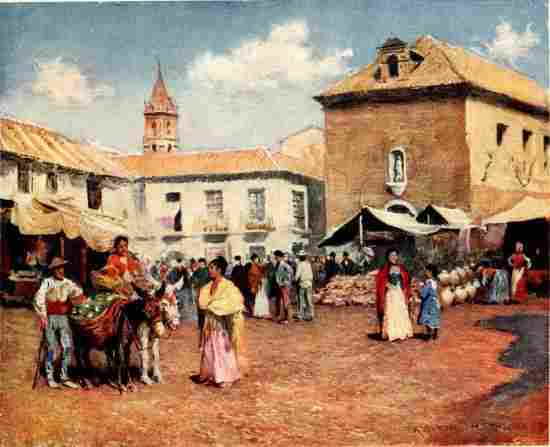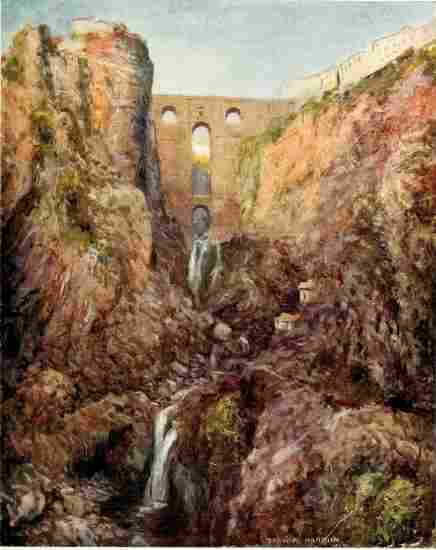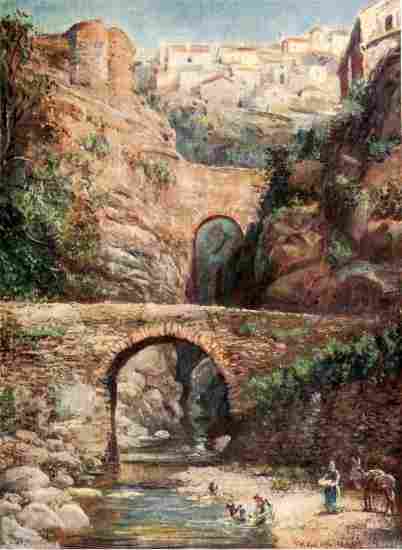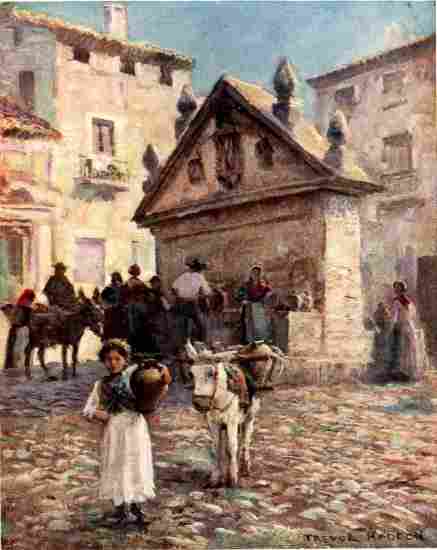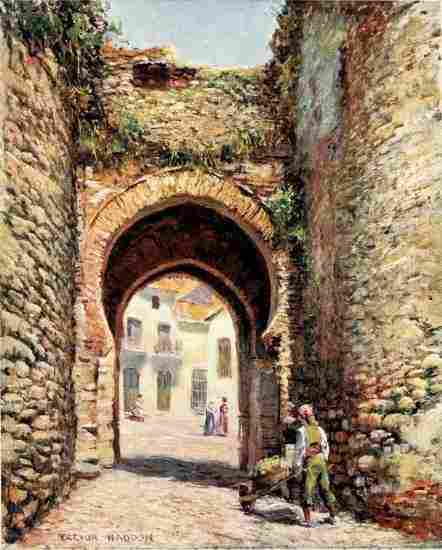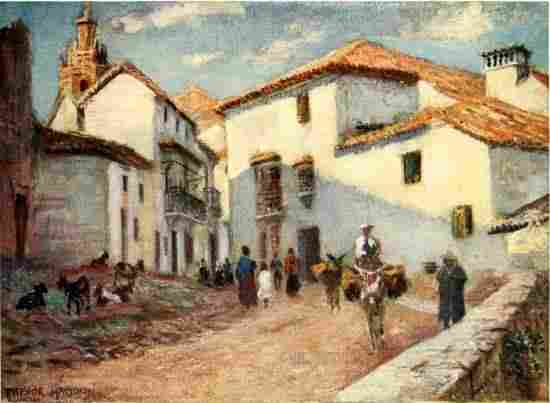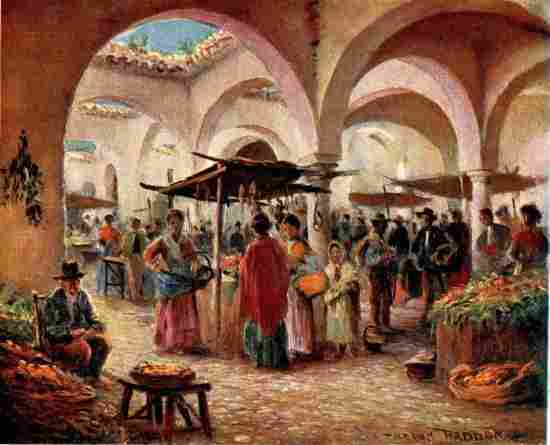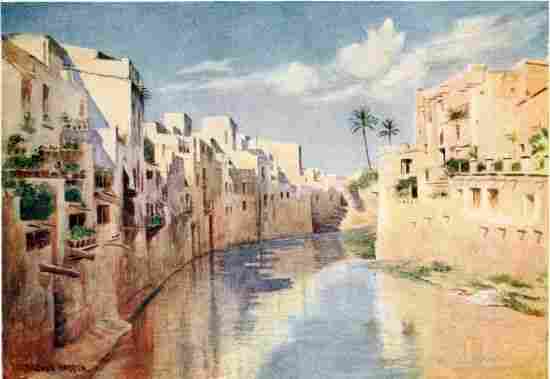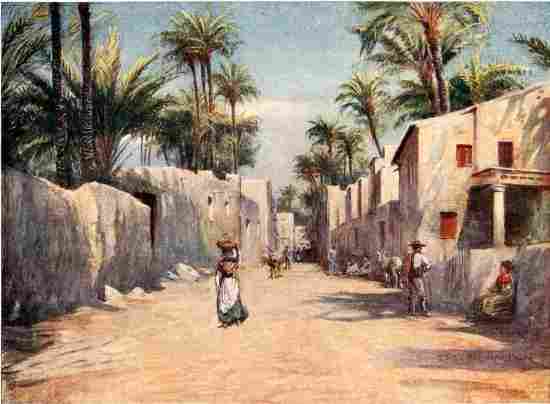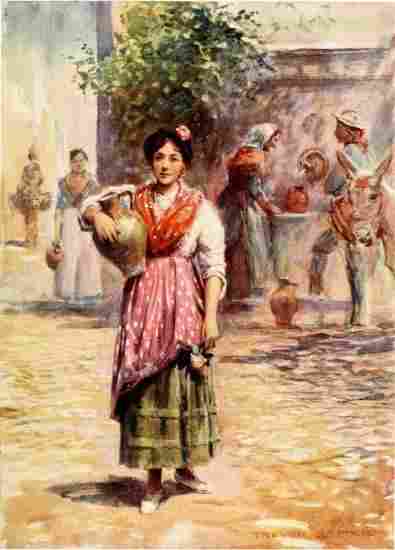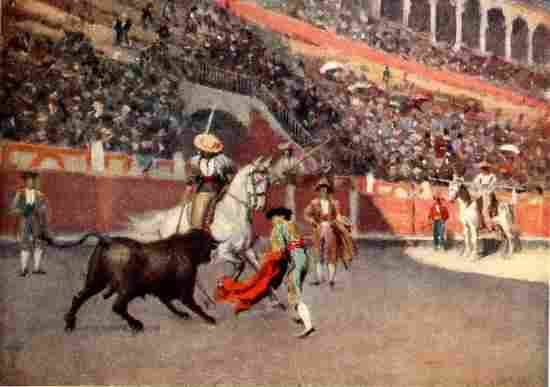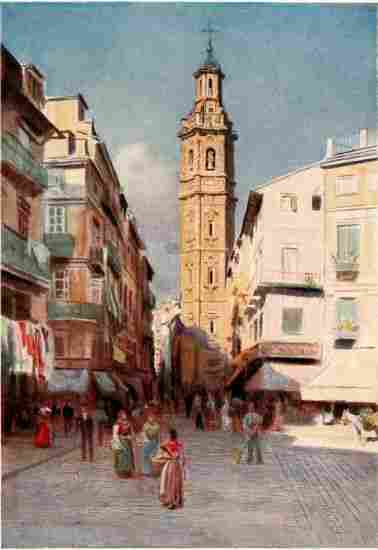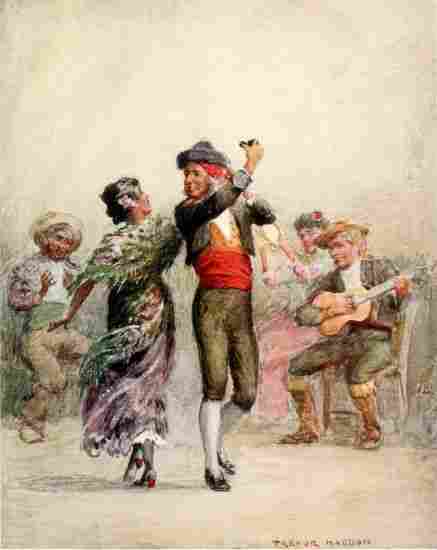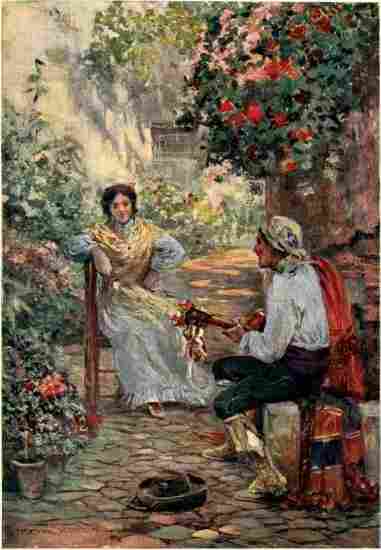.
SOUTHERN SPAIN
PAINTED BY TREVOR
HADDON · DESCRIBED
BY A. F. CALVERT · PUB-
LISHED BY A. & C. BLACK
LONDON · MCMVIII

PREFACE
FEW travellers have leisure enough to traverse the wide realm of tawny Spain in its every part. Those who must confine their attention to a single province naturally select Andalusia, where all the Northerner's preconceptions of the South find realization. The wild scenery of Southern Spain, the gay open-air life of the people, the monuments attesting the splendour of the extinct civilization of the Moor, the spell of romance which still holds its cities, makes this land one of the most interesting and fascinating in Europe to the artist, the archæologist, and the dreamer.
The present volume, mainly the embodiment of personal impressions and observations, is intended partly to supply the place of a guide-book to this part of the Peninsula, and with that object I have brought together as much of history, art, and topography as the traveller is likely to assimilate. Into the descriptive matter I have introduced a little gossip, which will, I hope, be not found altogether irrelevant, and may serve to beguile the tedium of a bare recital of facts.
While I have endeavoured to make the book as useful to travellers as within the prescribed limits was possible, I have essayed to give it, by means of the illustrations, a more permanent value. It is on the brush rather than on the pen that I have relied to convey an idea of the gorgeous panorama of Southern Spain, and to recall to the returned traveller his impressions of the land.
As a vade-mecum, then, for the tourist, and as an album and souvenir of the fairest portion of the realm of the Catholic King, I hope that the present volume will be of use to the public, despite the shortcomings it doubtless contains. For rendering these as few as possible, I have to thank several friends who have looked through the proofs. To one in particular, Mr. E. B. d'Auvergne, I am indebted for various scraps of original and entertaining information.
A. F. CALVERT.
| CONTENTS | |
|---|---|
| CHAPTER I | |
| PAGE | |
| CADIZ | 1 |
| CHAPTER II | |
| Seville—THE PEARL OF ANDALUSIA | 12 |
| CHAPTER III | |
| CORDOVA | 86 |
| CHAPTER IV | |
| GRANADA | 107 |
| CHAPTER V | |
| MALAGA | 163 |
| CHAPTER VI | |
| THE WAY SOUTH | 169 |
| CHAPTER VII | |
| THE KINGDOM OF MURCIA | 174 |
| CHAPTER VIII | |
| IN THE OLD KINGDOM OF VALENCIA | 186 |
| INDEX | |
| LIST OF ILLUSTRATIONS | ||
|---|---|---|
| 1. | Cordova—Fountain in the Patio de los Naranjos | Frontispiece |
| PAGE | ||
| 2. | Ayamonte (The Gateway of Andalusia) | 8 |
| 3. | Seville—A Street | 12 |
| 4. | Seville—The Aceite Gate | 20 |
| 5. | Seville—A Courtyard | 24 |
| 6. | Seville—The Torre del Oro and the Cathedral | 28 |
| 7. | Seville—The Giralda | 30 |
| 8. | Seville—Gardens of the Alcazar | 34 |
| 9. | Seville—Gardens of the Alcazar | 40 |
| 10. | Seville—Patio de las Banderas | 44 |
| 11. | Seville—Gardens of the Alcazar | 50 |
| 12. | Seville—Interior of the Cathedral | 56 |
| 13. | Seville—Patio de los Naranjos | 60 |
| 14. | Seville—Plaza de San Fernando | 64 |
| 15. | Seville—Casa de Pilatos | 68 |
| 16. | Seville—Casa de Pilatos | 72 |
| 17. | Seville—Garden of the Casa de Pilatos | 78 |
| 18. | Seville—The Market Place | 80 |
| 19. | Cordova—A Courtyard | 84 |
| 20. | Cordova—Entrance to the City | 86 |
| 21. | Cordova—Calle Cardinal Herrera | 88 |
| 22. | Cordova—Moorish Mill | 90 |
| 23. | Cordova—Mezquita | 92 |
| 24. | Cordova—Patio de los Naranjos | 94 |
| 25. | Cordova—Outer Wall of the Mosque | 96 |
| 26. | Cordova—A Street Scene | 98 |
| 27. | Cordova—A Street | 100 |
| 28. | Cordova—The Bridge | 102 |
| 29. | Cordova—Courtyard of an Inn | 104 |
| 30. | Cordova—Old Houses near the River | 106 |
| 31. | Granada—From the Generalife | 108 |
| 32. | Granada—Sierra Nevada from the Alhambra Gardens | 110 |
| 33. | Granada—Exterior of the Alhambra | 112 |
| 34. | Granada—A Street in the Albaicin | 114 |
| 35. | Granada—In the Market | 116 |
| 36. | Granada—The Alhambra: The Aqueduct | 118 |
| 37. | Granada—The Court of the Cypresses | 120 |
| 38. | Granada—Villa on the Darro | 122 |
| 39. | Granada—The Alhambra from San Miguel | 124 |
| 40. | Granada—Towers of the Infantas, Alhambra | 126 |
| 41. | Granada—Near the Alhambra | 128 |
| 42. | Granada—Puerta del Vino, Alhambra | 130 |
| 43. | Granada—The Alhambra: Tower of Comares | 132 |
| 44. | Granada—The Court of the Lions: Moonlight | 136 |
| 45. | Granada—The Generalife: Patio de la Acequia | 138 |
| 46. | Granada—The Generalife: Court of the Cypresses | 140 |
| 47. | Granada—Tocador de la Reina | 142 |
| 48. | Granada—Torre de las Damas | 144 |
| 49. | Granada—The Generalife: Court of the Cypresses | 146 |
| 50. | Granada—Casa del Carbon | 148 |
| 51. | Granada—Street in the Albaicin | 150 |
| 52. | Granada—Interior of a Posada | 152 |
| 53. | Granada—Old Houses, Cuesta del Pescado | 154 |
| 54. | Granada—Old Ayuntamiento | 156 |
| 55. | Granada—Street in the Old Quarter | 158 |
| 56. | Granada—The Generalife: Patio de la Acequia | 160 |
| 57. | Granada—A Corner in the Old Quarter | 162 |
| 58. | Malaga—The Harbour | 164 |
| 59. | Malaga—The Guadalmedina | 166 |
| 60. | Malaga—A Market | 168 |
| 61. | Malaga—Packing Lemons | 170 |
| 62. | Ronda—The Tajo | 172 |
| 63. | Ronda—Roman Bridges | 174 |
| 64. | Ronda—At the Fountain | 176 |
| 65. | Ronda—A Moorish Gateway | 180 |
| 66. | Ronda—A Street Scene | 182 |
| 67. | Ronda—The Market | 184 |
| 68. | Orihuela on the River Segura | 186 |
| 69. | Elche—A Street | 188 |
| 70. | A Fisher Girl (Coast of Malaga) | 190 |
| 71. | A Water Carrier | 192 |
| 72. | Malaga—A Picador | 196 |
| 73. | Valencia—Santa Catalina | 198 |
| 74. | An Andalusian Dance | 200 |
| 75. | Courting | 204 |
| Map at end of Volume | ||
The Illustrations in this Volume have been engraved and printed in England by
THE MENPES PRESS, London and Watford
SOUTHERN SPAIN
CHAPTER I
CADIZ
CADIZ was the prettiest of all the towns of Spain, thought Byron. I would rather say that she was the most beautiful. She rises out of the sea—the boundless salt ocean that stretches from pole to pole—and the crests of the waves which lick her feet are not whiter than her walls. And these by day are bathed in liquid gold, for the sun seems to linger here ere he says good-night to Europe. By night the city gleams like washed silver, and her sheen is more magical than that of the dark yet phosphorescent water. Of sun and sea, light and air, is Cadiz compounded. She is the Gateway of the West, not sultry and southern, but salt and windy and dazzling white. It is thus she appears to you, especially when you come to her over the sea—that sea which hereabouts has so often been splashed with British blood. How often the pale yellow cliffs of Spain to the southward, and those of the lovely shore of Algarve to the north, have reverberated with the booming of the cannon; how often the strand has been littered with dead men, whose gaping wounds the kindly ocean had washed clean! Browning's lines recur to the memory:
| "Nobly, nobly Cape St. Vincent to the north-west died away, |
| Sunset ran, one glorious blood-red, reeking into Cadiz Bay." |
For you can see the lighthouse on Cape Trafalgar, and the Bay of Cadiz itself has been the scene of some of England's most glorious and desperate feats of arms. There is little stirring now in the wide harbour, where the ships ride lazily at anchor, and their crews crowd to the bulwarks and exchange pleasantries with your boatman as he pulls you towards the quay. And so you step on shore, and enter the fair city.
It looks so fresh and fragrant that you would not think it ancient. But Cadiz is the first-born city of Spain, probably the first foothold of civilization on the shores of the Atlantic Ocean. It marks a new and tremendously important step forward in the world's progress. After Heaven knows how many attempts and false starts, the Phœnicians dared what no people of the ancient world had dared before. The Pillars of Hercules were regarded as the western boundary of the world: beyond was nothingness. And one day, with the east wind filling his sails and fear in the hearts of his crew, some forgotten Columbus of Sidon or of Tyre passed through the strait, and turning northward, beached his little galley on the peninsula where we stand. Civilization—arts and letters, commerce and social life, and all that makes life dear to modern men—had burst the narrow limits of the Middle Sea, and first hoisted its flag o'er Cadiz.
The thought is not uninspiring. It is not unreasonable to suppose that the first keel that ever ploughed the Atlantic grazed this strand. It is likely enough that the fleets of lost Atlantis, if that mystical isle possessed a ship, resorted hither, for the copper and precious metals of Tarshish. What voyages have begun from this port, from the little Phœnician craft setting forth in quest of the Tin Islands of the far north, to brave Cervera leading out his squadron to its preordained doom!
| "It may be that the gulfs shall wash us down, |
| It may be we shall touch the happy isles." |
And careless of fate, all these dauntless sailors have adventured forth into the deep.
In after years, the Phœnicians and Carthaginians had settlements here, and built great ugly palaces overlooking the sea and the estuaries. With their curling black beards I seem to see them, robed in the real Tyrian purple, reclining on their terraces even as their forefathers are shown in that strange picture in our National Gallery, "The Eve of the Deluge."
Their deluge was the Roman Invasion, when, in a good hour for humanity, Latin superseded Semitic civilization, and the cruel gods of Sidon bowed before the young and beautiful gods of Rome. Gades or Gaddir—I give it its two oldest names—did not suffer by its change of masters. Its mart was crowded, its merchants known from Britain to the Fortunate Isles, from Lusitania to Arabia. Much wealth engendered luxury. Life in Gades was feverish and distempered. The people had not forgotten the worship of Astarte, and the Gaditane dancing-girls proved themselves worthy daughters of the goddess. When the gods were dethroned the sensual city pined; and under the austere yoke of Islam it languished and all but faded away. It is interesting to note that its Moslem inhabitants were drawn from the old race of Philistines, some of whose gods had probably been worshipped here in the Punic days.
When Seville fell, the port continued subject to the Almohade Emir of Fez. Alfonso the Learned subdued it without difficulty in 1262, and filled it with colonists from the north coast of Spain, from such places as Santander and Laredo. But the Philistine taint in two senses was never eradicated; Cadiz remained ever financial and commercial, and cared nothing for art. Her brightest and blackest days followed the discovery of America, when she soon eclipsed Seville as the mart for the produce of the New Indies. Her wealth, not once but many times, wellnigh proved her downfall. Threatened again and again by the Barbary corsairs, she saw a far more terrible foe before her walls in 1587, in the person of Sir Francis Drake, who inflicted incalculable injury on her shipping. Worse was to come nine years later, when the English, under the command of the Earl of Essex, scaled the walls, sacked the city from end to end, slaughtered the inhabitants, profaned the churches and burnt the public buildings, and sailed away with enormous booty. Yet so quickly did Cadiz recover from this terrific catastrophe, that she again tempted the cupidity of our countrymen in 1625. But this time the Dons were well prepared and gave our fleet so warm a reception that we were compelled to retire with heavy loss.
The city attained its zenith of opulence in the first quarter of the eighteenth century, when it had become almost the exclusive entrepôt for the traffic between Southern Europe and the Americas. Numerous royal privileges and concessions secured it almost a monopoly of the trade. But no one organ can hope to escape an infection attacking the whole system. Spain in the eighteenth century was dying from that commonest of national diseases—dry-rot. Yet as late as 1770 Adam Smith did not hesitate to say that the merchants of London had not yet the wealth to compete with those of Cadiz, and a few years later the value of the bullion landed at its quays was estimated at 125 millions sterling.
Yet it was this bloated, purse-proud city, strangely enough, that proved the ark of refuge for Spain when the innumerable hosts of Napoleon swarmed over the land. Here were preserved the insignia of national independence, and here, amid the thunder of guns and in the lap of the ocean, was born the New and Free Spain. Cadiz proved a second Covadonga. The focus of the constitutional movement, she was savagely assailed by the Absolutists and their French allies. The defence of Trocadero, on the other side of the bay, against the forces of the Duc d'Angoulême popularized the name of the place throughout Europe. The pages of Balzac abound in allusions to that mischievous and futile attempt of the Government of the Restoration to rivet on Spaniards fetters that no Frenchman would wear. Then came a French invasion of another sort, of the Romanticists—of De Musset and Gautier, and the long-haired followers of Byron.
It has often seemed to me that every city belongs to one particular age. This being a fancy contrary to fact, I will put it this way—that in every city there is always some one period of human history more readily recoverable than any other. This may not be the period which has left its mark most conspicuously on the physiognomy of the place; more probably it will be determined by your own preconceptions, derived from study or chance reading. John Addington Symonds observed that an island near Venice, the name of which I have forgotten, immediately recalled to him not the great days of the Republic with which it had an historical connection, but the later and decadent days of bag-wig and hair powder. At Cadiz I could have wished to think of the Phœnicians, thus hardily adventuring into the wide ocean; or of Drake and his gentlemen adventurers, "bound wrist to bar, all for red iniquity"; but instead I fancied myself back in the 'thirties of last century, and thought of De Musset and his "Andalouse" and his lovely Spanish girls. Is it possible that Andalusia in those days of our grandfathers was the Andalusia of the Romanticists? At Cadiz, I beguiled myself into believing so—why, I cannot explain. Perhaps it was due to the unexpected appearance of a native—a distinctively Andalusian—costume in the streets. Nowhere else in Spain is the mantilla more conspicuous or more gorgeous. A French writer gives a selection of toilettes worn at a Corrida de toros, which, as I never assisted at one of these functions in Cadiz, I repeat: "All pink, coral necklace, white lace mantilla, big bunches of carnations in the hair and corsage; a blond head seen beneath a transparent mantilla, like a frail spider's web, red corsage and white gown; coral ear-rings, with bunches of roses; all black, with a white mantilla; all white, with a black mantilla; pale green gown with a blue bolero and white roses; shawl draped, brocaded, with a wealth of carnations in the hair; black dress and mantilla, violets in the hair; gold coloured shawl, embroidered with red roses, comb like a tiara set with bright-hued flowers," etc., etc. With confections such as these dazzling the eyes, it is no wonder that I began to see visions of gentlemen in black silk tights, dark green frock coats, and snowy white cravats, stammering Castilian with a Parisian accent.
It would be hard, too, to keep the mind fixed on remoter and more heroic ages, for Cadiz is singularly destitute of antiquities. The descendants of the Philistines could not be expected to respect ancient monuments! But what they spared our freebooter ancestors burned. The old Cathedral, built in the thirteenth century, was almost totally consumed by the flames. When I say that the new building dates from 1720, I fear that your interest in it will expire. But it is at least imposing; and the choir stalls are very fine. Then there is the Capuchin Convent, where Murillo met his death by falling from a scaffolding while painting the picture of the Espousals of St. Catherine. Another picture by the same master may be seen in this church—St. Francis receiving the Stigmata. The little Academia de Bellas Artes contains some admirable specimens of the work of Zurbaran, brought from the Charterhouse of Jerez.
These are the only sights in the tourists' agent's acceptation of the word, and it is likely enough that you will think three hours devoted to the city amply sufficient. Yet its situation at the end of a narrow spit like that at the entrance to the Suez Canal—in mid-sea as it were—its associations, and its brightness and cleanliness, make it for some the most charming of Spanish towns. Crenellated walls enclose it on all sides, the space between them and the water's edge being devoted to quays, promenades, and gardens. There are forts at the extremity of the peninsula—the Isla de Leon, as it is called. The streets are all very straight, very narrow, and very clean. Through the rejas across the doorways you obtain glimpses of trim little patios, bedecked with flowering plants. Occasionally you come out into a little square, prettily laid out with gardens, like the Plaza de Mina, where the loungers asleep on the seats irresistibly recall dear old busy London.
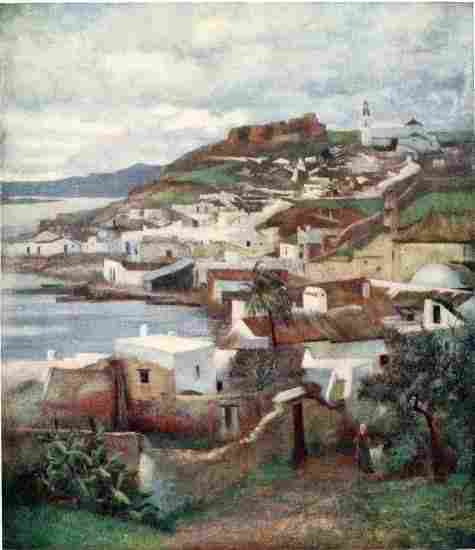
AYAMONTE (THE GATEWAY OF ANDALUSIA)
The charming Parque Genovés, bordering the sea, reminds us of the great merchant race of Italy who had their warehouses here. It is exquisite to walk by night along the sea wall, which at some points rises sheer upwards from the water, and to inhale the breezes blown straight across, one would like to think, from the West Indies. You will crave for that cool wind afterwards, in the parched interior of Andalusia.
From Cadiz you may go to Seville by steamer up the Guadalquivir, but it is far from being an interesting trip. The river is about as picturesque, and in the same way, as the Dutch Rhine. However, in these days of distorted æsthetics—when all that we thought beautiful we are now told is ugly, and vice versa—it is quite possible that some rapturous travellers will extol the mystical loveliness of the plains of the Guadalquivir, rating their charms far above the vulgar, blatant scenery of Switzerland and the Riviera, which is at the disadvantage of being at once realized by the mere ordinary person. En passant I cannot refrain from expressing my wonder why superior people of this sort go abroad. If Rhenish and Italian panoramas are suggestive to them only of oleographs and Christmas numbers, have we not our Abanas and Pharpars in England—the Essex marshes, the treeless downs of Sussex, the odoriferous banks of the Mersey, for instance?
But I digress—and I counsel you against doing so, but recommend you to proceed to Seville, if that be your destination, by rail direct. The journey occupies eight and a half hours, and is not among the most agreeable experiences of a lifetime. The railway runs right round the bay of Cadiz, touching several towns of importance. That any of them are worth a break of journey I doubt. Puerto Santa Maria is said to be much resorted to by toreros and their admirers. I have never heard what attracts them there, but indeed my interest in bull-killing was never more than languid. The country round the bay is marshy. It is traversed by the river Guadalete, beside which, it seems, Don Roderic was not slain, and the battle never took place. You must look for the scene of that epoch-making encounter farther towards the strait near the Rio Barbate.
Between Cadiz and Seville you stop at the buffet of Jerez to drink a glass of sherry in its native place. As most people know, all the good wine comes to England; but at Jerez I think, in all reason, the price of the wine might be a little lower and its quality a good deal higher. The city, of which I only caught a glimpse, looks like an inland Cadiz, very clean, white, sunny, and bright.
And so we creep onwards over dreary country—like the South African veld—to Lebrija, an old Moorish town with a great church on a height, apparently the only building of note in the place. Further on is Utrera, renowned for bulls and for possessing one of the thirty deniers for which Judas sold his Master. It should be an interesting town, with its Moorish castle and walls still extant. But the same individuality is not to be expected of the smaller Spanish as of the lesser Italian cities; for the history of the one country has been a record of steady centralization; of the other, obstinate decentralization. In Utrera, and Moron, and Lebrija—even in Cadiz and Granada—there were no independent princes or ambitious municipalities to foster and to reward native art. The genius and talent of Spain flocked to great centres like Seville, Toledo, Valladolid, and Zaragoza, and became ultimately concentrated in Madrid. We read the same story in our own country; and in fact it is impossible to resist the dangerous and obvious conclusion that centralization and unity are good things for nations but bad things for art.
CHAPTER II
THE PEARL OF ANDALUSIA
SEVILLE, in the glory of the Andalusian summer, is a city of white and gold. Her brilliancy dazzles you, as it dazzled those who wrote of her, a little wildly, as the eighth wonder of the world. Luis Guevara, a poet born within her walls, declared that she was not the eighth but the first of those wonders. In our own day, men of genius have felt her spell. "Seville," says Valdés, "has ever been for me the symbol of light, the city of love and joy." So much few northerners would feel justified in saying. To them this must be the city that most closely corresponds to their preconceived ideas of the sunny and romantic South. To Seville belong the sweep of lute-strings, the click of the castanets, the serenade, and above all, the bull-fight. There is something feminine about the radiant city, compared with the masculine strength of Toledo and Avila, and the harsh decadence of Granada. You will agree that no town is prettier, except perhaps Cadiz. So Byron said, and by him and all the poets of his school—Alfred de Musset for one—the city by the Guadalquivir was ardently loved. Yet though so conventionally romantic of aspect, Seville is busy, prosperous, and well peopled, before all other Andalusian towns. The blood still courses hotly through her veins—her vitality intoxicates. If you come from Cordova or Granada, you feel as though you were returning to the world. Here is life, here is gaiety; yet your driver the next instant takes you into a narrow, winding street, no broader than an alley, where absolute silence reigns. The windows are shuttered, no one seems to stir in the patios. There reigns a Sabbath-like calm. A minute later you are in a broad plaza, where electric cars boom and whirr, where all is animation and bustle. Such contrasts are very sharp in this city, where the streets exist simply for folk to dwell in, the squares and paseos for them to gather in and do their business. There are notable exceptions, it is true. There is no want of life in the Sierpes, the narrow street which is the Strand and Charing Cross of Seville. Here you return again and again, feeling it is the focus of the city's life. Little better than a lane is the Sierpes, where no wheeled traffic can pass. It is amazingly dark in the summer, when awnings are drawn right across it from roof to roof, and penetrating into it from the sunny plaza, it is a little time before you can accustom your eyes to the shadow. Here are the best shops, the banks, and those elegant and ostentatious casinos, where the aristocracy and leisured class lounge and smoke, and survey at their ease the unceasing procession of passers by. There are cafés here of a different sort, some of which are frequented by the bull-fighters and their admirers. Here too may be seen in all his glory that peculiar type of Andalusian, the "Majo," a curious blend of the English "masher" the "sporting man" and the "troubadour"! The people sit in the cafés to see the others pass, and the others walk down the street to see the people in the cafés. This is a form of amusement and exercise common on the Continent, and acclimatized already at our English seaside towns. Selling lottery tickets is a great industry in the Sierpes, the sale of tickets for the next Corrida de toros even more so. The boot-blacking saloons remind the American visitor of his native land. For his delectation the New York Herald is displayed in the windows of the few booksellers. There is nothing about this gay little thoroughfare to remind us of the past. The history of Seville is more easily recoverable by the fancy, when you are seated by the Guadalquivir, in sight of the Torre del Oro, on the spot perhaps where George Borrow, in an unwonted fit of hysteria, wept over the beauty of the scene before him.
Phœnician, Carthaginian, Roman, Vandal, Goth, and Moor—the city has known them all and outlived them all. There seems to have been a settlement of the Turdetani here, before the first Phœnicians came. The name at all events was bestowed by the Tyrian traders, if it is really derived from "sephela," a plain. Then came the Carthaginians, whom the Spaniards accuse of having corrupted the pure and simple-minded natives. The city became known to the little world of civilization, and was spoken of by Grecian geographers as "Ispola" and "Hispalis." The terrible Hamilcar reduced the greater part of Spain to the Punic yoke. He and his successor Hasdrubal filled Andalusia with their massive ungainly fortresses. Salambo, the Semitic Venus, was worshipped on the banks of the Guadalquivir. From time to time, we doubt not, human sacrifices stained the altars of Baal. One wonders if the descendants of the Carthaginians became identified with the other great Semitic people, and passed as Jews. Certainly it is otherwise a little difficult to account for the presence in Spain of the Israelites in such numbers at a very early period.
The Carthaginians fought hard for the province of Bætica, but Punic force and fraud were alike powerless before the sword of Scipio. The dominion of the province of Iberia passed to Rome. When the conquering hero turned his face homewards to claim his triumph, he was mindful of his warworn veterans. For them the journey back to Italy was too long and wearisome; they were content to die in the land they had conquered. Outside Hispalis a place of rest and refreshment was found for them in the village of Sancios. Scipio laid there the foundation of a colony, bestowed it on his veterans, and named it Italica, in memory of their fatherland. And thus was founded the first Latin-speaking settlement outside Italy. It lies—all that remains of it—on the slopes of the hills that bound the prospect westwards.
Hispalis, not overshadowed by its new neighbour, flourished under the Roman sway. Julius Cæsar besieged the city, which was garrisoned by Pompey's partisans, and inscribed the date of its capture in the calendar of the Republic (August 9, B.C. 45). His fleet, they say, lay in the river between the Torre del Oro and the Palace of San Telmo. The townsfolk were devoted to him, and he renamed the place Julia Romula. As a Roman colony the town had a senate and consuls, ediles and censors. The wall Cæsar built endured intact until the time of Juan II., so that monarch wrote in his Chronicle.
While its Punic physiognomy was hard to efface, Seville soon became in spirit a Latin town. All Andalusia was in course of time thoroughly Romanized. Seneca, Lucan, the Ælii, as most of us remember, were Spaniards—if Spaniards could be said, as yet, to have existed.
Then came the era of persecutions, the establishment of Christianity and the disappearance of Astarte and Baal from the forum and the temple—to be worshipped, perhaps, for a little while longer in the recesses of the mountains, where Islam lingered in after times. Presently came the Vandals, and their fury having spent itself, they made Seville their capital, though they did not give their name, as some have thought, to Andalusia. When they passed over—a whole nation—to Africa, the barbarous Suevi took possession of their old camping-ground. The Suevian king, Recchiarus, became a Catholic, at the persuasion of Sabinus, Bishop of Seville, in the year 448. We next hear of him murdering the Byzantine ambassador Censorius, in this city, and of being defeated and slain by the Visigoths in 456. Now comes an interregnum of seventy-five years. The Suevi were expelled from Seville, but their conquerors did not occupy the town. It must have been governed by its Catholic bishops, who are spoken of as miracles of wisdom and sanctity. Under Theudis the Gothic king, Seville again rose to the rank of a capital—or at any rate shared the dignity with Toledo. Here Theudis was assassinated, and his son and successor Theudisel also, a few months later. The latter sovereign is described as a detestably wicked person. He was of course an Aryan, and gave a shocking example of his hard-hearted incredulity. Among the hills where lies Italica is a village called San Juan de Aznalfarache. Near this in the sixth century was a tank which was miraculously filled once a year, when the Catholics resorted to it to baptize their catechumens. Theudisel had the tank, when it was dry, thoroughly investigated, and, satisfied that it was fed by no spring, had a lid fastened over it and sealed with his own seal. But next Easter it was full of water! Not to be baffled, the king dug a ditch to the depth of twenty-five feet all round the tank, but found no trace of a spring. He would perhaps have gone on digging for years had not his nobles rid the world of so sceptical a monarch.
We come now to the days of good King Leovgild, who consolidated the Visigothic monarchy and warred successfully against the Greeks and barbarous Suevi. His son, Ermengild, being sent to govern Seville, was converted by Leander, the bishop of the city, to the Catholic faith. The prince thought he could give no better proof of his zeal for his new creed than by revolting against his father. A bloody war resulted. Ermengild was worsted and was shut up in Seville, while his father occupied Italica and pressed him closely. The rebels capitulated and were treated leniently. The prince afterwards headed a second revolt against his father, was captured and executed. He has been enrolled among the saints of the Catholic Church.
It is quite conceivable that a man of fanatical temperament should feel himself called upon to effect the conversion of his fellows to what he believes to be the true faith, even at the cost of his kinsfolk's blood; but unfortunately for the Visigothic prince, his interests so coincided with his principles that worldly people not unnaturally suggest that the desire to wear his father's crown had as much to do with his action as the desire to convert his father's subjects.
When Spain from Aryan became Catholic, Seville became the Metropolitan See, and Leander its Archbishop. He was succeeded in that office by his brother Isidore, a much better man than he, and renowned as a doctor of the Church and writer on things generally. But by the end of the seventh century the primacy had passed to Toledo, and before the next century was fourteen years old the last of the Visigoths had reigned over Spain.
After the victory over Roderic near Jerez, Tarik, the Moorish commander, marched straight upon Toledo. The reduction of Seville he left to his superior officer, Musa. The citizens offered, it is said, a stout resistance, and then retired to Beja, on the other side of the Guadiana. During the absence of the Moorish commander they recovered the city, only to be dispossessed and finally subjugated by his son, the famous Abd-el-Aziz, the Abdalasis of Spanish story. Thenceforward for 536 years Seville was known as Ishbiliyah, one of the fairest cities of Islam.
When Musa was recalled to Damascus his son remained beside the Guadalquivir (as the river Bætis had now come to be called). He espoused, according to tradition, Roderic's widow, Exilona, who, legend says, had originally been a Moorish princess. For a brief period he dwelt in splendour in the old Acropolis, near where the Convent of La Trinidad now stands. But his enemies had been busy far away at the khalifa's court. While he was in the act of prayer in the mosque he had built adjacent to his palace, the messenger of death appeared. Exilona was left a second time a widow, and to the aged Musa was shown, months later, the lifeless head of his valiant son. Under Abd-el-Aziz's immediate successors the seat of government of the latest province of the Moslem Empire was transferred from Seville to Cordova. From all parts of the East, but especially from Syria, men came flocking to Andalusia. Quarrels arose as to the partition of the conquered land between the Berbers, who had composed the hordes of Tarik and Musa, and the new Saracen settlers. Finally it was decreed that each tribe or nationality should be allotted that region which bore the most resemblance to its original place of abode. Under this arrangement Ishbiliyah was assigned to the people of Homs, the ancient Emesa, a Syrian town on the Orontes. (We are reminded of the parallel between Macedon and Monmouth.) But in the course of time the original derivation of the Spanish Moslems was half forgotten, and the classification was rather into pure-blooded Arabs and Muwallads or half-breeds.
Here at Seville the young Abd-er-Rahman arrived, to restore the empire of his forefathers, the Umeyyas, and under these walls the horde of the Abbassides was cut to pieces. Yet despite the prosperity she enjoyed under the Western Khalifate, the city murmured against Cordova, and more than once essayed to throw off the yoke. In Abdullah's reign (888-912) a chief named Ibrahim Ibn Hajjaj assumed semi-regal state at Ishbiliyah. When he rode forth he was attended by five hundred cavaliers, and he ventured to wear the tiraz, the official insignia of the amirs. He was a liberal patron of the arts and letters. "In all the West," exclaimed a delighted bard, "I found no noble man but Ibrahim, and he was nobility itself! When you have once lived within his shadow, to live elsewhere is misery." Such flattery did not delude Ibrahim into too great a confidence in his own power. He readily submitted to the great khalifa, Abd-ur-Rahman III., by whom the city was greatly favoured. The channel of the Guadalquivir was narrowed and deepened, the palm-tree introduced from Africa, and the city adorned with gardens and fine edifices. The splendour of the court of Cordova was reflected on Seville, which became famous as a seat of learning. In those days flourished Ahmed Ben Abdallah, surnamed "El Beji," or "The Sage," the author of an Encyclopædia of Sciences which was long esteemed a piece of marvellous erudition.
Some strange and unexpected figures about this time flit across the stage of Andalusian history. The Northmen, or "Majus" as they were called by the Arabs, appeared in the year 844 off Lisbon. After spreading dismay through Lusitania they sailed their long ships southwards to Cadiz, and disembarked. They vanquished the khalifa's troops in three pitched battles, and penetrating into Seville sacked the rich city from end to end. Luckily they remained but a day and a night, and after sustaining several desperate attacks from the inhabitants of the country, with varying results, they retired overland to Lisbon, where they re-embarked. They came again fifteen years later, and this time sailed up the Guadalquivir, burnt the principal mosque, and threw down the Roman walls. Then they made sail for the eastern coasts of Spain, where they were attacked and routed by the Saracen fleet. An army of demons must these strange uncouth pirates have seemed to the Andalusians, who knew not whence they came nor to what race of men they belonged.
On the break-up of the Western Khalifate in 1009, the shrewd and powerful kadi, Mohammed Ben Abbad, secured the sovereignty of the city for himself and his descendants. He contrived to give his usurpation the appearance of legality. He espoused the cause of an impostor who personated the deposed khalifa, Hisham, and pretended to govern the city in his name. His power once firmly established, Ben Abbad disposed of his puppet, and announced that the khalifa was dead and had designated him his lawful successor. For the second time Seville rose to the rank of an independent State.
The dynasty of Abbad, emulous of the glories of Cordova, outshone all the other rulers of Spain in elegance and culture. The city was adorned with beautiful gardens and buildings. Learning was held in honour, and the amir disputed the palm with a swarm of fellow-poets. Walking one day with his courtiers, on these very banks of the Guadalquivir, the Amir Mut'adid-billah observed the water lying glassy beneath the waving light. He improvised a line comparing the surface of the stream to a cuirass, and called on the poet Aben Amr to complete the verse. This the laureate found some difficulty in doing, and to his chagrin he was anticipated by a girl of the people standing by, who contributed these lines:
| "A strong cuirass, magnificent in combat, |
| Like water frozen over." |
The amir, far from resenting this intrusion of a bystander into the royal circle, bade the girl draw nearer and asked her name. She said that her name was Romikiwa and that she was the slave of Romiya. The prince then asked if she were married. The maiden replied that she was not. "It is well," said Mut'adid-billah, "for I propose to buy you and to marry you." It is to be presumed that Romiya had no objection to offer to this plan.
This monarch, the son of the first Abbadite amir, could do other things than make verses. He was a mighty warrior in Islam, and kept a kind of garden planted with the skulls of his enemies, in the contemplation of which he took great delight. With a view to adding to his collection he made extensive conquests in what are now the provinces of Ciudad Real, Badajoz, and Alemtejo, and undertook successful expeditions against Cordova and Ronda. It was the misfortune of his son and successor, Mote'mid, to be the contemporary of those great and vigorous Castilian kings, Fernando el Magno and Alfonso VI. Conscious of the weakness of his little State, the Amir of Ishbiliyah neglected no means of humouring his powerful neighbour. Fernando sent an armed mission to his court to demand the body of the holy martyr, Justa. But though Mote'mid eagerly extended all the assistance in his power, no trace of the relics could be obtained. The mission would have been obliged to return empty-handed had not St. Isidore (the brother of St. Leander) appeared in a dream to one of the Christian envoys and commanded him to convey his remains to Leon, instead of St. Justa's. The venerable prelate's body was discovered at Italica and carried off to the north, fragrant with balsamic odours and wrapped in costly silks. Mote'mid loudly lamented the loss of the remains. "Oh! venerable brother," he was heard to exclaim, "dost thou then leave me? Thou knowest what has passed between me and thee, and the love I bear thee. I pray thee to forget me never." Very remarkable words indeed, to fall from the lips of a Mohammedan sovereign in reference to a Catholic saint.
In truth the Spanish Moslems of that day were sadly wanting in zeal for their religion. "In those days," writes an Arab chronicler, "men of virtue and principle were rare among the people of Mohammed. The majority scrupled not to drink wine and to give themselves up to every kind of dissipation. The conquerors of Andalusia disputed about their slaves and singing girls, passing their time in debauchery and pleasures, wasting the treasure of the State on amusement, and oppressing the people with exactions and tributes that they might buy the friendship of the tyrant Alfonso with costly presents. So things went on among the quarrelsome Mussulman chiefs, until, the conquerors and the conquered alike prostrated and the kings and captains having lost their pristine worth, the warriors became cowards, the people vegetated in misery and dejection, the whole of society became corrupt, and the lifeless, soulless body of Islam was only a decaying carcase. The Moslems who did not bow beneath the yoke of Alfonso consented to pay him annual tributes, constituting themselves in this manner mere tax collectors for the Christian king on their own territories. Meanwhile the affairs of Islam were directed by Jews, who obtained the offices of wizir, hagib, and khatib, reserved in another age to the most illustrious of the citizens. The Christians devastated the beautiful land of Andalusia, and carried off captives and booty, burning villages and threatening the towns."
In pursuance of his policy of conciliation, Mote'mid gave his daughter Zayda in marriage to Alfonso VI., her dowry being all the towns Mut'adid had conquered in New Castile. Lucas of Tuy says the damsel was taken "quasi pro uxore ut præmissam est." But this ambiguous union did not avert a serious rupture between the sovereigns a year or two later. When the Castilian king sent two ambassadors to Seville to collect his tribute, one of them, a Jew, conducted himself so haughtily that the exasperated Moslems stabbed him to death, letting the Christians escape without serious injury. This outrage meant war. Mote'mid cast about him for an ally. No help was to be found in Spain, and with inward misgivings, no doubt, the Abbadite amir called on the Almoravides of Africa to uphold the cause of Islam. Warned of the danger of this course, Mote'mid is said to have replied, "Better be a camel driver in the African desert than a swineherd in Castile." The Almoravides came and routed the Christians. They returned to Africa, and then came again, this time reducing all the petty Mussulman States beneath their sway. In 1091 Ishbiliyah became a mere provincial centre, the seat of a Berber governor. Mote'mid was sent in chains to Africa, where he died four years later.
The Almoravide rule was of scant duration. Fifty-five years later all Andalusia was annexed to the empire of the Almohades. The third sovereign of the new dynasty dealt what seemed a decisive blow to the allied Christians at Alarcos in the year 1195. But the conquerors knew not how to follow up their victory. The Spaniards rallied, and in 1212 was fought the battle of "Las Navas de Tolosa." The Mussulmans were totally defeated, and left, it is said, six hundred thousand dead upon the field. Yet the knell of Ishbiliyah had not yet sounded. The authority of the Almohade khalifas was nominally recognized in the city sixteen years longer. In 1228 the last of the race of Abd-ul-Mumin to rule in Spain was expelled by the famous Ben Hud, who was himself slain by his rival Al Ahmar, the founder of the Nasrite dynasty of Granada, ten years later. In their despair the people of Seville turned once more to the African Almohades. But no new army of Ghazis crossed the strait to do battle with the Unbeliever. The Andalusians were left to fight their last fight unassisted. Cordova had fallen before St. Ferdinand, and the Sevillians provoked his anger by the murder of one of their chiefs who was devoted to his interests. At the eleventh hour the defence was entrusted—strangely enough for a Mohammedan community—to a junta composed of six persons. Their names are worth being recorded: Abu Faris Ben Hafs, Sakkaf, Ben Shoayb, Yahya Ben Khaldun, Ben Khiyar, and Abu Bekr Ben Sharih.
Thus driven to bay, the Moors offered a determined resistance. They were attacked not only by the Castilians, but by their own co-religionists; for Al Ahmar, the new Amir of Granada, was serving with his followers under the banner of Ferdinand. The siege lasted fifteen months. A fleet was brought round from the shores of Biscay under the command of Admiral Ramon Bonifaz. The Moorish ships were dispersed and the chain which the defenders had stretched across the river broken. The besieged were thus cut off from their magazines in the suburb of Triana. Meanwhile all the outlying posts had been taken by the Castilians, and the Moors were driven to take refuge within the walls. Only when threatened with famine did the garrison ask for terms. They offered to capitulate if they were allowed to destroy their principal mosque to save it from profanation. The Infante Alfonso replied that if a single brick was displaced, the whole population would be put to the sword. The terms finally accorded the besieged were, for that age, not ungenerous. A limited number of families were to be allowed to remain in the city, the lives and property of these and of the rest were to be respected, and the means of transport to Africa and other parts of the peninsula were to be provided for those who were to leave. Probably only a few thousand Moors remained in Seville. Abu Faris, magnanimously declining an honourable post offered him by the conqueror, retired to Barbary. Thither he was followed by thousands of his fellow-townsmen, while others accepted Al Ahmar's invitation to settle at Granada.
Ferdinand took possession of the city on December 22, 1248. He took up his residence at the Alcazar, and allotted houses and lands to his officers, not forgetting even his Moorish auxiliaries. Among his first cares was the purification of the mosque and its conversion into a Christian church. It is interesting to note that the first of his knights to mount the Giralda Tower was a Scotsman named Lawrence Poore.
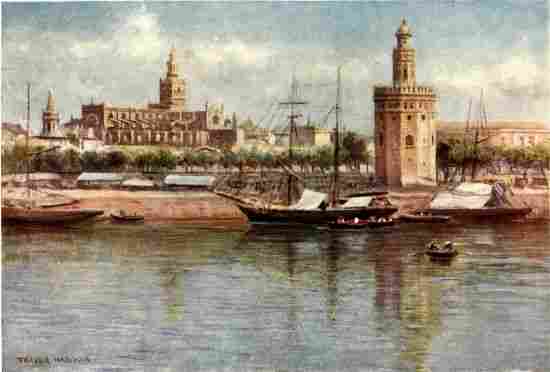
SEVILLE—THE TORRE DEL ORO AND THE CATHEDRAL
Seville had remained in the power of the Mussulmans five hundred and thirty-six years. We, who see all Spain Spanish and remember it was so at the beginning, are apt to look on the Moorish occupation as a mere episode or interlude in the history of the country. It is difficult to realize that the sway of the Crescent lasted in Seville for as long a period as has passed with us since the death of King Edward III.
Yet there are few monuments remaining to-day to commemorate a civilization which endured five centuries. The Moors have left their impress, it is true, in a scarcely definable way on the city, the physiognomy of which is more Oriental than that of Granada, a later seat of Mohammedan empire. But this is in great part due to the men who lived under the Christian kings, who had caught the spirit of the Moors and perpetuated their traditions of art and culture. Here we have no such mighty memorials of the vanished race as the Mezquita or the Alhambra. Still, a few memorials of that far-off age there are; and we will go in search of them.
Here on the quays of the Guadalquivir rises a polygonal tower of three storeys, poetically termed the "Torre del Oro." But here we find no Danaë awaiting a rescuer, but only the harbour master and his assistants. When the Almohades ruled in Seville a great iron chain was drawn across the river, and a tower built on either side to support it. The tower on the Triana side has long since disappeared, but the "Torre del Oro" remains as it was built in 1220—except, indeed, for the small turret or superstructure added in the eighteenth century. It is said, too, that it was once adorned with beautiful glazed tiles, from which (though this seems unlikely) it derived its name. In the days when it stood the brunt of the attack from the squadron of Ramon Bonifaz, it was connected with the Alcazar by a wall, called, in military language, a curtain. This was not demolished until the year 1821. At the same time disappeared the main entrance to the Alcazar.
The Almohades did much to embellish and to improve the city during their century of sovereignty. The only important Mohammedan work remaining to us in Seville belongs to that period, and illustrates the victory of the African or Berber over the Byzantine influences traceable in earlier Moorish architecture. The new conquerors of Andalusia were a virile, hardy race, and there is something vigorous and coarse in their handiwork. They developed an excessive fondness for ornamentation which mars much of their work, and were too much addicted to the use of painted stucco and gilding. To them we owe the stalactite roofing, afterwards developed with such success at the Alhambra. "It is certain," says Don Pedro de Madrazo, "that the innovations characteristic of Mussulman architecture in Spain during the eleventh and twelfth centuries cannot be explained as a natural modification of the Arabic art of the Khalifate, or as a prelude to the art of Granada, for there is very little similarity between the style called Secondary or Mauritanian, and the Arab-Byzantine and Andalusian; while on the other hand it is evident that the Saracenic monuments of Fez and Morocco, of the reigns of Yusuf Ben Tashfin, Abdul Ben Ali, Al Mansûr, and Nasr, partake of the character of the ornamentation introduced by the Almohades into Spain."
The most important example of this style is the far-famed Giralda Tower, at the north-eastern corner of the Cathedral, the most renowned of minarets and one of the strongest buildings in the world. It was built in the reign of Yakûb al Mansûr by an architect whose name is variously written Gabir, Hever, and Yever. Quantities of Roman remains and statuary were used in making the foundations. The wall at the base is nine feet in thickness, which increases with the height. The lower part is of stone, the upper part of brick. For the first fifteen metres the four faces of the tower are plain; at that height begins a series of vertical windows, mostly of two lights, some with the horseshoe, others with the pointed arch; while on either side the masonry is carved into what seem panels of trellis work. There is much in the details of this decoration to interest the student of Moorish art, who will recognize in them the inception of many forms developed (and not always to advantage) at Granada.
But the Giralda as we now see it is a third as high again as it was left by the Almohades. In their time it was crowned by a pinnacle to which were attached four balls of gilded copper—one of which was so large, we are told, that the city gate had to be widened that it might be brought hither. The iron bar supporting the balls weighed about ten hundredweights, and the whole was cast by a Sicilian Arab named Abu Leyth at a cost of about fifty thousand pounds of our money. The balls were thrown down by an earthquake in 1395, when their proportions were carefully ascertained.
It was not till 1568 that the upper stage of the fabric, a graceful Renaissance superstructure, was added by Fernando Ruiz. In the same year Morel's great statue of Faith, cast in bronze, was placed on the apex to symbolize the triumph of Christianity over the creed of Islam. It is a clever piece of workmanship, for though it weighs twenty-five hundredweights and measures fourteen feet in height, it sways and turns with every wind. Hence the name applied to the Tower—Giralda, from que gira, "which turns."
The first thing you will be asked to do by the guides at Seville is to mount the Giralda, which you do by means of thirty-five inclined planes, up which a horse might be ridden with ease to the very top. Each stage of the ascent is named: "El Cuerpo de Campañas," after its fine peal of bells, one of which weighs eighteen tons; "El Cuerpo del Reloj," after the clock first set up in 1400—the earliest tower-clock in Spain. Then there are the prettily-named floors of the Lilies and the Stars. Some of the rooms are inhabited by the bell-ringers, who may at times be heard practising not only the chimes but the peculiar guitar-playing of Andalusia.
The view from the summit of the tower I think, on the whole, disappointing. The principal buildings of the city are too closely grouped below the spectator to give a very fine effect to the panorama, and the country round is not beautiful. Looking across the arid region beyond the river, it is hard to believe that in Moorish times it was renowned for its beauty and fertility and compared by Arabic writers to the Garden of Eden. Looking down we scan the white city, a labyrinth of lanes and alleys, only here and there a plaza opening like a lake among the closely-set roofs. Far away to the north the Sierra Morena limits the prospect. How often, when from this tower the muezzin proclaimed the Islamic profession of faith, his eyes must have lingered apprehensively on those mountains from whose crests the Christian seemed to hurl back defiance and repudiation.
For the Giralda was the minaret of the great mosque begun by Yusuf, the son of Abd-ur-Rahman, in 1171, and completed by his son and successor, Yakub al Mansûr. The earlier mosque on the same site had been destroyed by the Normans, but some portions of it seem to appear in the horseshoe arches of the Puerta del Lagarto and the northern wall of the Patio de los Naranjos. This latter court, which shuts in the Cathedral on the north side, contains the fountain at which the devout Moslems performed their ablutions. The picturesque Puerta del Perdon, through which you pass on your way into the town, is a Mudejar, not a Moorish, horseshoe arch, erected by Alfonso XI. to commemorate the victory at the Salado in the year 1340. The doors with bronze plates, despite their Arabic inscriptions, also date from that time. The gate was restored in the sixteenth century and adorned with sculptures. The terra-cotta statues of St. Peter and St Paul on the outer side are the work of Miguel Florentin, one of the earliest of the apostles of Renaissance sculpture to settle in Spain. The relief over the arch, representing the expulsion of the money-changers from the Temple, is also by him, and commemorates the substitution of the Lonja or Bourse for this gate as a rendezvous for merchants. The belfry storey is modern. At the little shrine just inside, to the left on entering, may be seen a "Christ bearing the Cross," by Luis de Vargas. The money-changers and brokers have gone, but this gate remains a favourite haunt of the gossips and loungers of Seville, and in the cool of the evening is occupied by some pleasant little family groups from the adjoining houses. The southern side of the patio is occupied by the Cathedral, the western by the church or chapel of the Sagrario. The house on the north side inside the old Moorish wall, to the right of the Giralda gate (on entering), is occupied by the Biblioteca Colombina, bequeathed by the son of Columbus. The pulpit from which St. Vincent Ferrer, the "Angel of the Judgment," thundered forth his terrific fulminations against sinners, Jews, and heretics, I omitted to notice.
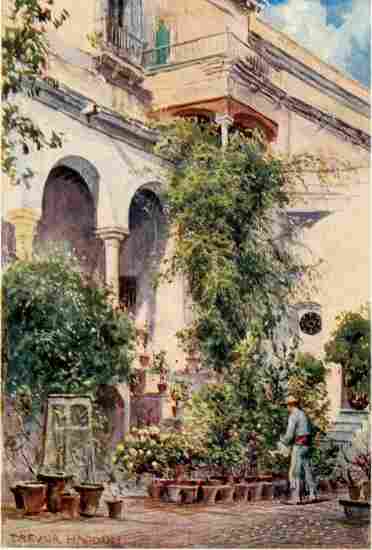
SEVILLE—GARDENS OF THE ALCAZAR
Everyone who reaches the Patio de los Naranjos for the first time is sure to enter the Cathedral, which he should not do until the Alcazar at least has been visited. Not that the two great buildings of Seville exhibit any transition of style from the one to the other, but because, having begun the consideration of Moorish architectural work, we ought naturally to pass on immediately to the Mauresque work of the first century of Castilian rule.
The group of buildings which for greater clearness we will call, with the Spaniards themselves, the Alcazares lie to the south of the Cathedral, and are surrounded by an embattled wall built by the Arabs. This enclosure, it should be understood, includes a great many private houses and open spaces besides the Alcazar proper. Immediately inside the wall are two squares called the Patio de las Banderas and Patio de la Monteria. At the far end of the former is the office of the governor of the palace, and to the right of this is an entrance whence a colonnaded passage called the Apeadero leads straight through to the gardens, or, by turning to the right, to the Patio del Leon. On one side this latter square communicates with the Patio de la Monteria; on the other side is the Palace of the Alcazar itself. I hope this will make the rather puzzling topography of the place a little more intelligible.
Whether or not the Roman "Arx" stood on this spot, as tradition avers, I cannot pretend to say. But there is no room for doubt that a palace stood here in the days of the Abbadite amirs, and that this building was restored and remodelled by the Almohades. To outward seeming the Alcazar is as Moorish a monument as the Alhambra. In reality, few traces remain of the palace raised by the Moslem rulers of either dynasty, and the present building was mainly the work of the Castilian kings—especially of Pedro the Cruel. But though built under and for a Christian monarch, it is practically certain that the architects were Moors and good Moslems, and that their instructions and intentions were to build a Moorish palace. Historically, you may say, the Alcazar is a Christian work; artistically, Mohammedan.
The actual palace occupies only a small part of the site of the older structures, and incorporates but a few fragments of their fabrics. Since Pedro the Cruel's day, so many sovereigns have restored, remodelled, and added to the building, that it is far from being homogeneous, though we can hardly agree with Contreras that it is "far from being a monument of Oriental art."
Pedro built more than one palace, or, more correctly, two or three wings of the same palace, in this enclosure. Traces of his Stucco Palace (Palacio del Yeso) remain. Pedro looms very large in the history of Seville. He plays as prominent a part here as Harûn-al-Rashid in the story of Bagdad. He was fond of the Moors, and affected their costumes and customs. He also favoured the Jews, and was alleged by his enemies to be the changeling child of a Jewess. His treasurer and trusted adviser was an Israelite named Simuel Ben Levi. He served the king long and faithfully, till one day it was whispered that half the wealth that should fill the royal coffers had been diverted into his own. Ben Levi was seized without warning and placed on the rack, whereupon he expired, not of pain, but of sheer indignation. Under his house—so the story goes—was found a cavern in which were three piles of gold and silver, twice as high as a man. Pedro on beholding these was much affected. "Had Simuel surrendered a third of the least of these piles," he exclaimed, "he should have gone free. Why would he rather die than speak?"
Stories innumerable are told of this king, a good many, no doubt, being pure inventions. There is no reason to question the account of his treatment of Abu Saïd, the Moorish Sultan of Granada. This prince had usurped the throne, and being solicitous of Pedro's alliance, came to visit him at the Alcazar with a magnificent retinue. The costliest presents were offered to the Castilian king, whose heart, however, was bent on possessing the superb ruby in the regalia of his guest. Before many hours had passed, the Moors were seized in their apartments and stripped of their raiment and valuables. Abu Saïd, ridiculously tricked out, was mounted on a donkey, and with thirty-six of his courtiers, hurried to a field outside the town, where they were bound to posts. A train of horsemen appeared, Don Pedro at their head, and transfixed the helpless men with darts, the king shouting, as he hurled his missiles at his luckless guest: "This for the treaty you made me conclude with Aragon! This for the castle you took from me!" The ruby which had been the cause of the Moor's death was presented by his murderer to the Black Prince, and now adorns the crown of England.
Nor did Pedro confine his fury to the sterner sex. Doña Urraca Osorio, because her son was concerned in Don Enrique's uprising, was burned at the stake on the Alameda. Her faithful servant, Leonor Dávalos, seeing that the flames had consumed her mistress's clothing, threw herself into the pyre to cover her nakedness, and was likewise burnt to ashes. Having conceived a passion for Doña Maria Coronel, the king caused her husband to be executed in the Torre del Oro. The widow, far from yielding to his entreaties and threats, took the veil and destroyed her beauty by means of vitriol. Pedro at once transferred his attentions to her sister, Doña Aldonza, and met with more success. If a chronicler is to be believed, he threw his brother Enrique's young daughter naked to the lions, like some Christian virgin martyr. The generous (or possibly overfed) brutes refused the proffered prey, and the whimsical tyrant ever afterwards treated the maiden kindly. In memory of her experience, she was known as "Leonor de los Leones."
The misdeeds and eccentricities of this extraordinary monarch have been chronicled by Ayala (who was a partisan of Don Enrique), and given a wider circulation by the pen of Prosper Mérimée. I cannot very well omit the oft-told tale that gives its name to the curious little street, near the Casa de los Abades, called Calle Cabeza de Don Pedro. There the king's head may be seen in effigy high up on the wall at the corner of the street. Pedro, prowling about the town after dark, had a quarrel with a passer-by to whom, of course, he was unknown, and whom he incontinently ran through the body. Thinking there had been no witness to his crime, he stalked back to his palace. Next day he summoned the Alcalde of Seville to his presence and asked for news of the town. The magistrate told him that the body of a man had been found, murdered by whom no one knew. The king would suffer no laxity on the part of his officers. If the assassin were not discovered the alcalde must pay the penalty of the crime with his own life. Luckily for the magistrate, an old dame had beheld the encounter of the previous night, and now hastened to him with the surprising news that the man he sought after was no other than his majesty. She had recognized him beyond all possibility of doubt, not only by his features, but by the peculiar clicking of the royal knees. The alcalde hanged the king in effigy and invited him to the spectacle. "It is well," said the prince, after an ominous pause, "I am satisfied. Justice has been done."
I have told the tale rather hurriedly, as it is far from being well authenticated, and because it will doubtless be familiar in some form or another to most readers. That Pedro had a sense of humour is shown by yet another incident. A priest for murdering a shoemaker was condemned by the ecclesiastical tribune to be suspended from his sacerdotal functions for the space of twelve months. On hearing this Pedro decreed that any tradesman who murdered a priest should be punished by being restrained from the exercise of his trade for the like period.
But now let us return to the palace of which the sinister king seems the presiding genius.
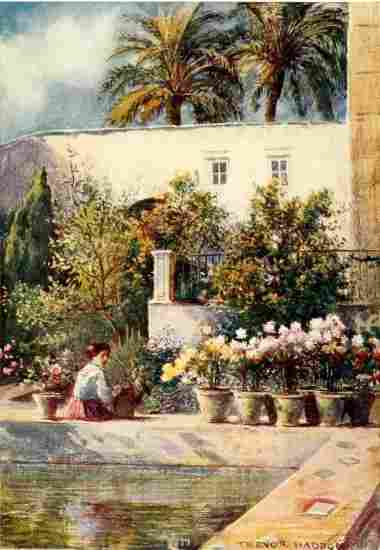
SEVILLE—GARDENS OF THE ALCAZAR
Crossing the Plaza del Triunfo, which lies between the Cathedral and the old Moorish walls, we enter the Patio de las Banderas, so called either because a flag was hoisted here when the royal family was in residence, or on account of the trophy, composed of the arms of Spain with crossed flags, displayed over one of the arches. Pedro was accustomed to administer justice, tempered with ferocity, after the Oriental fashion, seated on a stone bench in a corner of this square. The surrounding private houses occupy the site of the old Palace of the Almohades, and one of the halls—the Sala de Justicia—is still visible. It is entered from the Patio de la Monteria. Contreras assigns a date to this room even earlier than the advent of the Almohades. It is square, and measures nine metres across. The stucco ceiling is adorned with stars and wreaths, and bordered by a painted frieze. The decorations consist chiefly of inscriptions in Cufic characters. The right-angled apertures in the walls were closed either by screens of translucent stucco or by tapestries, "which must," says Gestoso y Perez, "have made the hall appear a miracle of wealth and splendour." It was in this hall, often overlooked by visitors, that Don Pedro overheard four judges discussing the division of a bribe they had received. The question was abruptly solved by the division of the disputants' heads and bodies. Thanks to its isolation, the Sala de Justicia escaped the dreadful "restoration" effected in the middle of the nineteenth century by the Duc de Montpensier. The house No. 3, Patio de las Banderas, formed part, in the opinion of Gestoso y Perez, of the Palacio del Yeso, or Stucco Palace, of Don Pedro.
Passing through the colonnaded Apeadero, built by Philip III. in 1607, and once used as an armoury, we reach the Patio del Leon, where tournaments used to be held, and stand in front of the Palace of the Alcazar. The façade is gorgeous yet elegant, of a gaudiness that in this brilliant city of golden sunshine and white walls is not obtrusive. Yet, despite the Moorish character of the decoration, the Arabic capitals and pilasters, and the square entrance "in the Persian style," the front is not that of an eastern palace; and it is without surprise that we read over the portal, in quaint Gothic characters, the legend: "The most high, the most noble, the most powerful, and the most victorious Don Pedro, commanded these Palaces, these Alcazares, and these entrances to be made in the year (of Cæsar) 1402" (1364). Elsewhere on the façade are the oft-repeated Cufic inscriptions: "There is no conqueror but Allah," "Glory to our lord the Sultan" (Don Pedro), "Eternal glory to Allah," etc., etc.
This is a very different entrance from that of the Alhambra, the building on the model of which the Alcazar was undoubtedly planned. From the entrance a passage leads from your left to one extremity of the Patio de las Doncellas, the central and principal court of the palace. How this patio came to be so named I have never been able to ascertain. There is an absurd story to the effect that here were collected the girls fabled to have been sent by way of annual tribute by Mauregato to the khalifa. Had such a transaction taken place, the tribute would have been payable, of course, at Cordova, not at Seville. Moreover this court was among the works executed in the fourteenth century.
The Alcazar strikes us (if we have come from Granada) as being on a much smaller scale than the Alhambra. It is very much better preserved, as it should be, seeing that it is a century younger; and if it vaguely strikes one as being fitter for the abode of a court favourite than of a monarch, it impresses one as being fresher, more elegant—in a word, more artistic—than the older building.
The Patio de las Doncellas is an oblong, and surrounded by an arcade of pointed and dentated arches which spring from the capitals of white marble columns placed in pairs. The middle arch on each side is higher than the others, and springs from oblong imposts resting on the twin columns and flanked by the miniature pillars characteristic of the Granadine architecture. The spandrils are beautifully adorned with stucco work of the trellis pattern. On the frieze above runs a flowing scroll with Arabic inscriptions, among them being "Glory to our lord, the Sultan Don Pedro," and this very remarkable text: "There is but one God; He is eternal; He was not begotten and has never begotten, and He has no equal." This inscription, opposed to the tenets of Christianity, was evidently designed by a Moslem artificer, who relied (and safely relied) on the ignorance of his employers. The frieze is decorated also, at intervals, by the escutcheons of Don Pedro and of Ferdinand and Isabella, and by the well-known devices of Charles V., the Pillars of Hercules with the motto "Plus Oultre." The inside of the arcade is ornamented with a high dado of glazed tile mosaic (azulejo), brilliantly coloured and with the highly-prized metallic glint. The combinations and variations of the designs are very ingenious and interesting. This decoration probably dates from Don Pedro's time. Behind each central arch is a round-arched doorway, flanked by twin windows. These are framed in rich conventional ornamental work. Through little oblong windows above the doors light falls and illumines the ceilings of the apartments opening into the court. The ceiling of the arcade dates from the reign of Ferdinand and Isabella, but was restored in 1856. A deep cornice marks the division of the lower part of the court from the upper storey, the front of which, with its white marble arches, columns and balustrades, was the work of Don Luis de Vega, a sixteenth-century architect.
Three recesses in the wall to the left of the entrance are pointed out as the audience closets of King Pedro; but they are much more likely to be walled-up entrances to formerly existing corridors and chambers behind.
The door facing this wall gives access to the Hall of the Ambassadors (Salon de los Embajadores), the finest apartment in this fairy palace. The doors are magnificent examples of inlay work, and were, according to the inscription on them, made by Moorish carpenters from Toledo in the year 1364. The hall is about thirty-three feet square, and exhibits a splendid combination of the various styles with the Gothic and Renaissance. The ornamentation is rich and elaborate almost beyond the possibility of description. The magnificent "half-orange" ceiling of carved wood rests on a frieze decorated with the Tower and Lion. Then come Cufic inscriptions on a blue ground and ugly female heads of the sixteenth century. Then, below another band of decoration, is a row of fifty-six busts of the Kings of Spain, from Receswinto the Goth to Philip III. These date, at earliest, from the sixteenth century. The wrought-iron balconies were made by Francisco Lopez in 1592. The decoration of this splendid chamber is completed by a high dado of blue, white, and green "azulejos." It was in this hall that Abu Saïd is said to have been received by his treacherous host.
The Hall of the Ambassadors communicated on each side with the patio and adjoining halls by entrances composed of three horseshoe arches, supported by graceful pillars and enclosed in a circular arch.
Through the arch facing the entrance from the patio we pass into a long narrow apartment, known as the Comedor, where the late Comtesse de Paris was born in 1848. To the north of the salon is a small square chamber, called the "Cuarto del Techo de Felipe Segundo," with a coffered ceiling dating from the time of that king. North of this room is the exquisite little Patio de las Muñecas (Court of the Dolls), purely Granadine in treatment. The rounded arches are separated by cylindrical pillars—I call them so for want of a better word—which rest on slender columns of different colours, reminding one of the early or Cordovan style. The capitals are rich, the pillars they uphold decorated with vertical lines of Cufic inscriptions, many of which, says Contreras, are placed upside down. The walls and spandrils are tastefully adorned with stucco work of the trellis pattern, tiling and mosaic. This court, though still harmonious and beautiful, suffered rather than benefited by its restoration in 1843; but the architecture has been not unsuccessfully reproduced in the upper storey.
This charming spot is by no means suggestive of deeds of blood and violence; yet, just as they point out the Salon de los Embajadores as the scene of the arrest of the Red Sultan by Don Pedro, so here do the guides place the scene of the murder of Don Fadrique by the truculent monarch—a fratricide to be avenged by another fratricide at Montiel. The Master of Santiago, to give the Don his usual title, after a successful campaign in Murcia, had been graciously received by his brother the king, and presently went to pay his respects in another part of the palace to the royal favourite, Maria de Padilla. It is said that she warned him of his impending fate; perhaps by her manner, if not by words, she tried to arouse in him a sense of danger, but the soldier prince returned to the king's presence. With a shout, Pedro gave the fatal signal. "Kill the Master of Santiago," he cried. Guards fell upon the prince. His sword was entangled in his scarf, and he was butchered without mercy. His retainers fled in all directions, pursued by Pedro's guards. One took refuge in Maria de Padilla's own apartment, and tried to screen himself by holding her little daughter, Doña Beatriz, before him. Pedro tore the child away, and despatched the unfortunate man with his own hand. The murder took place on May 19, 1358.
To the west of the court is a little room, elegantly decorated, and named after the Catholic Sovereigns, by whom it was restored. Their well-known devices appear, together with the Towers and Lions, among the decorations, which reveal the influence of the plateresque style. The north side of the patio is occupied by the Cuarto de los Principes, not to be confounded with a similarly named apartment on the floor above. At either end of this room is an arch, adorned with stucco work, admitting to a cabinet or alcove. That to the right has a fine artesonado ceiling, and that to the left is decorated in a species of Moorish plateresque style. An inscription states that the frieze was made in the year 1543 by Juan de Simancas, master carpenter.
East of the Patio de las Muñecas, and occupying the north side of the Patio de las Doncellas, is the long room called the Dormitorio de los Reyes Moros. All the apartments in the Alcazar are fancifully named, but the designation of none is quite so stupid and misleading as this. The columns of the twin windows on either side of the door appear to date from the time of the Khalifate. The doors themselves are richly inlaid and painted with geometrical patterns. The three horseshoe arches leading to the al hami, or alcove, also seem to belong to the early period of Spanish-Arabic art. The room is so richly decorated that scarce a handbreadth of the surface is free from ornament.
On the opposite side of the central court is the sumptuous Salon de Carlos V., the ceiling of which was constructed by order of the emperor, and is adorned with classical heads. The tile and stucco work is the finest in the palace. There is a legend to the effect that St. Ferdinand died in this room—on his knees, with a cord round his neck and a taper in his hand—but it is unlikely that this part of the palace existed in his time. The guide pointed out the room to the west of this salon as the chamber of Maria de Padilla, but this again is, to put it mildly, doubtful.
The upper chambers of the Alcazar, which are not accessible to the general public, are very handsome. The floor overlooking the Patio del Leon is occupied by the Sala del Principe, with its beautiful spring windows, polychrome tiling, and columns brought from the old Moorish Palace at Valencia. Adjacent is the Oratory, built by order of Ferdinand and Isabella in 1504. The tile work is of extraordinary beauty, and shows that the Moors had not a monopoly of talent in this kind of decoration. The fine Visitation over the altar is signed by Francesco Nicoloso, the Italian. On the same floor is the reputed bed-chamber of Don Pedro. Over the door may be seen four death's-heads, and over another entrance the curious figure of a man who looks back over his shoulder at a grinning skull. These gruesome designs commemorate the summary execution by the king of four judges whom he overheard discussing the division of a bribe. The royal apartments on this floor contain some precious works of art; but I abstain from mentioning the most remarkable of these, as pictures are so often transferred in Spain from one royal residence to another that such indications are often out of date before they are printed.
The Alcazar, I think, disappoints most foreigners. The architectural and decorative work of the Spanish Moors and their descendants pleases people quite inexperienced in the arts by its mere prettiness, its brilliance, its originality, and its colour; and it delights still more those who are able to appreciate its marvellous combinations of geometrical forms, its exquisite epigraphy, and all its subtle details. But the average traveller stands between these two classes of observers. He looks for grandeur where he should expect only beauty, and his eye is wearied by the wealth of conventional ornamentation. What I think is conspicuously lacking in the Alcazar, and to almost the same extent in the Alhambra, is atmosphere. Memories do not haunt you in these gilded halls. There is nothing about them to suggest that anything ever happened here. The legends tell us the contrary; but assuredly no one was ever less successful in impressing his personality on his abode than were the founders and inhabitants of the Alcazar.
The gardens are really the most pleasing spot within the enclosure. They form a delicious pleasaunce, where the orange and citron diffuse their fragrance, and magic fountains spring up suddenly beneath the passenger's feet, sprinkling him with a cooling dew. I noticed some flower beds shaped like curiously formed crosses, which the gardener told me were the crosses of the orders of Calatrava, Santiago, Alcantara, and Montesa. You are also shown the Baths of Maria de Padilla, which are approached through a gloomy arched entrance. In the favourite's time they had no other roof than the sky, and no further protection from prying eyes than that afforded by a screen of orange and lemon trees. In Mohammedan times the baths were probably used by the ladies of the harem.
But if the Alcazar is a disappointment to the majority of visitors, I cannot conceive the Cathedral being so, despite the unfavourable criticism to which it has been subjected. The exterior, it is true, is unimpressive, and the vastness of the pile is largely responsible for the powerful effect proclaimed by the interior. But when the worst has been urged, this, the third largest church in Christendom, remains a grand, a solemn, and a magnificent temple, thoroughly Christian in atmosphere and details.

SEVILLE—GARDENS OF THE ALCAZAR
I like the story of its foundation better than the silly tales about Don Pedro, or about crucifixes helping jilted damsels. It has, moreover, the very unusual merit of being true. After the conquest by St. Ferdinand the old mosque of the Almohades was "purified," and served as the cathedral till, towards the end of the fourteenth century, it became practically ruined by earthquakes. The dean and chapter took counsel together, and at a conclave held in the Court of the Elms, on the south side of the mosque, it was resolved to build a new church forthwith. Then uprose a zealous prebendary and cried: "Let us build a church so great that those who come after us will think us mad to have attempted it!" The proposal was adopted with acclamation; and the great-hearted priests bound themselves to contribute from their own stipends as much money as might be necessary, should the revenue of the See prove unequal to the cost of the undertaking. They could never hope to see the fruit of their labours. I do not think the name of any one of them has been preserved. The architect alike has been forgotten. All concerned sought only the greater glorification of their faith. Such greatness of spirit deserved a noble monument.[*]
[*] Instances of this lofty spirit are frequent in the history of the Spanish peoples. When, after their first uprising against the mother country, the people of Honduras (Central America) met in Congress to frame a Constitution, a priest rose and proposed that before anything else was done, every slave in the country should be set free. And the measure was carried unanimously and enthusiastically by the Congress, which must have included many slaveholders. It took the United States forty years to follow this example.
The Cathedral took one hundred and seventeen years to build, the first stone having been laid in 1402 and the lantern having been finished by Juan Gil de Hontañon in 1519. Of the mosque certain portions were left: the Giralda, the Patio de los Naranjos, and the portal called the Puerta del Lagarto. The latter is named after the wooden model of an alligator which hangs from the roof. Three or four centuries ago the mummified form of a real alligator hung there. It was one of the gifts of an Egyptian khalifa to the daughter of a Castilian king, whom he sought in marriage. The saurian was accompanied from the banks of the Nile by various animals peculiar to that fertile region, but these interesting offerings failed to make any impression on the heart of the Infanta. Thus the forlorn-looking effigy of the reptile is in reality an affecting memorial of unrequited love.
Churches, it has been remarked, were considered in the Middle Ages very proper repositories for curiosities of all sorts. The cloister of the Lagarto contains also an elephant's tusk, weighing seventy pounds, and a horse's bit, said to be that of Babieca, the Cid's charger.
Very grateful is the sudden cool of the great church when you enter it from the sun-scorched plaza. Then there comes over you a feeling of profound reverence, followed very soon by an infinite restfulness. There is no place in Seville where you more willingly linger. A holy calm pervades the whole building, and you wonder that it should have suggested to Théophile Gautier such fantastic comparisons. If it were not the temple of Christ, I could believe it to be the temple of Silence.
The Puerta del Lagarto is the favourite entrance, but when the day comes for a painstaking examination, you would do well to begin at one of the entrances in the west front. Of these there are three: the Puerta Mayor, the Puerta del Bautismo, and the Puerta San Miguel. All are enriched with good statuary, the graceful and vigorous statues of the side doors being the work of Pedro Millán, a fifteenth-century sculptor of renown. Entering, we set foot on the fine marble floor and make out the stupendous church to be composed of a nave and of two aisles on either side. The nave, you are told, is one hundred feet high and fifty feet wide. The noble columns, almost free of adornment, which uphold the spacious vaults recede in the far distance like trees in an overarching avenue. The effect, fine as it is, might have been much finer if the centre of the nave had not been blocked up by the choir. The "Trascoro," or screen, facing the west entrance, is richly adorned with red columns. Over the altar is a fourteenth-century picture of the Madonna, and a painting by Pacheco, the Inquisitor, representing St. Ferdinand receiving the keys of Seville. Over one of the beautiful little side altars of the choir is one of the rare examples of good Spanish sculpture—a Virgin, by Juan Martinez Montañez. On the altar side the choir is shut off by a sixteenth-century railing, attributed to Sancho Muñoz. This protects from intrusion their reverences the canons, who sit in stalls, exquisitely carved between the years 1475 and 1538. The patterns and coloured inlaid work of the backs reveal Moorish influence. The lectern was the work of Bartolomé Morel. When the lantern collapsed in 1888, the choir was severely damaged. The architect who restored the fabric proposed to move it considerably nearer the high altar, but the proposal was stupidly rejected. A good opportunity for improving the appearance of the Cathedral was thus lost.
The retablo of the high altar is the quintessence of late Gothic sculpture. It is a marvellous work of extraordinary delicacy and elaboration. Each of the forty-five compartments into which it is divided contains a subject from the Bible or from the lives of the saints, carved, painted, or gilded with the rarest skill. Begun by the Fleming Dancart, in 1479, this wonderful triumph of the carver's art was completed by Spanish artists in 1526. The earlier work is in the middle. Crowning it is a gilt crucifix and the statues of Our Lady and St. John.
There are some very interesting objects in the Sacristy, as it is called, between the reredos and the hind wall of the chancel. The sacristan will show you the reliquary, shaped like a triptych, which came from Constantinople and was presented to the old cathedral by Alfonso the Learned. The double folding door is also said to have come from the Moorish temple. With a glance at the fine terra-cotta statues by Miguel Florentin, Juan Marin, and others, we pass behind the chancel wall, and see before us the plateresque Royal Chapel, built by Charles V. over the remains of certain of his ancestors. Beneath the altar lies the body of St. Ferdinand in crown and royal robes. He lies here in the heart of his fairest conquest, even as his descendants, Ferdinand and Isabella, sleep in the heart of Granada. You may see his sword, the handle of which was denuded of gems by Pedro the Cruel, lest they should excite the cupidity of others. That royal humorist also lies here, near his saintly ancestor and the one woman whom he ever loved, the gentle Maria de Padilla. Then there is to be seen the Vírgen de los Reyes, an image presented by St. Louis of France to St. Ferdinand of Castile. (Strange that when saints filled the thrones of Europe, things went on no better than they do now!) Another relic highly prized is the Vírgen de las Batallas, an ivory statuette which St. Ferdinand used to carry at his saddle-bow. These memorials of the heroic past give you little time or inclination for an examination of the chapel itself, which has a lofty dome, and is flanked at the entrance by twelve good statues by Peter Kempener—whom Spaniards call Campaña. At least (so I read) he drew them on the wall with charcoal for a ducat each, and they were executed by Lorenzo del Vao and Campos in 1553.
This chapel and the reredos of the chancel must be called, I suppose, the great sights of the Cathedral, though to some its chief treasures will be the numerous works of Murillo enshrined in its chapels and dependencies. For myself, I like the building for its own sake, or, to use a very hard-worked word, for its atmosphere. As you cross the nave, looking upwards, where the light streams through the tall clerestory windows, you will be tempted to neglect the dark chapels in the aisles, and to revel for a while in these exquisite symphonies in coloured glass. Few of them are of Spanish workmanship. Master Christopher the German (Micer Cristobal Aleman) began the first—the first stained-glass window in Seville—in 1504, the work being afterwards carried on by the German Heinrich, the Flemings Beernaert of Zeeland and Jan Beernaert, Carel of Bruges, and Arnulf of Flanders. The best windows are those adorned with the Ascension, St. Mary Magdalen, Lazarus, and the Entry into Jerusalem, by Arnulf and his brother, and the Resurrection, by Carel of Bruges.
In the south transept is a monument, striking in itself and of very recent erection, which will in the course of time attract more pilgrims than the soldier saint's shrine. For here are contained the remains of a man who added not a Moorish city but a continent to the realm of Leon and Castile. The ashes of Christopher Columbus repose in a coffin which is borne on the shoulders of four figures of bronze, representing the kingdoms of Castile, Leon, Aragon, and Navarre.

SEVILLE—INTERIOR OF THE CATHEDRAL
These figures are not wanting in majesty and expression. All are crowned and wear semi-sacerdotal garb. Castile holds an oar, Leon a cross. Behind them come Aragon and Navarre, sombre of countenance, wearing shirts of mail. On the bosom of each is displayed the national escutcheon: the Towers of Castile, the Lions of Leon, the Bats of Aragon, and the Chains of Navarre. The pall bears words traced by Isabella herself:
| "A Castilla y Leon, |
| Nuevo mundo dió Colon," |
and round the pedestal is an inscription which relates how the body of the immortal Admiral of the Indies was brought here when the "ungrateful America" revolted from the Spanish yoke. But however much the Spain of to-day may honour Columbus dead, it is hardly for her to reproach any land with ingratitude towards him.
Half-way between the main entrance and the choir, the Great Navigator's son is buried. An inscription on a slab invites the reader to pray for the soul of Don Fernando Colon, who, as Ford very truly says, would have been considered a great man if he had been the son of a less great father. He rendered important services to literature, and left behind him a library of 15,000 volumes, including some manuscripts of extreme rarity. It was ultimately acquired by the Crown, and constitutes the basis of the Biblioteca Columbina, housed in the Patio de los Naranjos.
The Royal Chapel is flanked by two little chapels, one of which, dedicated to St. Peter, contains some Zurbarans, impossible to distinguish in the dim light; while in the other (Capilla de la Concepcion grande) is a fine monument of Cardinal Cienfuegos and a crucifix attributed to Alonso Cano. Opening on to the north side are the chapels del Pilar, de las Evangelistas, de las Doncellas, de San Francisco, de Santiago, de las Escales, and del Bautisterio. In the latter is one of Murillo's most famous works, "The Vision of St. Anthony of Padua." Of Cano's works there is a specimen, the "Virgin and Child," over the altar of Belen, adjacent to the Puerta de los Naranjos. Valdés Leal and Juan de las Roelas are represented in the chapel of Santiago, and Herrera the younger by an ambitious "Apotheosis of St. Francis" in the chapel of that saint. In the Capilla de las Escalas are two works of Luca Giordano, strong in drawing, colour, and character. The same chapel contains the fine tomb of Bishop Baltasar del Rio, dating from about 1500.
In the south aisle are the chapels of the Mariscal, San Andres, las Dolores, la Antigua, San Hermenegildo, San José, Santa Ana, and Santa Laureana. These chapels are richer in sculpture than in painting. Kempener designed the beautiful altar-piece in the Capilla del Mariscal, and Montañez the grand statue of St. Hermenegildo in his chapel. On the west side of the Puerta de San Cristobal, over a small altar, is the "Generacion" of Luis de Vargas—the much praised "leg" picture which has given its name to the chapel. The fresco of St. Christopher that faces it is remarkable only for its size. You find such pictures of the saint at the entrances to many Spanish churches, the old belief having been that those who gazed upon it would not die unpreparedly that day. A much more ancient and interesting mural painting in the Byzantine style is to be seen in the large chapel of the "Antigua," where it was placed in 1578. The retablo of St. Anne's Chapel is also very old, and comes from the former cathedral. The next chapel, San José, is adorned by Valdés Leal's "Espousals of the Virgin." The Cathedral does not contain any fine ancient tombs. One of the best is that of Archbishop Mendoza, by Miguel Florentin, in the Antigua Chapel.
As every visitor to Seville professes a special devotion to Murillo, he will probably overlook the fine "Nativity" by Luis de Vargas to the right, on entering, of the Puerta del Nacimiento, and hurry at once to the more famous master's "Guardian Angel," between Puerta Mayor and Puerta del Bautismo. His "St. Leander" and "St. Isidore" are to be seen in the great Sacristy, where they are eclipsed by Kempener's beautiful "Descent from the Cross," before which Murillo himself used to stand for hours in rapt contemplation. The French cut this priceless work into five pieces, intending to remove it, and although their design was frustrated, the subsequent restoration was badly effected. The Sacristia de los Calices is a storehouse of art treasures. Here you may see Goya's "Saint Justa and Saint Rufina," a "Trinity" by "El Greco," the "Angel de la Guarda" and "St. Dorothy" of Murillo, the "Death of a Saint" by Zurbaran, and the superb crucifix of Montañez. A "Conception" by Murillo is in the Chapter House, a splendid hall in the Renaissance style.
In the great Sacristy is preserved the "treasury" of the Cathedral. It includes a wonderful monstrance by that prince of goldsmiths, Juan de Arfe; and something more interesting in the shape of keys presented to St. Ferdinand on the surrender of the city. The key presented by the Jews is iron-gilt and bears the inscription in Hebrew: "The King of Kings will open, the King of all earth will enter." The key offered by the Moors is silver-gilt, and the Arabic inscription reads: "May Allah render eternal the dominion of Islam in this city."
Attached to many (if not to all) Spanish cathedrals, one finds large chapels which are the official parish churches of the cities—the parochial clergy being distinct from the diocesan chapter. At Seville, as at Granada, this chapel is called the "Sagrario," and is built at the west end of the Patio de los Naranjos and entered from a door in the north aisle of the Cathedral, near the Capilla del Bautisterio. Built between 1618 and 1662 by Miguel Zumarraga and Fernando de Iglesias, the church is in the Baroque style, and roofed with a single and very daring arch. The rich statues that adorn the interior are by Dayne and Jose de Arce. There is a notable retablo by Pedro Roldán that came from a Franciscan convent now suppressed. In one of the side chapels is a fine "Virgin" by Montañez. Beneath this church the Archbishops of Seville are now buried.
As we emerge from this vast temple, we remain for a few seconds dazzled by the sunlight. Then as we turn to the left we notice a rectangular, classic-looking building, standing between the Cathedral and the walls of the Alcazar. This is one of the numerous deserted Lonjas or Exchanges of Spain. The Patio de los Naranjos was formerly infested by the merchants and brokers of the city, to the great scandal of the devout. Archbishop de Rojas prevailed upon Philip II. to erect an Exchange or Casa de Contratacion, as Sir Thomas Gresham had just done in London. The building was begun in 1598, at precisely the moment when the commerce of Seville began to decline. It reflects the spirit of Philip II. and of his architect, Herrera—stern, sober, simple. There is a fine inner court, with Doric and Ionic columns. Here the South American archives are deposited, a rich mine for some future historian who shall have the patience to examine them. As an exchange, the Lonja soon proved a failure. It was early deserted by business men, and is best remembered as the seat of Murillo's Academy of Painters.
The spacious days of Charles V. and Philip II. were productive of innumerable public buildings, mostly in a quasi-Roman style and all very pompous and oppressive. The Town-hall or Ayuntamiento of Seville is an extremely ornate structure, in what is called the plateresque or Spanish Renaissance style. It stands in the Plaza de la Constitucion, where the electric cars perform intricate evolutions. Its effect is lost through its being placed on the ground level, without terrace, steps, or approach, or even railings to prevent inquisitive urchins staring in at the windows. The building is long and remarkably narrow, and of two storeys. I have seldom seen a public building more elaborately adorned or more badly placed. The interior is more satisfactory. The lower council chamber is a magnificent hall, worthy, as a Spanish writer remarks, of the Senate of a great republic. A noble staircase, with a fine ceiling, leads to the upper council chamber, which has some splendid artesonado work. Opposite—that is, on the east side of—this building is the Audiencia or Court-house, where I whiled away a hot afternoon by assisting at a Spanish trial. The case was of no particular interest, but the differences in the procedure and constitution of the court from our own were worth noting. There were three judges, who wore black silk gowns, without wigs or bands. Over their heads was the arms of Spain, and on the desk, facing the president, a large crucifix. The jury sat on chairs on each side of the judges. A desk was reserved for the public prosecutor, another for the prisoner's advocate. The judges took far less part in the proceedings than they do in France. The case seemed to be left entirely to the public prosecutor, who, it is just to say, allowed the accused to make long rambling statements, without the least attempt to interrupt or confuse him. The public at the rear of the court appeared to take far more interest in the proceedings than any immediately concerned in them.
The Plaza de la Constitucion, outside the court, is the place of execution. But the death penalty is very rarely inflicted in Spain. Two or three years ago the Crown could find no pretext for pardoning two particularly atrocious murderers, who were accordingly put to death by the garrote in this square. The people of Seville, not being accustomed like the more enlightened Britons to some two dozen executions a year, showed their sense of the awful occurrence and of the disgrace to their city by donning the deepest mourning.
But the stranger does not come to Seville to visit courts or to hear about public executions—unless these happened two or three centuries ago, when as Sir W. S. Gilbert somewhere observes, they are looked at through the glamour of romance. The searcher for the beautiful is usually rewarded here by finding it in unexpected corners of the monotonous labyrinth of lanes and alleys. Plunging into the maze of white-walled dwellings in the north-eastern quarter of the city, a minaret only less beautiful than the Giralda seems to beckon us from afar. It appears and reappears, and we lose our way a dozen times before we stand at its foot. It is a beautiful tower in the purest Almohade or Mauritanian style, without any features borrowed from Christian architecture. The highest edifice, this, in Seville, except the Giralda. From its summit Cervantes used to scan the streets below, at certain hours of the day, for the form of a local beauty of whom he was enamoured. Here, of course, stood a mosque in Mussulman days, on the site of the adjacent church of San Marcos. The portal is very fine, but the Moorish features are the work of Mudejar and not Almohade artisans.
We wander on, and are presently surprised by the superb frontal of the convent church of Santa Paula. It is faced with white and blue azulejos, the work of Francesco of Pisa and Pedro Millán. Over the arch are disposed seven medallions illustrating the birth of Christ and the life of St. Paul, the figures white on a blue ground. On the tympanum of the arch is displayed the Spanish coat of arms in white marble, flanked by the escutcheons of the inevitable and ubiquitous Ferdinand and Isabella. Having seen this, it is hardly worth our while to enter the church, which contains the tombs of the founders, Dom Joao de Henriquez, Constable of Portugal, and his wife Donha Isabel. In the same quarter of the city, though some distance away, is a monument of some interest—the church of Omnium Sanctorum, built in 1356 on the site of a Roman temple. Here again there is a tower graceful enough, in its lower storey recalling the Giralda. The church exhibits a rather happy combination of the Moorish and Gothic styles. On one of the doors is the coat of arms of Portugal, commemorating the pious generosity of Diniz, king of that country. This must have belonged to the earlier structure.
Finding your way back to the Sierpes, you may inspect the interesting Church of the University. Here repose the members of the illustrious Ribera family, which looms very large in the history of Seville. Their remains were brought hither on the suppression of the Cartuja, outside the town. The oldest tomb is that of the eldest Ribera, who died in 1423, aged 105. He thus lived through the reigns of Alfonso XI., Pedro the Cruel, Enrique II., Juan I., Enrique III., and Juan II., yet, as is usually the case with centenarians, he failed to engrave his name as deeply on history as did some of his shorter lived descendants.
The famous Duke of Alcalá, the owner of the Casa de Pilatos, is commemorated by a fine bronze effigy—one of the few sepulchral monuments of this kind in Spain. At the feet of Don Lorenzo Figueroa a dog is sculptured, most probably the symbol of fidelity, but some say, his favourite. Over the altar are three good pictures by Roelas, one of the ablest interpreters of the Andalusian spirit. Here, too, are a couple of works by Alonso Cano, "St. John the Baptist" and "St. John the Divine." The statue of St. Ignatius Loyola by Montañez is said to be a faithful likeness of the saint. It was coloured by Pacheco the Inquisitor.
The adjacent University was originally a Jesuit college, and was built in the middle of the sixteenth century, after designs by Herrera. It is not very well attended to-day, and from the outside would be taken for an inconsiderable college. It seems to have been much more flourishing a hundred years ago, when our countryman Blanco White attended its courses. The original university was founded by Canon Rodrigo de Santuella in 1472, in the Colegio Maese Rodrigo, near the Cathedral.
From the last resting-place of the Riberas in the centre of the town it is not far to their old home, the Casa de Pilatos, though Dædalus himself might easily get lost in this labyrinth of streets resembling each other as closely as those of an American city. The names of some of these thoroughfares—Francos, Gallegos, Genovés—remind us of the days of St. Ferdinand, when the room of the banished Moors was filled by settlers, not only from all parts of Spain, but from the rest of Europe. It was the same with all the towns resumed by the Spaniards. These foreign colonies had their own laws and customs, and yet they were entirely absorbed by the natives and left no trace or influence behind them. The Spaniards possessed, in those days at any rate, the same wonderful capacity for the absorption of other races displayed by the Anglo-Saxons in America. There was nothing new in this; for they had absorbed the Visigoths, just as they had absorbed the Romans before them. The Castilian tongue is indeed Latin, but I fancy that the people of Spain are as much the children of the soil—autochthones—as the Athenians themselves.
Reflections like these—which I do not expect will profoundly influence ethnologists—occupied me as I pursued my tortuous course to the Casa de Pilatos. When I at last found it, I was struck by the plain and dignified exterior. To the left of the door I observed a plain cross of jasper. The story goes that in October, 1521, the Marquis de Tarifa, on his return from a pilgrimage to Jerusalem, placed this cross against the wall and counted thence the fourteen stations of the Cross, according to their order in the Holy City. The last fortuitously coincided with the Cruz del Campo, raised near the Caños de Carmona in 1482. I doubt if the marquis had any such thought when he raised this jasper cross, for the distance from the Prætorium at Jerusalem to the chapel in the Church of the Holy Sepulchre that marks the site of Calvary is greatly less than the distance between the two points mentioned here in Seville. But why the house was called after Pilate is not easy to determine. It was begun in 1500 and finished thirty-three years after by Don Per Afan de Ribera, first Duke of Alcalá, and sometime Viceroy of Naples. This great nobleman was the Mæcenas of his generation. Not only did he enrich his house with priceless works of art and a fine library—since removed to Madrid—but he made it the rendezvous of all the art and talent of Andalusia. Hither came Gongora, the poet, to converse, it is said, with Cervantes. Here Pacheco, the artist-inquisitor, discussed the mission of art with Herrera. Here came Rioja, Cespedes, Jauregui, and others of less note. The example set by the Medici was followed by many of the great grandees of Spain at this time. The Velascos presided over a coterie of literati at Burgos; the Duke of Villahermosa, at Zaragoza, affected to delight in the company of the brilliant and learned. Even so small a place as Plasencia had its own patron of the arts in Don Luis de Avila, and in Madrid there was "the feast of reason and the flow of soul" at the mansion of Don Antonio Perez. But for all its associations, like the Alcazar, the Casa de Pilatos remains very much like a museum.
The building illustrates the fashion of the Mudejar and Renaissance styles, almost to the effacement of the former. In the architecture of this epoch we usually find an Arabic groundwork nearly concealed by ornament of the newer style. The geometrical designs remain, but the flowing inscriptions, so important a feature of Moorish decoration, have gone. A thousand details would show the veriest tyro that this was not the work of Moors, yet the central court bears a general resemblance to the Alcazar. Pedro de Madrazo directs attention to the harmonious variety of the arches and windows, and compares it to the admired disorder of the forest and plantation. I imagine the architect had the Court of the Lions, at Granada, in his mind. Here dolphins uphold the upper basin of the fountain, and noble statues of the deities of Greece and Rome—the gift of Pope Pius V.—stand in the angles of the court. Hence you pass into the so-called Prætorium, with its splendid coffered ceiling and beautiful tiling, where you may distinguish the Spanish azulejos of the best moulds by the designs stamped on them of fanciful monsters, grotesques, and escutcheons. Then there is the superb staircase with its "half-orange" ceiling, and the chapel with its mixed Gothic and Mudejar features. What grandee in Europe has a finer home than this? And yet, I am told the owner, His Grace of Medinaceli, comes here but seldom.
There are many old mansions in Seville worth a walk on a cool day—and a glimpse. They are not great sights, such as those we have already seen in the city, or such as are more numerous in Paris and Rome, Brussels and Venice. But those visitors who are really interested in Seville, and are capable of appreciating Moorish and plateresque art in their various imitations and combinations, will enjoy these little excursions. There is an interesting old house at No. 6, Abades. It is now a boarding-house, and you may live there in princely fashion for six francs a day. No one knows how old it is. It belonged at the beginning of the fifteenth century to a family of Genoese merchants called Pinelo. In 1407 the Infante Fadrique, uncle of Juan II., lodged there. What was the occasion of his visit to Seville I forget. Afterwards it became the property of the "abbés" or "abades" of the Cathedral. Many of these reverend gentlemen still patronize the establishment, and may be seen puffing their "Puros" in the court, which is said to be a fine example of the Sevillian Renaissance style. That style I conceive to have been compounded of all pre-existing styles. Digby Wyatt, however, considered the house to be much more Italian than Spanish. It is a vast place, where dark corridors seem to lead indefinitely into space.
There is rather less to reward your curiosity at the Palacio de las Dueñas, a vast mansion belonging to the Duke of Alba. Once it boasted eleven "patios," with nine fountains and one hundred columns of marble. A fine court, surrounded by a graceful arcade, remains. The staircase recalls that of the Casa de Pilatos. Our countryman Lord Holland stayed here a hundred years ago. He was a great admirer of Spanish literature at a time when it was hardly as much a matter of interest to foreigners as it is at present.
Then there is the Casa de Bustos Tavera, where, according to Lope de Vega, Sancho the Brave used to visit the "Star of Seville"; and the Casa Olea, in the Calle Guzman el Bueno, with a hall of Mudejar workmanship dating from the days of Don Pedro.
It is the romantic aspect of Seville that has impressed some visitors much more than its historical or archæological side. Over the poets and dramatists of the Romantic school the city exercised a strange fascination. Byron and Alfred de Musset found the atmosphere of the place most congenial. Through their rose-coloured spectacles every girl they met in these narrow white streets seemed "preternaturally pretty." The principal business of the inhabitants in the 'twenties and 'thirties of last century, to judge by the French poet's descriptions, was love-making, strumming the guitar, and duelling. That Spain was ever a romantic country in the vulgarly accepted sense of the term, I doubt. Roman Catholic customs and institutions forbid that free intermingling of the sexes from which result the thousand and one emotions, complications, situations, and catastrophes that are the ingredients of romance. In countries like Spain, where the canon law obtained, there could be, for instance, no runaway matches, no desperate flights in a post-chaise to a church (say) over the Portuguese border, with an irate father in pursuit. There could not have been, and cannot be at the present time, any walks with the beloved down the moonlit grove, any trysts by the stile or the ruined keep, any rendezvous among the rose-bushes. If a Spanish girl did any of these things, she would indeed, in French parlance, have thrown her cap over the mill. The affair would no longer have the complexion of a romance but of a sordid intrigue. This being so, I was delighted to hear that occasionally clandestine marriages are resorted to in Spain, and that fond lovers find a means of uniting in defiance of stern parents, even in Andalusia. The couple, accompanied by a few friends, contrive to sit next to each other in church, as far out of sight of the rest of the worshippers as possible. Their troths are plighted in an undertone just loud enough for the witnesses to hear, the ring slipped on under cover of the mantilla, and the hands joined at the precise moment the all-unconscious celebrant turns towards the congregation at the end of the mass and pronounces the benediction. In the eyes of the Church the two are married as irrevocably as if the Cardinal Lord Archbishop of Toledo had performed the ceremony. The vows have been exchanged before witnesses in a sacred edifice, and an anointed priest has simultaneously blessed the contracting parties from the altar. What can parents do? The Don may rage, the Doña may upbraid, but when the Church makes itself an accomplice of lovers, even in Spain the law must acquiesce. And there is no divorce!
That genuine romance tinges the lives of Spanish men and women, few who know them can doubt. But the Andalusia of musical comedy, the creation of which is largely due to the poets of the Romantic school, does not exist. Seville never was a glorified Cremorne; and persons of a Byronic turn would find adventures suitable to their mood more readily by the banks of the Thames and the Hudson than by those of the Guadalquivir.
For all that, some romantic stories are told about old Seville, and one of these has some foundation of truth. About the middle of the seventeenth century, the city re-echoed with reports of the wild and desperate doings of a certain wealthy gallant, Don Miguel de Marana by name. By some he is called De Mañara. Marriage with the heiress of the Mendoza family did not sober him, though an alliance with so solemn a thing as money generally brings the most hot-headed Latin youth to his senses. Like many other wicked persons, our gallant had a nice taste in art, and is said to have encouraged Murillo. Now comes the remarkable and the improving part of the story. It is not safe to vouch for the accuracy of the details of any part of it. One morning Seville woke up to find—no doubt to her unspeakable consolation—the wicked De Marana a changed man. He became a saint—an ascetic in the seventeenth-century acceptation of the word. The wine-bibber forswore even chocolate as too strong a beverage.
What had happened to produce so edifying a change? Accounts vary. The most picturesque explanation is that the Don, prowling about the streets one night, perceived a funeral procession approaching. Curiosity impelled him to look at the face of the corpse, which was uncovered, and lo! it was his own.
If you doubt the sincerity of Don Miguel's conversion, you have only to visit the Church of La Caridad, which, together with the adjoining hospital, he founded and wherein he was buried. I do not think you will share the opinion of Sir W. Stirling-Maxwell that this is the most elegant church in Seville, but you will be rewarded for the visit by seeing some very remarkable works of art. Near the entrance are the two extraordinary pictures which proclaim the artist, Valdés Leal, to have been a master of realism. One of these exhibits a corpse at which, Murillo declared, you must look with your nostrils shut. The church contains six canvases by Murillo himself—"Moses Striking the Rock," "The Miracle of the Loaves and Fishes," "The Charity of St. Juan de Dios," "The Annunciation," "The Infant Jesus," and "St. John." The third is really the finest of these pictures, though the first, commonly called "La Sed" (Thirst), is the most generally preferred. The figures are, as usual in this master's compositions, ordinary Seville types. Over the altar is another great work, "The Descent from the Cross," by Pedro Roldán.
The "Caridad" has indeed the most important collection of pictures in southern Spain, next to the Museo, as the old Convent of La Merced is now called. There, of course, some of the greatest works of art by Spanish masters are to be seen. There you may see the "St. Thomas of Villanueva" giving alms, Murillo's favourite picture; his beautiful "St. Felix of Cantalicio," and "St. Leander and St. Buenaventura," and his famous "Vírgen de la Servilleta" which was not painted on a serviette. On the south wall hangs his "Saints Justa and Rufina" (holding the Giralda), exquisitely coloured, and on the north wall the admirable "St. Anthony de Padua." But one grows a little weary of Murillo in Seville. Zurbaran, the great painter of monks, is well represented by the wonderful "St. Hugh in the Refectory," and "Apotheosis of St. Thomas Aquinas." This last picture, I am told, was carried off by Soult, and recovered by Wellington at Waterloo. The older Herrera's "St. Hermenegild" is good, but by no means Andalusian. The native temper finds more truthful expression in the works of Roelas, Valdés Leal, Cespedes and Frutet, which may be studied to the best advantage here. Curiously enough, the gallery contains not a single work by Velazquez, who was born in Seville; nor any paintings by Alonso Cano or Luis de Vargas. Spanish sculpture, of which one sees so little, is not unworthily represented by a beautiful St. Bruno by Montañez, and by some busts and crucifixes of less importance. The students of Andalusian art must also visit the Hospital de la Sangre, near the Macarena Gate, for some splendid works by Zurbaran and by his less-known forerunner Roelas. The three pictures ascribed to the last named are, however, very awkwardly placed and difficult to see.
Murillo's house is still standing in the Plaza de Alfaro in the old Ghetto. Here he died on April 3, 1682, after his fall from the scaffolding at Cadiz. His studio is shown filled with several undoubted works of his brush. The house belongs to the executors of the late Dean Cepero.
The Duke de Montpensier has a fine collection of pictures at his ugly Palace of St. Telmo, near the Torre del Oro. Among them is included a sketch by our late Queen, when she was still a princess. The palace looks on a parade which is much resorted to by the Sevillanos in the summer months. Here you see the boys playing at the inevitable bull-fight. One who takes the part of toro has a real bull's horns with which he "gores" his comrades with great ferocity. The insistence on this brutal "sport" among the Andalusians has taken the form of acute monomania. Exasperated strangers have been heard to declare that in southern Spain you hear of but two things—Toros y Moros. In another corner of the promenade, you will come upon a party of little girls going through the peculiar and stately dances, or rather measures, of their country, to the accompaniment of a low chant and a clapping of hands, in which the boys, looking on from a distance, will join. Boys and girls, unless they are quite babies, are seldom seen together. You pass on and find a group of citizens seated at the little tables round a kiosk, refreshing themselves with lemonade and being entertained by a conjuror—a fine-looking man—who sends round the hat after every two or three tricks. In the ordinary way you are asked for alms more often than in Granada, but not, of course, to anything like the same extent as in London. English travellers are given to commenting on the mendicity in foreign cities, but I must confess that nowhere have I met with so many beggars as in our own capital. In Spain the fraternity chiefly haunt the steps of churches, the one spot in our happy country that they seem to avoid.
We reach the beginning of the Delicias Gardens, which extend two or three miles southward along the river bank. All the rank and fashion of Seville—and a great deal besides—turns out in summer evenings to drive in the Delicias. The concourse of vehicles is immense, but reminded me rather of the return from the Derby than of Rotten Row. The great ambition of the Spaniard is to possess a conveyance, and he seems to care little how dilapidated or ancient it may be, so long as it goes on wheels. Side by side with the handsome equipages of the Sevillian aristocracy, you will see a wretched Rosinante painfully dragging what I took to be the original "one-hoss shay," or the carriage in which Lord Ferrers was driven to the scaffold. It is impossible to restrain a smile, but after all a conveyance is a real necessity in a climate like this, and if a man cannot afford a good carriage, he must needs put up with a bad one. The traffic is well regulated by mounted police. The foot-paths are also crowded, and when night falls, everyone adjourns to the numerous open-air cafés and kiosks to drink light beer and lemonade. Sober, steady Spain! How certain of our reformers at home would love you, if they but knew you! Where in the world (except in the East) are men more abstemious or women more staid and demure?
If you wish (as of course, being a modern traveller, you are sure to do) to study the life of the people, you had better betake yourself to the other end of the city—to the Alameda de Hercules, so called after two columns which the natives believe were presented by that muscular demigod. Here a perpetual fair seems in progress. There are the usual booths, with fat ladies, boneless wonders, and dwarfs, and more questionable exhibitions. On a platform sat three depressed and underfed wretches, who, I thought, were to be immediately garrotted. Suddenly one sprang up and gave a very clever rendering of the arrival and departure of a train at a country station. He was vociferously applauded, and, thus encouraged, danced a sort of "cellar-flap" with great animation to the indispensable accompaniment of hand-clapping. In a popular assembly of Andalusian town and country folk, the modern observer ought, I am well aware, to find many extraordinary and significant phases of humanity, exhibiting the striking individuality of the people, their race-consciousness, their psychological import, their evolutional significance, and so forth. I blush to confess that in the crowds applauding the ventriloquist or gaping at the fat lady, I saw only a collection of good-humoured ordinary people, enjoying themselves much after the fashion of ordinary people in England.
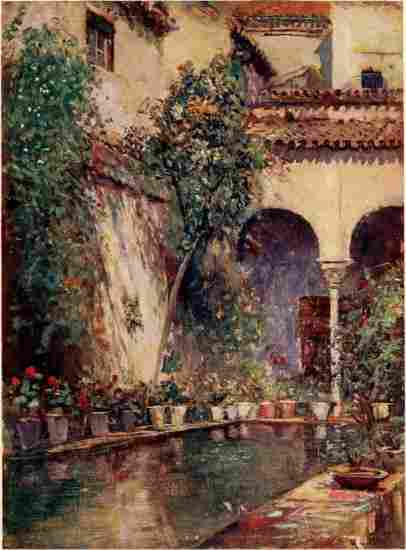
SEVILLE—GARDEN OF THE CASA DE PILATOS
Perhaps the Sevillano is more his real self on these occasions than when disporting himself at the world-famous fair, which begins on the Monday after Easter and attracts strangers from all parts of Europe. Though a somewhat overrated festival, I think it more distinctive and original in certain of its aspects than the gorgeous religious ceremonies by which it is preceded. The wealthier families of Seville rig up for themselves on the fair-ground "casetas," or temporary residences of wood or canvas, with two or more apartments. A great deal of expense is lavished on the upholstering and decoration of these pavilions, and those of the four principal clubs are fitted up in the most luxurious fashion. In the evening the jeunesse dorée of the city drive out to the fair in smart traps drawn by dashing little horses with jangling little bells, and visits are exchanged at the casetas, where as the evening becomes cooler, dancing takes place, to the sound of the piano, the guitar, and the castanet. The pretty señoritas of Seville have no objection to going through the graceful measures of the South in full view of an uninvited audience who crowd round the opening of the tent and from time to time give vent to admiring "Olés!" and bursts of hand-clapping. Dancing will be interrupted at 8.30, when everyone comes out to look at the firework display. Then of course there are the usual popular amusements—the inevitable bioscope, the gramophone, and all sorts of shows. Peasantry and aristocracy alike dress their very best on this occasion. The smartest toilettes and the most picturesque of native costumes are seen side by side, the latest confections of Worth and Paquin and costly heirlooms handed down from the days of Boabdil and Gonsalvo de Cordova.
Whether such an intermingling of all classes, of the richest and the poorest, could take place with mutual enjoyment and comfort in any country but Spain, is a matter open to doubt.
The object of the fair is, I believe, the sale of cattle, and about eighty thousand beasts are to be seen on the Prado de San Sebastian. To say that the most sanguinary bull-fights complete the festivities is perhaps superfluous. The most skilful and renowned toreros are engaged on this occasion, and the arenas literally smoke with the blood of bulls and disembowelled horses. Smithfield and Deptford can show nothing in comparison.
The religious ceremonies, of which travellers talk so much, are not for the most part peculiar to Seville, as it ought to be unnecessary to remind them. The tableaux in the processions struck me as theatrical, but as being on the whole as well represented as similar show-pieces in our pageants. The famous Dance of the Seises is reserved for the octaves of the Immaculate Conception and Corpus Christi. It has been described over and over again. There is nothing irreverent about the performance, which is in itself graceful and quaint; only carried out before the high altar it strikes one as rather meaningless. So, I suppose, most such functions impress those who are unprepared for them by temperament and education. There cannot be much doubt that the ceremony originated in an attempt to attract the ungodly to church—an early and respectable precedent for the methods of the Salvation Army.
Others have it that the dance is a survival of some pagan ceremony—which will remind us that we have so far neglected the monuments of the Romans which were bequeathed to Seville. These are not very numerous or interesting. Only a fragment remains, at the north-east angle of the city, of the massive wall which Cæsar built, and which completely girdled Seville as late as the reign of Juan II. It was strengthened, tradition tells us, by 166 towers, which were freely used as prisons by later rulers. The Cordoba Gate marks the site of the dungeon of the canonized Hermenegild. Close to it is the Capuchin Convent, built upon the foundations of the palace of the Roman governor, Diogenianus, and afterwards associated with Murillo. A noble aqueduct built by the Romans, and known to-day as the Caños de Carmona, still brings water from Alcala de Guadaira to Seville. Everyone who visits Seville is expected to make an excursion to the ruins of Italica, a few miles on the other side of the Guadalquivir. There is remarkably little to see when you get there, and not much is known about the place. There were few, if any, private dwellings here, and it existed rather as the place of meeting and distributing centre for the colonists scattered over the district. It was indeed raised to the dignity of a municipality by Augustus, but petitioned to be restored to its old rank of a Roman colony. It did not prove unworthy of its connection with the great capital. Hence sprang the illustrious line of the Ælii, and many of the eminent Roman Spaniards who conferred such lustre on the early empire are believed to have been natives. The town was embellished in those palmy days with temples, palaces, amphitheatres, and baths, quite out of proportion to its population.
Its downfall, like its earlier history, is mysterious. Here Leovigild placed his headquarters when besieging Seville. Then came the Arabs, who dismantled it and carried off columns and blocks of masonry on which are founded the Giralda and other important buildings in the neighbouring city. Italica disappeared from history; and all you can see of it to-day is a few remains of walls and earthbanks outlining the amphitheatre.
It might not be worth the journey were it not that it can be included in an excursion to the villages of Santi Ponce, Castilleja la Cuesta, and the Cartuja. The parish church of the first named wretched village is remarkable as the last resting-place of the illustrious Guzman el Bueno, that Spaniard of the Roman mould who refused to save the life of his son at the cost of the fortress of Tarifa, which he held for his king. The hero's kneeling effigy dates, as the inscription beneath informs us, from the year 1609, the three hundredth anniversary of his death. The modern traveller, whose sympathies are usually more with the æsthetic than the heroic, will be more interested in the lifelike St. Jerome, one of the finest works of Montañez, to be seen over the high altar. The saint, regarding a crucifix devoutly, beats his breast with a stone. On either side are beautiful bas-reliefs of the Nativity and the Adoration of the Magi.
The convent was inhabited first by the Cistercians, next by the Hermits of St. Jerome. It presents rather the appearance of a fortified abbey of the middle ages. The church is divided into two naves, each of which was a distinct church—one, I suspect, belonging to the monastery, the other to the parish; a not uncommon medieval arrangement. I almost forgot to add that it contains the ashes (literally) of Doña Urraca Osorio, a lady burnt to death, as I have said, by Pedro the Cruel.
At Castilleja la Cuesta—a village on the height—is the house where Hernando Cortes died in 1547. The house has been converted by the Duc de Montpensier into a sort of museum. The Conquistador's bones repose in the land which, with so much intrepidity and ruthlessness, he won for Spain.
The old Charterhouse or Cartuja is now occupied by the porcelain factory of Pickman & Co. It lies on the west bank of the Guadalquivir, a few minutes' walk from the railway bridge. It was founded in the first decade of the fifteenth century by Archbishop de Mena, and was the burial-place of the Riberas, till their remains were transferred to the University Church. There is little to see except some stalls carved, if I remember aright, by Duque Cornejo, in the little chapel.
You may return to the city through the transpontine quarter of Triana, a collection of whitewashed houses inhabited chiefly by gipsies. To distinguish these no longer nomadic Bohemians from the lower-class Andalusians around them is not an easy task. As at Granada, gipsy dances are got up by the guides and hotel people, and here, I am told, they possess the merit which a Frenchman denies to those of the other city—impropriety. The patron saints of Seville, Saints Justa and Rufina, were potters in this quarter. In their time the Carthaginian goddess, Astarte or Salambo, was much venerated in the Roman city. The commemoration of the death of Adonis took place in the month of July, when the image of the goddess was borne in triumph through the streets, while the people following with cries and lamentations deplored the untimely end of her beloved. A strange survival, this, on soil so far to the west, of the hideous Punic rites! The two maidens, newly converted to the religion of the Crucified, refused to do reverence to the image as it was carried past, and were haled before the governor, Diogenianus, in his palace by the Cordova Gate. They were put to death in due course, and have received more honour since from architects, sculptors, and painters, than Venus-Astarte in all her glory received from her devotees.
Before leaving Triana, visit the Church of Santa Ana, to see the exquisite Madonna of Alejo Fernandez, whom Lord Leighton considered the most conspicuous among the Gothic painters. There is a regard for beauty in the figures, not by any means obtrusive in most of the paintings of the period, though the awkward pose of some of the angels shows that the artist had not quite emancipated himself from Byzantine influence. And the thought occurred to me as I made my way back to the Delicias Gardens, where the people were driving out to take the air, and knots were collecting round musicians and mountebanks—when the whole city was yielding itself up to the sensuous charm of the summer night—that the art of Fernandez was expressive of Seville: of a people in whom the sense of beauty and the joy of living cannot be extinguished, though at the call of religion they reluctantly keep their faces half turned towards sad facts and yet more sombre unrealities.
CHAPTER III
CORDOVA
| "They say the Lion and the Lizard keep |
| The Courts where Jamshyd gloried and drank deep." |
THE sands of Asia are strewn with the ruins of cities once the gorgeous capitals of mighty empires. Here in Spain the followers of the Prophet raised a metropolis as splendid as any of the new Babylons of the East; and its fall has been wellnigh as great as theirs. We need not credit all the assertions of the Arabian writers (for the scribes of that nation, as Cervantes remarks, are not a little addicted to fiction). We can hardly believe that Cordova in its prime contained 300,000 inhabitants, 600 mosques, 50 hospitals, 800 public schools, 900 baths, 600 inns, and a library of 600,000 volumes; but there is evidence enough to satisfy us that this was in the tenth century the most magnificent and populous city in Europe, Byzantium alone excepted. Now it is a small provincial capital, bright, white, and coquettish, utterly without the solemnity and majesty which should invest the seats of vanished empires. Here greatness has been swallowed up in insignificance, not in desolation. The Court of the Khalifas, the Western Mecca, does not lie in lordly ruin like a fallen Colossus, but has sunk into mere pettiness.
Victor Hugo draws, as only he knew how, in a couple of lines, a picturesque sketch of Cordova, but this hardly corresponds to the impressions of the modern traveller. The houses may be old (some of them certainly are), but in their coats of dazzling whitewash they look brand-new. Gautier very sensibly remarks that, thanks to whitewash, the wall which was erected a century ago cannot be distinguished from that which was erected yesterday. Its general application "imparts a uniform tint to all buildings, fills up the architectural lines, effaces all their delicate ornamentation, and does not allow you to read their age." Cordova, which was formerly a centre of Arabian civilization, is now nothing more than a confused mass of small white houses, above which rise a few mangrove trees, with their metallic green foliage, or some palm trees with their branches spread out like the claws of a crab; while the whole town is divided by narrow passages into a number of separate blocks, where it would be difficult for two mules to pass abreast. Such is Cordova to-day, and I doubt very much if its external aspect was a whit more splendid or by any means as pleasing in the days of its glory. Some authors write as if they imagined the Mohammedans built their capitals on the lines of Paris and Washington. A visit to Constantinople or to Cairo would remove that impression. Imagine Cordova covering three or four times its present area, its windows obscured with lattices, its walls less white, its streets filled with a noisy mob of beshawled and beturbaned men—black, brown, and white—with noble mosques and elegant minarets here and there, and you will have a fair picture of the capital of the Western Khalifate.
Of its outward seeming only. Its culture and refined social life merited for Cordova the title of the Athens of the West. When all Europe was sunk in barbarism, medicine and chemistry, the natural sciences, the arts and philosophy, all found a refuge here. Culture was diffused through all classes of the population, if only very superficially, to an extent never perhaps equalled elsewhere. And though there was little initiative or originality about the scholars at Cordova, their labours contributed to keep alive a taste for the humanities which otherwise would never have revived in Europe. The comforts and amenities of life were carefully studied in the Western Khalifate. All the products which minister to luxury were at that time the almost exclusive property of the Moslem world, and to the bazaars of Cordova were brought the choicest spoils of Egypt, Persia, Arabia, and Hindostan. And at the head of this urbane and flourishing commonwealth sat the great Umeyyad khalifa, emulous of the glories of Bagdad and Cairo, and eager to surpass them in elegance and splendour.
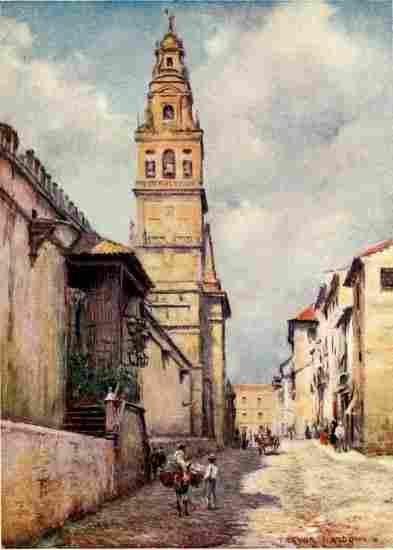
CORDOVA—CALLE CARDINAL HERRERA
Of those great days all that remains is the Mezquita—and that is much. Next to St. Peter's it is the largest of Christian temples, and certainly among the most ancient. As a Mohammedan place of worship, it ranked in sanctity with the Mosque of Omar at Jerusalem, immediately after Mecca, which it was indeed designed to eclipse. It was Abd-ur-Rahman's ambition to focus all the interests of Islam at this point within his own dominions. Spanish Moslems were taught that a pilgrimage to the "Zeka" of Cordova was in all respects equivalent to a pilgrimage to Mecca. Hence Sancho Panza's saying, "Andar de Zeca en Mecca." That the Umeyyad khalifa succeeded in diverting the Faithful from the old shrine to the new is doubtful, but he and his successors spared no pains to render their mosque one of the wonders of the world. In the year 786, seized, it is said, by a sudden inspiration, Abd-ur-Rahman convoked his council and declared his intention of raising a temple to Allah on the site of a Christian church. The Moslems had already appropriated half of the Basilica of San Vicente to their use, suffering the Christians to perform their rites in the adjoining portion. The khattib was commanded to approach the unbelievers to negotiate the purchase of the whole edifice. The Christians stood out for a high price, and got it. They received a sum equal to £400,000 of our money, and permission, moreover, to rebuild all their churches in the city that had existed at the time of the Conquest. When we remember the violent seizure and "purification" of the Church of St. Sophia by the Turks, seven hundred years later, we can see how little Islam had learnt of toleration in the meantime.
The old basilica was accordingly demolished and the mosque begun. The khalifa set apart a portion of his revenues for the work, and laboured himself upon it for an hour each day. Thus encouraged, his subjects of all ranks made it a point of honour to contribute either their personal labour or their money to the great work. Though most of the columns came from the marble quarries of the neighbouring town of Cabra, as many as possible were brought from the most distant parts of the Mohammedan empire, from the works of civilizations which Islam had subdued. The mosque was to be a monument to the triumph of the Crescent. Its dimensions as projected by the founder were four times less than those of the existing building.
The successors of Abd-ur-Rahman obtained the assistance of Byzantine craftsmen, and embellished the mosque with rich mosaics. Almost a quarter of the actual building was added by Al Hakem II., and the eastern half by Al Mansûr. To effect this last expansion, a cottage beneath a palm tree had to be acquired. The old lady to whom it belonged refused to budge till an exactly similar abode was found for her. This was done at last, after a diligent search, and a liberal donation made to her to boot.
Thus was reared this mighty temple of Islam on European soil, at a time when the state of the Christian world went far to justify the exultant words of the khalifa: "Let us build the Kaaba of the West upon the site of a Christian temple, which we will destroy, so that we may set forth how the Cross shall fall and become abased before the True Prophet. Allah will never place the world beneath the feet of those who make themselves the slaves of drink and sensuality, while they preach penitence and the joys of chastity, and while extolling poverty, enrich themselves to the loss of their neighbours. For these, the sad and silent cloister; for us, the crystalline fountain and the shady grove; for them, the rude and unsocial life of dungeon-like strongholds; for us, the charm of social life and culture; for them, intolerance and tyranny; for us, a ruler who is our father; for them, the darkness of ignorance; for us, letters and instruction widespread as our creed; for them, the wilderness, celibacy, and the doom of the false martyr; for us, plenty, love, brotherhood and eternal joy."
The face of the world has changed somewhat in ten centuries.
It must, I think, be admitted that the Mezquita, to European eyes, is fantastic and interesting rather than beautiful. It may be compared to a forest of columns or to a seemingly endless series of parallel aisles spanned by low horseshoe arches. It does in truth remind one, as one writer observes, of a gigantic crypt. The additions of Al Mansûr, may be distinguished by the pointed arches. Otherwise there is little of the variety insured in Christian churches by the distribution of the parts. It is only in the columns themselves that we find any relief from the prevailing uniformity. There are interesting differences in their capitals, and in their bases also, which are, however, buried underground. In the ruder carving is seen an attempt on the part of the Moorish masons to copy the work of the more skilled craftsmen of Rome and Byzantium. The mean vaulting overhead is modern. It is gradually being taken down and replaced by the beautiful carved ceiling of white larchwood which Murphy described a hundred years ago. He says: "Above the first arch is placed a second, considerably narrower and connecting it with the square pillars that support the timber work of the roof, which is not less curious in its execution than are the other parts of the building. It was put together in the time of Abd-ur-Rahman I., and subsists to this day unimpaired, though partially concealed by the plaster-work of the modern arches. The beams contain many thousands of cubic feet; the bottoms and side of the cross beams have been carved and painted with different figures; the rafters also are painted red. Such parts as retain the paint are untouched by worms: the other parts, where the paint no longer remains, are so little affected that the decay of a thousand years is scarcely perceptible; and, what is rarely to be seen in an edifice of such antiquity, no cobwebs whatever are to be traced here. The timber work of the roof is further covered with lead; and the whole has been executed with such precision and taste, that it may justly be pronounced a chef-d'œuvre of art, both with respect to the arrangement of the different parts, as well as to the extent and solidity of the whole."
But what must have lent so much of beauty to the building originally was that, instead of being enclosed with walls as it is at present, its long arcades opened into the groves of orange trees without, which were simply their natural continuation—a graceful and symmetrical plan which one would like to see attempted in modern times. Though, too, every Mohammedan temple is necessarily simple in plan and can never approach the Christian churches in elaboration and gorgeousness, here Moslem art exhausted its ingenuity on the embellishment of those more sacred parts of the building such as the Sanctuary and the Maksurrah.
The Sanctuary or Zeka has been spared to us. It is a little heptagonal recess, paved with white marble and roofed with a shell-like cupola of marble of a single block. The sides are formed by dentated horseshoe arches which interlace and enclose each other in a beautiful complication. Here in the southern wall is the recess which indicated the direction of Mecca, and towards which the worshippers turned; it is adorned with exquisite mosaic work and with inscriptions from the Koran and the names of the architects. In the Sanctuary was preserved for several centuries after the Reconquest the superb "mimbar" or pulpit of Al Hakem II. "It was of marble," says Señor de Madrazo, "and of the most precious woods, such as ebony, red sandal-wood, bakam, Julian aloe, etc.; it cost 35,000 dineros and 3 adirames. It had nine steps." We are told that it was composed of 36,000 pieces of wood, joined with pins of silver and gold, and encrusted with precious stones. Its construction lasted seven years, eight artificers being employed upon it daily. This tribune was reserved for the khalifa, and in it was deposited the principal object of the veneration of the Moslems of Andalusia and Al Moghreb—a copy of the Koran supposed to have been written by Othman and stained with his precious blood. This treasure was preserved in a binding of cloth-of-gold sewn with pearls and rubies, covered with the richest red silk, and placed on a lectern of aloe-wood with nails of gold. Its weight was extraordinary, and two men could carry it only with difficulty. It was placed in the mimbar, when the imam read from it the prayer of the Azulah, and was then placed in the treasury with the gold and silver vessels used in the ceremonies of the "Ramadan."
The Maksurrah is now transformed into the chapel of Villa Viciosa. Here sat the khalifa when not officiating as imam. Little is visible of the original decoration, except the cupola, similar to that of the Sanctuary. Adjacent to this chapel another has been discovered which it is thought will prove to be the treasury to which Madrazo refers.
When Cordova was taken by St. Ferdinand in 1236, the mosque was reconsecrated as a Christian cathedral, but little alteration was made in the original structure. It was in 1523 that the unfortunate idea possessed the bishop, Don Alfonso Manrique, to build a new church in the middle of the Mohammedan temple. So proud were the Cordovans of their great monument, that the municipality threatened the innovators with death if they ventured to carry the project into execution. However, this decree was overridden by an order from Charles V., who knew so little what he was about that on visiting Cordova a few years later, he bitterly expressed his regret at having allowed the mosque to be interfered with. Two hundred columns had been swept away to make room for the existing chancel, choir, and lateral chapels. Though we resent their appearance here, these parts of the church are not wanting in taste and richness. The reredos of jasper and bronze is painted by Antonio Palomino, and flanks a sumptuous and beautifully moulded tabernacle. Not so much praise can be bestowed on the choir, where, however, the stalls by Pedro Duque Cornejo reveal skilful workmanship. Lope de Rueda, the Spanish Molière, is entombed here. In the Cathedral is also buried the poet Gongora, whose style is aptly compared by Mme. Dieulafoy to that of Churriguera in architecture. A more interesting grave is that of Doña Maria de Guzman de Paredes, a lady celebrated for her wit and wisdom in the days of Philip II., and who won every degree it was in the power of the University of Alcalá to confer. Duque Cornejo is also buried here.
In the Sacristy is a fine monstrance by Juan de Arfe. The chapels do not call for particular examination.
If the Mezquita is strange within, it is eminently picturesque without. The massive walls are crenellated and supported by stout square buttresses. Between these are horseshoe arches, richly decorated, and forming originally sixteen entrances, most of which are now blocked up. The Puerta del Perdon has been adorned with the arms of Castile and Leon, and is secured by bronze doors of an interesting type. An inscription upon it runs:—"On the 2nd day of the month of March of the era of Cæsar 1415 (1577 A.D.), in the reign of the Most High and Mighty Don Enrique, King of Castile."
Of the minaret, once equal to the Giralda and, like it, once surmounted by great metal globes, only the lowest storey remains, an earthquake having thrown down the superstructure in the sixteenth century. And the famous Court of the Orange Trees, on to which the aisles at one time opened, has lost much of its charm. The trees are stunted and withered, and the soil covered with coarse grass and weeds. On three sides the court is surrounded by a gallery, on the fourth by the buildings of the chapter. The basin was placed here in 945 by Abd-ur-Rahman, and might with advantage be used for its original purpose by some of the habitués of the patio. Two Roman columns at the entrance to the Cathedral announce the distance to Gades (114 miles) from the Temple of Janus, which stood on this site.
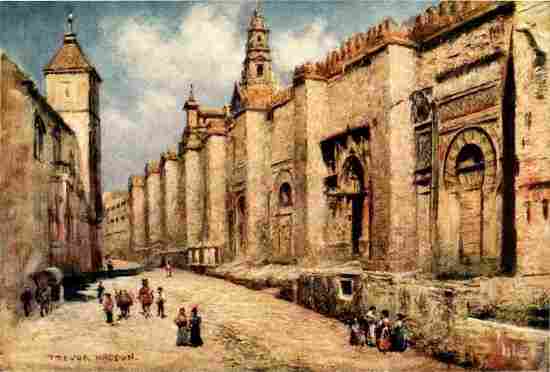
CORDOVA—OUTER WALL OF THE MOSQUE
On the whole the far-famed Mezquita may be pronounced disappointing. It must always be so with the simply planned temples of Islam, when they are stripped of the innumerable lamps, the rich carpets and handsome furniture, still to be seen in them at Cairo, Constantinople, and Smyrna.
Of the magnificent Palace of the Khalifas, the wonderful domain of Az Zahara, no trace remains. It was built by a Byzantine architect on the flanks of a hill, three miles north-east of Cordova, which the khalifa at one time thought of levelling. Arab writers declare this to have been the largest palace, as of course it was the most magnificent, ever raised by the hand of man. The harem (credat Judæus) could accommodate 6,000 women, 3,790 eunuchs, and 1,500 guards. Marble appears to have been freely used in the construction, from which it would seem that the building bore little resemblance to the Alcazar of a later day. There were, of course, thousands—tens of thousands—of columns brought from Rome and Tunis, and probably from Carthage, and fine fragments of terra-cotta are still unearthed on the site. Aqueducts conducted sweet waters to every chamber in the palace, and fountains cooled the air in the luxuriantly planted gardens. We are told of the Hall of Ceremonial, with its brilliant mosaics and its ceiling of scented wood, in the centre of which was set an immense pearl, the gift of the Emperor Constantinos Porphyrogenitos. And we hear in addition of basins filled with quicksilver for the amusement of the odalisques.
This gorgeous pile owes its existence to a favourite of the Khalifa An Nasir, who at her death directed that her immense wealth should be employed in ransoming Moslem prisoners in the clutch of the Christian. The bereaved potentate sent east, west, north and south in order to execute this pious request, only to find to his joy that no such thing as a Moslem captive was anywhere to be found. The happy thought then came to him to expend the money on the erection of a palace to be named after a new favourite, Zahara, whose name it should perpetuate, and in whose society he might hope to forget the deceased. This seems to us a somewhat queer application of the legacy. The work occupied ten thousand men daily for many years, and cost during An Nasir's reign alone seven and a half millions of dineros or pieces of gold.
The palace seems to have excited, as well it might, the cupidity of neighbouring monarchs. Alfonso VI., the conqueror of Toledo, demanded it of the Amir Al Mutamed, as a residence for his queen, Doña Constancia, whose accouchement he suggested might take place in the mosque. It was the Moor's rejection of this original proposal that led to hostilities, and threw the Spanish Moslems into the arms of the terrible Almorávides. Those fierce sectaries seem to have entirely neglected Az Zahara, and under the puritanical Almohades we can easily imagine it would be suffered to decay. How little was left of it when Ferdinand took the place is shown by his referring to it merely as Cordova la Vieja (Old Cordova).
Men who lived in such comfort and luxury might be supposed to have regarded their less fortunate fellows with easy good nature and tolerance, and according to most historians the khalifas of Cordova were benevolent despots, even towards their Christian subjects. Some Spanish writers, however, paint the lot of these last in gloomy colours, though, if we accept their accounts in toto, without the least reservation, there can be no question that the lot of the Christian under the Moor was very much better than the lot of the Moor under the Christian. But that standpoint would not be that of the historians in question. They are frankly partisans. The Mohammedans, they would argue, deserved what they got, because they worshipped the false Prophet; the Christians were in the right. It is more difficult to understand their vehement condemnation of the Bishop Recafred, because he forbade his flock to seek voluntary martyrdom by publicly cursing Mohammed. To curse the Arabian Prophet or anyone else is nowhere laid down as a Christian's duty, and on merely prudential grounds the prelate was surely justified in dissuading his people from pursuing a course which must finally have resulted in their complete extermination. Probably in disgust at the ingratitude and imbecility of his flock, Recafred embraced the creed of Islam, and died cursed and abominated by the people whose utter extinction he had averted. The history of the martyrs of Cordova is a curious chapter in the annals of religion.
It was recently remarked of Italy that there was not enough faith to generate a heresy, and by a parity of reasoning the lamp of faith must have burnt very brightly in the Christian community of Cordova. The Saracen authorities were bewildered by the multitude of sects and factions which claimed to represent the Church of Christ, and to administer its temporalities. Councils of the Christian prelates were frequently convoked by the khalifas, but by the defeated side their decisions were always branded as schismatical or heretical. Religious debate is the favourite occupation of a decaying State, and the Mohammedans themselves had their divisions. The doctors of the law, who congregated in a special quarter of the capital, constituted themselves the critics of their rulers and of public morals. They considered culture and luxury incompatible with morality, and preached the creed of the Uncomfortable and the Unlovely with the zest of an English Puritan. One day there arose a sovereign (Hakem) more sensitive of censure than his predecessors. He burnt out the Puritan quarter and forced the zealots to take refuge in distant parts where their peculiar talents were more in demand.
The more human side of Islam found an embodiment in the illustrious Ziryab, the favourite of Abd-ur-Rahman II. In his case, I suppose, as in all else, it is necessary to discount by fifty per cent. all the appreciations of Arabic writers; yet through all the cobwebs of exaggeration and tradition, we can discern the outlines of a very remarkable personality. Ziryab was the Admirable Crichton of his age. He combined the attributes of Leonardo da Vinci and Beau Nash. He alone could decide on the proper method of eating asparagus and on the planning of a city. He could pronounce with finality on the wisdom of a move at chess and a far-reaching treaty of state. He had views on the organization of armies and aviaries; he was listened to with equal respect by statesmen and scullery-maids. And (wonderful to relate) this authority on everybody's business was loved by everyone!
The history of Cordova, like that of most capitals, belongs to the nation at large, and cannot be more than touched upon here. Memorials of ancient days are the picturesque Moorish walls with their flanking towers and the grand old bridge of sixteen arches, built by the khalifas. It marked the limit of navigation in Roman days, whereas now no boat can ascend the Guadalquivir above Seville. The bridge is defended on the south side by a very picturesque tête du pont called Calahorra, a fine specimen of the medieval barbican. Here a strange scene was witnessed in the year 1394, when the prototype of Don Quixote, Don Martin de la Barbuda, Grand Master of Calatrava, appeared at the head of a few knights and a fanatical rabble on his way to fight the Moors of Granada. His enterprise was directly counter to the king's orders; the two countries were at peace. The royal officers assembled on the bridge expostulated and threatened the crusaders in vain. The Grand Master was accompanied by a hermit, who exhorted him to proceed and promised him that his victory should be purchased without the loss of a single Christian life. The officials were swept aside, and the wild cavalcade went on its way to destruction. None of the knights ever returned alive across the bridge of Cordova.
During the four centuries following the Reconquest, the city boasted that it was the home of the finest flower of the European aristocracy. Their old mansions have for the most part disappeared, but the name of the most distinguished member of the order is treasured in Cordova and honoured far beyond the limits of Spain. Gonzalo Hernandez de Aguilar y de Cordova, "the Great Captain," is the hero of the city. The principal street is named after him, as indeed one might suppose the town to have been, from the reverence in which he is held. On the whole, he was the greatest soldier this country has produced. With forces hardly superior to those with which Cortes and Pizarro conquered a savage foe, he vanquished the best equipped troops in Christendom and matched his strength successfully against the most brilliant warriors of his day. His reward, it is hardly necessary to say of the servant of a fifteenth-century king, was ingratitude and neglect. When the odious Ferdinand V. demanded from him a statement of his military expenditure, he responded with the famous "Cuentas del Gran Capitan," which silenced even the venal monarch. The statement ran:
"200,736 ducats and 9 reals paid to the clergy and the poor who prayed for the victory of the arms of Spain.
"100 millions in pikes, bullets, and entrenching tools; 100,000 in powder and cannon-balls, 10,000 ducats in scented gloves to preserve the troops from the odour of the enemies' dead left on the battlefield; 100,000 ducats spent in the repair of the bells completely worn out by every day announcing fresh victories gained over our enemies; 50,000 ducats in 'aguardiente' for the troops, on the eve of battle. A million and a half for the safeguarding prisoners and wounded.
"One million for Masses of Thanksgiving, 700,494 ducats for secret service, etc.
"And one hundred millions for the patience with which I have listened to the King, who demands an account from the man who has presented him with a kingdom"!
This singular balance-sheet sufficiently shows the temper of the grandees of Spain even in the days of the New Monarchy. Cordova has reason to be proud of her eponymous hero. She has not been very fruitful in great men. She has produced no painters of eminence, unless Pablo de Cespedes may be classed among such; but Mme. Dieulafoy reminds us that to Juan de Mena, a native of the place and a courtier of Juan II., Spanish poetry is deeply indebted:
"His great work, 'The Labyrinth,' may in a measure be compared with that part of the 'Divina Commedia' where the Florentine places himself under the protection of Beatrice. Accompanied by a beautiful young woman personifying Providence, the poet witnesses the apparition of the worthies of History and Legend, and amuses himself in sketching their portraits. At times the style becomes heavy and pedantic, at others the touches of the pencil have a vigour and simplicity altogether Dantesque. Before Juan de Mena, the Castilian muse had never taken so daring a flight; and in spite of the defects of the general scheme, the untasteful phraseology, and the measure, 'The Labyrinth' abounds in conceptions and episodes where energy blended with beauty reveals a genius of the first order."
From poetry to leather the transition may seem abrupt, but it is to be feared that our city has derived more renown from the latter than the former. The stamped and gilded leather of Cordova was highly esteemed all over the civilized world from the fifteenth century to the eighteenth. Whether the industry was introduced by the Moors it is idle to inquire; long after their departure it formed the principal business and source of revenue of the Spaniards of the city. A powerful guild laid down strict rules as to apprenticeship, and regulated the quality and quantity of the manufacture. Terrible penalties were enforced against the tanner who made use of the hides of animals that had died of disease. The kings of Spain considered trunks or other objects bound in Cordova leather gifts very suitable for their fellow-princes. The Catholic kings, absurdly enough, forbade its exportation to the New World, not wishing to deprive the mother-country of goods of such price. With protection on this scale, we are not surprised to learn that the industry began to decline. Cordova was at length surpassed in its own line by Venice and other cities. The rich specimens of its work which adorned the mansions of its old noblesse were sold and dispersed all over the world, upon the general impoverishment of the kingdom in the eighteenth century. Then came the sack of the city, a hundred years ago, by the army of Dupont. Time has spared the famous race of Cordovan horses, and many a poor hidalgo rides into the town on a steed which if sold in London might redeem his shattered fortunes.
I have said a great deal about Cordova and its titles to remembrance; but it must be confessed that there is little enough to see in it. The churches present no features of interest, except the Colegiata de San Hipolito, modernized in 1729, which contains the tombs of Ferdinand IV. and Alfonso XI. Nor is walking through the city an exercise altogether pleasing, as the streets which were the first paved in Europe, in 850, might also claim to be the worst paved in the world. The stones are so sharp and pointed that in parts you have to skip from one to the other, like a bear dancing on hot iron—an original but ungraceful method of locomotion. A drive in the surrounding country is productive of more pleasure. The neighbourhood is a Paradise of fertility, and sets one wondering what becomes of all the money that this must bring in and represent. Spain and Greece are very poor countries, but I do not think that Spaniards and Greeks are, for the most part, very poor.
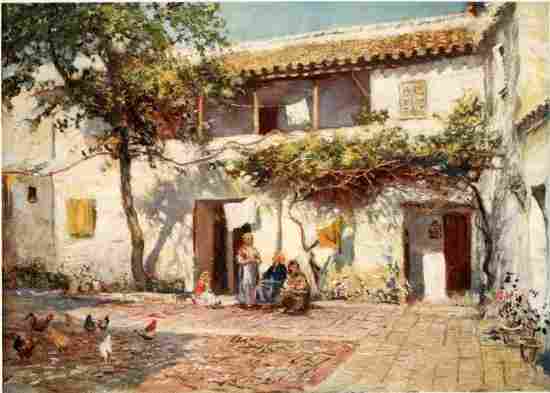
CORDOVA—OLD HOUSES NEAR THE RIVER
CHAPTER IV
GRANADA
OVER two thousand feet above the sea stands the ancient city of Granada, once the teeming centre of the kingdom of the Moors and now a town of memories eloquent of the grandeur of older days. The province bearing its name is bounded on the north by sterile ranges, while close to the southern seaboard stretch the huge shoulders and serrated peaks of the noble Sierra Nevada, rivalling in height the chief summits of the Pyrenees. Between these ranges spread fertile vegas, or plains, rising here and there to over a thousand feet, a district of vineyards and olive groves, and semi-tropical plants find a favourable habitat.
Granada, though on the verge of an arid territory, is in a strip of great fertility, watered by the Genil and the Darro, the latter—the Hadarro of the Moors—a stream that is heavily taxed by the farmers for purposes of irrigation. Théophile Gautier praised the river of Granada for its beauty, but since his day the stream has shrunk, and nowadays the volume of water is insignificant, especially during a dry summer.
The waters of the Darro have a reputation for their healing qualities, and cattle that drink from it are said to recover quickly from diseases. Hence, in the ancient speech, the river had the title of "The Salutary Bath of Sheep." Under the Moors the environs of Granada were in the highest state of cultivation, and they are still very productive. The land yields plenteous wine and oil. The chief crops are grains of various sorts. Hemp and flax flourish, and oranges, lemons, and figs are a source of income to the agriculturists. Granada is also famed for its mulberry trees, whose leaves provide food for the silk caterpillar, though the silk trade is in a state of sad decay.
The soil around the city never rests. There is no waste of land. Oranges and pomegranates grow profusely. The cactus is cultivated for the production of the cochineal insect. Clovers yield several cuttings each year in this fecund territory.
In the neighbouring mountains there are rich veins of marble, and jasper and amethyst are found. Yet the mining industry in the Sierra Nevada remains to be developed. The Granadines are hardly a commercial population, though numerous crafts are practised in their city. Factories for the production of sugar from beetroot have been erected in recent years, and it is hoped that this industry will increase.
The life of Granada in its lighter aspects can be well studied on the promenade of the Salón, one of the most beautiful parades in Europe. Here, under the shade of luxuriant trees, amid handsome fountains, and by parterres decked richly with many flowers, the people of the city stroll upon summer evenings after the great heat of the day. From the Salón you gain a superb view of the purple Sierra Nevada, which at sunset wears a wealth of changing hues.
A walk along the promenade precedes the evening gathering in the patios of the houses of the upper and middle classes, when to the sound of guitar and the rattle of castanets, young and old dance together. At these tertulia, or evening parties, singing alternates with dancing the bolero and the jota. And later, when the lights are dim, and the watchman tramps slowly through the streets, you see the lovers, the "novios" waiting beneath the windows of the adored fair ones, or lightly strumming serenades on their guitars.
At festival times the city is all animation. The anniversary of the taking of Granada is celebrated on January 2, when a procession is formed and proceeds to the Cathedral. Corpus Christi is another feast day, and there are two fairs during the year, one in June and the other in September.
But it is Granada of the past rather than of the present that holds us during a sojourn in the city of hills and vistas. It is the scene of dreams, a city of meditation. You court serenity rather than hilarity amid these haunted streets and silent ruins. The Arabs had a saying, referring to one who was sad, "He is thinking of Granada." It is this spirit, perhaps, which prevails in the patios of the Alhambra and amid the orange trees of the Generalife Gardens. And yet it is not true depression. It is a sense of the glory that has been, a meditativeness which is induced by the somnolence of the scene, and fostered by the languorous atmosphere of the South.
An ancient legend, often rehearsed by chroniclers, ascribed the founding of the city to certain descendants of Noah. It stated that Tubal settled in Spain and populated the country. There is some evidence that the province of Granada was the first district in Spain peopled by aliens. The founder of a town on the site of modern Granada is alleged to have been the mythical Iberus, who built Illiberis, which has been referred to as the original city. At any rate Illiberis existed in the Roman days, for it was a municipium under the rule of Augustus. The town was also the scene of an ecclesiastical council in the fourth century.
Plundered by the Vandals, and won by the Visigoths, Illiberis was in decay at the time of the coming of the Moors to the Iberian Peninsula. With the conquest of Andalusia, the town of Granada first came into existence.
At this period the Berbers overran the territory, though the Moorish authors relate that settlers from Damascus were the first Eastern colonizers of Granada.
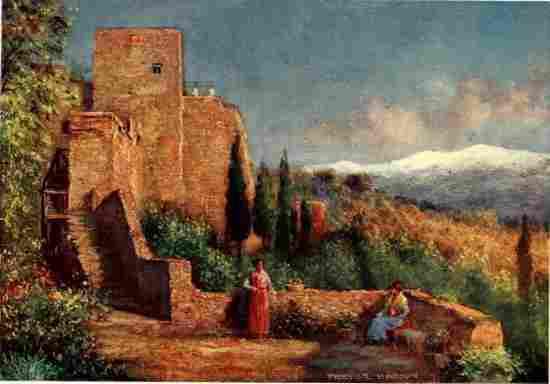
GRANADA--SIERRA NEVADA FROM THE ALHAMBRA GARDENS
The greatest obscurity shrouds the history of the city. It is strange that the writers of medieval times so rarely allude to Granada. About the year 860, a war raged over Andalusia between the native Moslems and their foreign rulers, the chief leader of the former being Omar Ben Hafsûn. Under his lieutenant, Nabil, an attack was made on Granada, and we read that some exultant verses written by the belligerents were attached to an arrow and propelled over the city wall. In these verses the words Kalat-al-hamra ("the Red Castle") appear. This first reference to Al-Hamra suggests that an edifice for defence stood on the hill now occupied by the Alhambra.
In 886 Omar Ben Hafsûn appears to have wrested Granada from the Khalifa of Cordova. A few years later Omar was conquered, and retiring to the Castle of Bobastro, he embraced the Christian faith, in which he died.
Zawi Ben Ziri, a Berber, first established Granada as a kingdom in 1013. Gayangos, the Spanish historian, states that Illiberis—or Elvira, as it was called at this time—was a dwindling city and that Habus Ibn Makesen, nephew to Zawi Ben Ziri, founded a new town and capital.
Habus was a builder as well as a warrior. He is the putative founder of the old Kasba, or citadel, in the Albaicin quarter, which was added to by his heir, Badis, who succeeded him in rule. The king is also said to have built the Casa del Gallo de Viento, in the same quarter, where he probably resided. Badis proved an ambitious and warlike monarch, for he enlarged his dominions widely, and even subdued the resolute hillfolk of the Alpujarras. He conquered Malaga, and made plans to besiege Seville. But his force was routed at Cabra by the famous Cid Campeador, Ruy Diaz de Bivar, the ally of the sultan of that city. To Badis is attributed a persecution of the Jews, who numbered several thousands in Elvira, and a terrible slaughter decimated their ranks.
At the advent of the Almoravides, a fierce sect of Northern Africa, Granada was captured (1090) by Abd-ul-Aziz. The city now rose in importance. Soon after the Almoravide settlement, the followers of Islam in Granada attacked the Christians of the city and destroyed their church by fire. The unfortunate Christians appealed for help to Alfonso of Aragon, and the king came to their relief at the head of a strong army. In the combat at Anzul the Almoravides were worsted. Alfonso before retiring laid waste the fertile plain, and left the Christians to make the best of their position. His action had little effect upon the Almoravides, for in 1126 numbers of Christians were banished to Barbary and the rest bitterly oppressed.
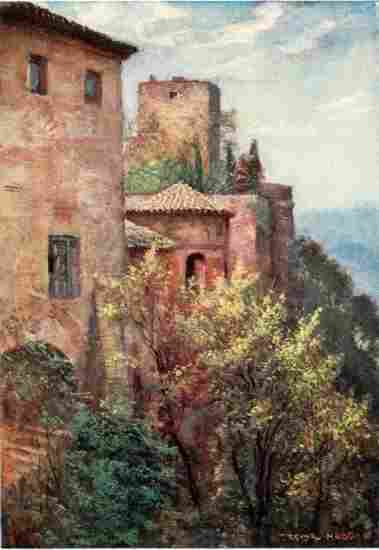
GRANADA—EXTERIOR OF THE ALHAMBRA
The doom of the Almoravides came in 1148. A mightier host, the rapacious and fanatical Almohades, surged over the city. The Moorish inhabitants, strengthening their forces with the aid of Christians and Jews, invited Ibrahim Ibn Humushk to lead them to the expulsion of the new sectaries. The invaders took refuge in the Kasba, and sought relief from Africa, whence an army was despatched. This force was beaten by Humushk, and the Granadines secured the assistance of the Sultan of Murcia and Valencia, whose troops attacked the Kasba, which was held by the Almohades. On the arrival of a second army, they made a sally and inflicted severe losses upon the soldiers of the sultan and his Christian allies. After this success, the Almohades endeavoured to pacify the unruly among their neighbours. Their governor, Sidi Abu Abrahim Ishak, was a tactful and benevolent leader. He improved the city, built a palace for himself, and made the Kasba a stronger fortress. The power of the Almohades was, however, insecure. Ben Hud, a potent chieftain, who had gained a strip of territory on the coast, now discerned that the hour was ripe for an assault upon Cordova, Jaen, and Granada. His domination was not permanent. Mohammed al Ahmar, uniting with the foes of Ben Hud, held Seville for a brief space, and then drove his rival to Almeria, where he was murdered in 1237.
Granada now came under the sway of Al Ahmar, and in the hour of his triumph he was proclaimed monarch of a large part of southern Spain. For two hundred and fifty years the State founded by him resisted the Christian hosts. Granada rose to the zenith of power and prosperity. Its first sultan was a man of high character, courteous, dignified, and astute. He reigned long, and spent himself in affairs of government and in military enterprises, though he used every means to maintain peace.
Al Ahmar's last expedition was undertaken against the Spanish forces and the governors of Guadix and Malaga (their allies) when he was eighty years of age, and failing in strength through illness. A fall from his horse brought him to his end. He expired in the arms of his ally, the Infante Don Felipe, and under cover of darkness his body was borne to Granada, where it was entombed in the burial ground of Assabica.
The sovereignty now descended to Al Ahmar's son, named Mohammed II., who ascended the throne in 1273. He was renowned for his wisdom in the law, and during his reign of twenty-nine years he proved a worthy son of a great father.
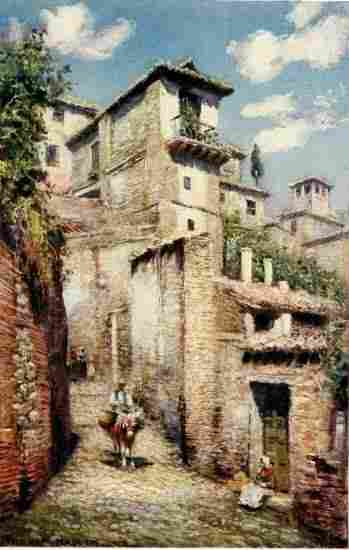
GRANADA—A STREET IN THE ALBAICIN
During his negotiations with Alfonso X. at Seville, Mohammed was the victim of an artifice of Queen Violante. Upon being asked by the queen a favour, he yielded in accordance with the chivalric notions of the time, but his chagrin was deep when he learned that he had agreed to a year's truce to the rebels within his dominion. Smarting under this device, he made plans for the annihilation of his foes. Now the friend of the Spaniards against the African, now the ally of his own co-religionists, Mohammed's career was one of strife. He died in 1302, able to boast that he had not lost a particle of the soil bequeathed to him by his father. Mohammed III. was, like his father, a forceful sovereign. He applied himself rigorously to the government of his territory, often spending the whole twenty-four hours in affairs of State. In 1306 he seized Ceuta, and brought a number of the conquered to Granada. But reverses came when the governor of Almeria rebelled and joined hands with the King of Aragon. Meanwhile the Castilians attacked Algeciras, and Mohammed, between two foes, was brought to bay. He extricated himself from danger by yielding four fortresses and paying a heavy sum. But his troubles were not at an end. Returning to Granada, he was surrounded by conspirators in his palace, and forced to yield the throne to his brother, Abu-l-Juyyush Muley Nasr. Humiliated and defeated, Mohammed retired to Almuñecar, where he lived in seclusion.
Nasr's first coup after seizing the throne was a successful attack upon Don Jaime at Almeria. Unfortunately a conspiracy was fomented by his nephew Abu-l-Walid. Nasr, who seems to have had a fit of apoplexy, was thought to be dead when Mohammed III. was brought back to Granada. He was, however, alive upon the return of the lawful sovereign; and on the authority of some historians he ordered that his rival should be put to death, while other writers assert that Mohammed was again banished to Almuñecar.
Soon after, Nasr was assailed by the followers of Abu-l-Walid, and forced to yield. As a solatium he was allowed to rule over the town of Guadix, whither he retired. Al Khattib relates that Nasr was a philosopher, and versed in the sciences of astronomy and mathematics.
Abu-l-Walid was an implacable foe of the Christians. His assault on Gibraltar was frustrated; but he gained a signal victory over the Castilians in 1319, when the princes Pedro and Juan were killed. Following up this success, he marched upon the towns of Martos and Baza, and ravaged the country. It was at the latter town that artillery was first used in Spain.
Hailed with joy, the victorious Abu-l-Walid returned to Granada bearing the spoils of war. Among the captives was a maiden of unusual beauty, whom he had wrested from an inferior officer. This act so incensed the chieftain that three days after he stabbed his ruler outside the Alhambra. Dying from the wound, Abu-l-Walid exacted an oath of fealty from the eminent and powerful to his eldest son, Mulai Mohammed Ben Ismaïl. This command was fulfilled before the sultan's minister disclosed the death of his royal master.
The boy king, Mohammed IV., was soon busy quelling factions in his State, and repelling the African army, which took in turn Marbella, Algeciras, and Ronda. He also defeated the Castilians in several desperate encounters, but lost the day at Gibraltar.
Mohammed IV., who was assassinated at Gibraltar by his allies the Moroccans, was succeeded in 1333 by his brother Yusuf I. This king was a hater of warfare; he sought the peaceful reform of the community rather than the expansion of his kingdom. Under his rule Granada prospered and the condition of the people was bettered. Yusuf I. was disturbed in the tranquillity of his noble palace at Malaga by the appeals of the African potentates for his aid in reconquering Spain. Compelled to join the invaders, he sustained a severe disaster at the Salado, and was forced to acquire peace at the cost of yielding Algeciras. He was murdered by a madman in 1358.
Mohammed V. was the next sovereign. He was a worthy son of his high-principled father, Yusuf; but fate decreed that his reign should not prove peaceful, for soon after his accession, his younger brother Ismaïl conspired with certain officers of state and made an attempt to gain the throne. Upon a night in August, 1360, about one hundred conspirators climbed the walls of the Kasba and after killing the wizir, proclaimed Ismaïl as sultan. Mohammed, who was without the palace at the time, essayed to enter; but he was received with a flight of arrows, and mounting a horse he galloped away to Guadix. Here he was welcomed, and from this town he sped to Marbella, thence to Africa, where he received the aid of Abu-l-Hasan. With troops lent to him he returned to Spain, hoping to crush the usurper. But Abu-l-Hasan capriciously ordered the return of his soldiers, and Mohammed retreated to Ronda with a few adherents.
Dissension had arisen meanwhile between Ismaïl and Abu Saïd, one of the chief conspirators, who was burning to take the reins of government in his own hands. Ismaïl was besieged by Abu Saïd, and upon venturing out of his palace was slain.
Fresh trouble arose in Granada, for Pedro of Castile came to the assistance of the lawful ruler. But Mohammed, witnessing the ravage of the district by the Christian army, was far from receiving the invader with open arms. "For no empire in the world would I sacrifice my country," cried the sultan. Thereupon the King of Castile retired, and Abu Saïd, mistaking the reason of his return to Seville, went thither to beg his alliance. The story of the sultan's murder, at the instigation of Pedro the Cruel, has often been told. Abu Saïd was done to death at Seville, and the resplendent ruby which was taken from him was presented to the Black Prince of England, and is still preserved among the regalia of England.
Mohammed then returned to his capital. With the exception of a rebellion under Ali Ben Nasr, he passed twenty years of peace. Granada became a more thriving city, and under the sultan's clement administration, it was the resort of traders of all nations and the centre of culture in the south. According to Mendoza, the inhabitants of Granada numbered about 420,000 in the reign of Mohammed V., but it is probable that the number was wildly over-estimated.
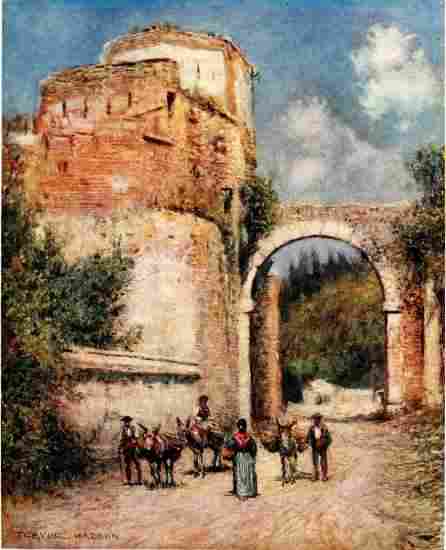
GRANADA—THE ALHAMBRA: THE AQUEDUCT
Yusuf II. followed Mohammed V. He was suspected of favouring the Christians. He certainly released all the captives of that faith, and restored them to their own country. This act appears to have incited his son Mohammed to rise against the throne. Yusuf was at first disposed to relinquish his sovereignty, for he was a lover of peace; but on the advice of an ambassador from Morocco he raised an army and advanced on Murcia.
At this period the King of Castile was Enrique III., an incapable monarch in defiance of whose orders Don Martin de la Barbuda, the Master of Calatrava, headed an advance into the kingdom of Yusuf. The force was, however, entirely routed by the Moors. Soon after (1395) Yusuf, the pacific sovereign, was dead—the victim, it is said, of a poisoned potion, in the form of a tonic sent him by the Sultan of Fez.
The first exploit of Yusuf's son Mohammed was a visit to Toledo, with twenty-five mounted attendants, where he appeared before Enrique III. and besought a renewal of the truce. The armistice was disregarded by the governor of Andalusia, who invaded the Moorish dominions, till Mohammed, in reprisal, seized the citadel of Ayamonte. At Jijena he was defeated, and was forced to plead for peace. He was at the point of death, when the idea seized him to secure the government of Granada for his son by the assassination of his brother. The governor of Salobreña was commanded to put to death the prince whom he had in his keeping. The doomed man asked leave to finish the game of chess in which he was engaged, and before either player could cry "Checkmate," the news came that the prince's brother was dead and that he had been declared sultan. Yusuf III. was faced with difficulties immediately upon his accession. Antequera fell into the hands of the Castilians, led by the Infante Fernando. The defenders were slain, and only about two thousand of the townsmen outlived the rigours of the siege. The survivors were allowed to settle in Granada, and they gave the name of Antequeruela to the suburb.
When the natives of Gibraltar revolted, and declared allegiance to Fez, the sultan of that State sent his brother Abu Saïd to secure the town. Abu Saïd, being left to the mercy of the enemy, was seized and brought to Granada, where he was shown a letter from the ruler of Fez desiring that he might be despatched. With this request the generous Yusuf refused to comply. He released his captive and furnished him with money and troops with which he left for Africa. The brother who had planned his death was hurled from the throne, and till Abu Saïd's death Granada did not want an ally.

GRANADA—THE COURT OF THE CYPRESSES
In rapid succession sultans now flit across the lurid page of Granada's history. It is a gloomy tale of incessant civil strife and of unsuccessful warfare with the Christians. Rulers are expelled from their thrones by pretenders who themselves fall victims to the poignards of their partisans. Sovereigns purchase their disputed crowns by selling the honour and independence of their country to the foreigner. To trace the miserable vicissitudes of the careers—we cannot call them reigns—of Mohammed VII., Mohammed VIII., Yusuf IV., and Saïd Ben Ismaïl, would be to weary and disgust you with a nation whose stubborn fight against overwhelming odds should command our respect.
The last act in the protracted drama began with the accession of Mulai Hasan in the year 1465. With his famous reply to the Castilian ambassadors who demanded tribute, "Here we manufacture only iron spear-heads for our enemies," the final campaign began. Every incident of that war has been made familiar to us Anglo-Saxons by the pen of Prescott. In his pages long ago most of us read of the taking of Zahara by the Moors and of the brilliant surprise of the fortress of Alhama by the gallant Marquis of Cadiz. We have not forgotten the wailing of the Moors, "Ay de mi, Alhama!" nor the domestic revolution that followed when the old sultan was hurled from his throne by his son Boabdil. Poor Boabdil, on whom the blame of all his country's disasters has been laid by historians, Christian and Arab! Weak or foolhardy, the "Little King" fought like a Trojan against Ferdinand and Isabella for his country, and against his father and his uncle for his crown, at one and the same time. He was taken prisoner by Ferdinand and is said to have signed a treaty surrendering his dominions to the Catholic Sovereigns. This is rendered improbable by his comparatively generous treatment at the end of the war, when he had resisted the Spaniards to the uttermost, and fought them many times after his release from captivity. Desperate deeds of valour were done on both sides, though the strategy of the Spanish commanders does not appear to have been of a very high order, since, with the whole of Spain at their back, it took them eleven years to conquer a small kingdom distracted by three rival rulers. The old sultan retired from the contest, as finally did his brother, the brave Zaghal. When the Christians were preparing a final assault on the doomed city, Boabdil rode out from the Alhambra, for the last time, on the morning of the memorable 2nd of January, 1492. Ferdinand with a brilliant cavalcade awaited him on the banks of the Genil. The keys were handed over, a hurried exchange of formal courtesies, and the last ruler of the Spanish Moors passed away into exile and obscurity. The rays of the wintry sun glinted on the great silver cross which was hoisted on the Torre de la Vela in token that the reign of Mohammed was for ever at an end in Spain.
Yes, at an end. On that morning, Ferdinand and Isabella accomplished the task begun by Pelayo at Covadonga, seven hundred and seventy-four years before. The Moorish dominion in Spain had endured little short of eight centuries. It was as if the descendants of Harold Godwin were to arise and overthrow the existing English monarchy. But what is most remarkable is that the petty State of Granada had survived the break-up of the great Moorish empire in the west by two hundred and fifty years. Such a race deserved a manlier if not a more beautiful monument than the Alhambra.
What followed the extinction of the Nasrid monarchy is not pleasant reading. The rights and privileges guaranteed the conquered were soon swept aside. The mild Archbishop de Talavera, the humane Tendilla, were superseded in the government of the city by fanatics more after Isabella's heart. Systematic persecution of the luckless Moslems ensued. They revolted, and their revolt was quenched with their own blood. They were intimidated, browbeaten, imprisoned, condemned, and burned. Their language, costume, and creed were banned. They were ordered to embrace Christianity under pain of death, and forbidden to quit the country. They appealed to Egypt, but it is a long way from the banks of the Genil to those of the Nile. Finally (and one hears of it with relief) they were all expelled from the country. As a race they perished utterly. The art, the civilization, which they had learnt on Spanish soil, they left buried in Spanish ground, and it was a long time before it was disinterred.
The price Spain paid for national unity was a heavy one, but it was worth it. When we turn to Turkey, can anyone say that a united Spain would have been possible, with the fairest of her provinces and cities and the whole of her southern seaboard in possession of a people alien in race, tongue and creed?
With Oriental people, the history of the palace is the history of the State. At Granada every traveller turns instinctively towards the Alhambra as the point of supreme interest. The famous pile is to the city what the Mezquita is to Cordova—not quite, perhaps, since Granada contains more than one building of intrinsic interest.
The Alhambra has been so often described (by the present writer among others) that it is not easy to say anything new in regard to it, or even to avoid identity of language with other writers in the description of certain of its parts. Yet it would be impossible to give any account of Granada without some notice of this famous building. To begin with, I must impress on those about to visit it for the first time that the Alhambra is not a single palace, but properly speaking is the name given to a fortified eminence lying to the south-east of the city, and including two palaces, a citadel, and a multitude of private residences. In its nature it may be compared with the Acropolis of Athens and the far-distant Castle of Bamborough. The name, as most people are aware, is derived from Kalat al hamra—"the Red Castle," to adopt a translation which I have never seen disputed. (While not pretending to rank as an Arabist, I have not failed to notice that an infinite number of words put forward as Arabic by writers on the Spanish Moors are unintelligible to Syrian and Egyptian Arabs, and, which is more to the point, to many Hindu students of Arabic.) In shape the hill has been cleverly compared by Ford to a grand piano. Rearward it abuts on the Cerro del Sol ("the Mountain of the Sun"), to which Washington Irving alludes so often.
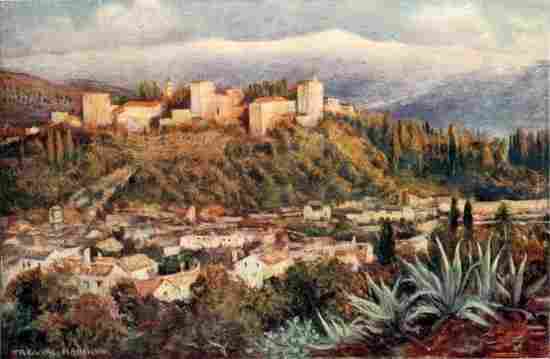
GRANADA—THE ALHAMBRA FROM SAN MIGUEL
To the south of the Alhambra hill lies another and a narrower spur, which is crowned near the town end by the Vermilion Towers, or Torres Bermejas; on the north-east rises the hill of the Generalife, laid out in gardens. The townward extremity of the Alhambra is washed at the foot by the river Darro, and is crowned by the Torre de la Vela, of which more anon.
To reach the Alhambra you ascend from the Plaza Nueva in the heart of the town by the steep and narrow Calle Gomeres. This street is laid out to attract and cater for tourists, who are greeted here with a civility and cordiality not always conspicuous in the rest of the town. Half-way up the toilsome ascent you will probably be waylaid by a theatrically-attired personage who will accost you in bad French with the information that he is the chief of the gipsies. The costume he wears was given to his father or grandfather by Fortuny—one of the rare examples of artists condescending to manufacture the picturesque. The chief will endeavour to engage you in conversation, and will offer you his photograph at fifty centimes a copy. If you have a camera he will allow you to take his portrait for a consideration. It seems incredible that a human being could be so much of a nuisance and yet remain in good health and spirits.
The dragon having been successfully circumvented, you enter the Hesperides, or in other words, the charming Alamedas of the Alhambra. These groves occupy the deep depression between the famous hill and the Vermilion Towers. They are planted with magnificent elms, sent hither, I believe, from England by the Duke of Wellington. They have thriven well in Spanish soil, and harbour a colony of nightingales and other singing-birds, unusually numerous for this land of passion, where wines are rich and birds are rare. The "bulbul," as certain writers love to call it, sings very sweetly in these leafy retreats, a statement some travellers who persist in coming at the wrong season will not hesitate to contradict. I must admit that the bird is as elusive as the "alpengluh," or as the hunter's moon at Tintern. It is always cool here on the slope of the Alhambra. Even the fierce rays of the Andalusian sun cannot penetrate the thick leafage. Rills bubbling forth from the red sides of the hill, or tumbling over its edge, keep the roots of the trees perennially moist and feed a dense under-growth. On summer afternoons this is the only spot in Granada where you may sit in comfort. Meanwhile, up and down in quick succession pass the sandalled water-carriers hurrying to fill their skins with the precious fluid and to dispense it in the scorched, thirsty town below. "Agua-a-ah!" Their prolonged nasal drawling cry comes back to me as I write, and I seem to hear the rapid patter of their feet and to see the light cutting chequers on the shadow of the trees. A great man is the water-carrier, loved and respected by all the people of southern Spain. We who live in the humid sea-girt North can little understand the longing for clear, cool water, the reverence for its dispensers, that must ever be felt in the South. How constantly wells are referred to in the Bible: "As the hart panteth after the water brooks," "With joy shall ye draw waters from the wells of salvation." How significant are these beautiful passages for those that have journeyed to the South!
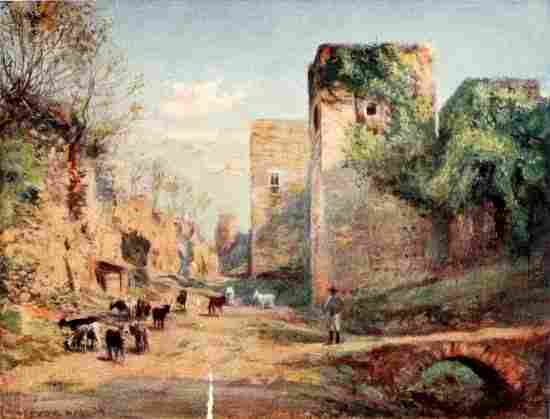
GRANADA—TOWERS OF THE INFANTAS, ALHAMBRA
Reluctantly withdrawing from this delightful spot, you must climb the hill to the right of the entrance—there is a winding path to the summit. Here you find the Torres Bermejas—a group of exceedingly ancient and not very dilapidated towers, used as a military prison. They date, it is believed, from the days before the Zirite dynasty, but you will not be tempted to examine them attentively, for the purlieus are of the most uninviting description. The adjoining cottages are peopled by rascally-looking men and slatternly women, who would be better, one would think, inside than just outside a gaol.
In ancient days an embattled wall connected these towers with the opposite point of the Alhambra, closing the mouth of the valley, which was not then the pleasaunce it is now, but an arid ravine used as the burial ground of the fortress. The entrance to the valley is now through the Puerta de las Granadas, built by order of Charles V. Taking the path to the left, we soon reach the fountain in the Renaissance style, erected in 1545 by Pedro Machuca, by order of the Conde de Tendilla. It is ornamented with the imperial shield and the heads of the three river-gods, Genil, Darro, and Beiro. The medallions represent Alexander the Great, Hercules slaying the hydra, Phryxus and Helle, and Daphne pursued by Apollo. The laurels growing out of the distressed damsel's head give her the appearance of a Sioux brave. A few steps beyond we reach the famous Puerta de la Justicia, so called because within it the Moorish sultans or their kadis administered justice—or it may have been merely law. This entrance is formed by two towers of reddish brick, placed back to back, and united by an upper storey. We look at once for the hand and key so often referred to by Irving, and distinguish them with difficulty—the first over the outermost horseshoe arch, the latter over the middle arch. Opinion is divided as to the meaning of these symbols. The key is supposed by some to signify the power of God to unlock the gate of Heaven to the true believer, while the hand appears to have been regarded as a talisman against the evil eye. A winding corridor leads through the gate into the citadel, past an inscription celebrating the Conquest in 1492, and an altar now enclosed within a sort of cupboard.
This gate is placed at right angles to the wall which girdles the hill and runs along its edge, following all its inequalities of level. It is in fairly good preservation, but the rampart walk has disappeared here and there. Of the square mural towers a great many remain—some hopelessly ruinous, others inhabited by the guardians of the domain or their widows and relations. The towers on the south-west side, as far as I could judge, were better adapted for defence than those on the north-east, where the width of the windows would have greatly embarrassed the defence. The area enclosed by the outer wall was divided, it seems, by two cross walls into what, in the medieval parlance, we would call the outer, middle and inner wards. To the last corresponded the citadel proper or Kasba (Alcazaba, the Spaniards call it), whose massive walls rise to your left on emerging from the Puerta de la Justicia. This is the oldest part of the fortress. It occupies the extremity of the plateau, which is marked by the tall, square Torre de la Vela, or watch tower, whereon a silver cross was planted by the "Tercer Rey," Cardinal Mendoza, to announce the occupation of the Alhambra by the Spaniards. Here also is a bell which can be heard as far off as Loja, and which, if struck with sufficient force by a maiden, is said to have the faculty of procuring her a husband. The view from the platform is noble. The dazzling white city is spread out beneath, in front stretches the Vega, to the south the eyes rest lovingly on the white streaks of the Sierra Nevada.
Upon this tower I met a French entomologist, who announced that he should not trouble to visit any other part of the Alhambra, and was, in fact, surprised to learn that there was anything more to see. His horizon was bounded by the Lepidoptera, on one side, and the Coleoptera (I think that is the word) on the other. After all, archæologists take no more interest in black beetles than entomologists do in buildings. Incidentally, I should think Granada an admirable place for the intimate study of insects.
From the Torre de las Armas, a road led from the citadel down the declivity to the town, crossing the Darro by the ruined Puente del Cadi. On the inner side the citadel is strengthened by the picturesque Torre del Homenage—a name often given to towers in Spain. The open space before it, where the water-carriers gather round the well, was a comparatively deep ravine in Moorish times, and was not levelled up till after the fall of Boabdil. On the opposite side—facing the Torre del Homenage—it was bounded by what I will call the wall of the middle ward, which ran across from the Torre de las Gallinas to near the Puerta de la Justicia, and of which only the gatehouse, the beautiful Puerta del Vino, remains.
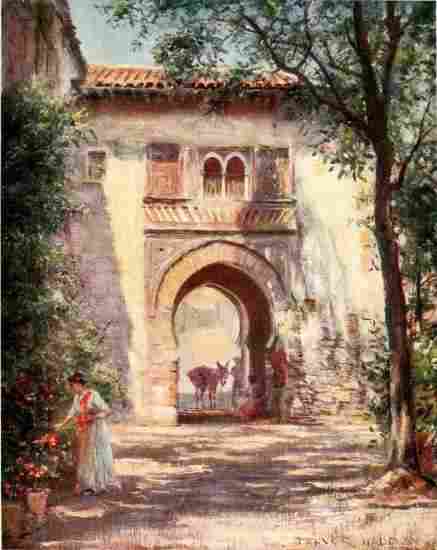
GRANADA—PUERTA DEL VINO, ALHAMBRA
This admitted to the area which contained the palaces and also the little town of the Alhambra—inhabited by persons attached to the court, the ulema, chiefs of such powerful tribes as the Beni Serraj and the Beni Theghri, discarded sultanas, ex-favourites, soldiers of fortune, plenipotentiaries and envoys, and a crowd of parasites and hangers-on. To-day the population is limited chiefly to one little street, composed of pensions, photographers' shops and estancos. The plan of the whole fortress no doubt varied from age to age, but in the main agreed with that according to which most European strongholds were constructed. There was the outer wall with its mural towers and gatehouses; a strong inner ward, in place of a keep shut off by a ditch or ravine; and two or more other enclosures, each defended by a wall with a fortified entrance. It does not seem that the portcullis and drawbridge were used by the Moorish engineers.
While the Kasba is generally attributed to an earlier dynasty, the outer wall and the other Moorish buildings are almost unanimously ascribed to Al Ahmar and his successors of the Nasrid dynasty. To reach the Alhambra Palace, called pre-eminently by foreigners the Alhambra and by the Spaniards the Alcazar, or Palacio Arabe, you pass across the plaza, leaving the unfinished Palace of Charles V. to your right. Behind it you find not an imposing and gorgeous structure, but what appears to be a collection of tile-roofed sheds. A mean, characterless entrance admits you to the far-famed palace.
The building belongs to the last stage of Spanish-Arabic art, when the seed of Mohammedan ideas and culture had long since taken root in the soil and produced a style purely local in many of its features. Some authorities trace the first principles of Arabic architecture back to the Copts; the Spaniards argue that their style is derived from Byzantine works they found before them in Andalusia. The germs of Arabic art are certainly not, if travellers' tales be true, to be found in Arabia. The Saracen conquerors were warriors, not artists, and their ideas of form and ornament were undoubtedly borrowed—like their vaunted culture—from the more civilized nations with which they came in contact. With Morocco just across the strait, it is not safe to claim too much of native genius and refinement for the Moor. Whatever may have been the primitive models of Andalusian architecture, as time went by it lost much of the dignity and simplicity of its earliest examples—such as the Giralda and the Mezquita. The Moors of Granada had wearied of the fanaticism and austerity of Islam. If not precisely decadent, they had lost the fire and enthusiasm of youth, and wanted to enjoy a comfortable old age. If the palace we are about to enter seems in parts more like the bower of an odalisque than the seat of royalty, we must remember that the sultans wanted to enjoy life here, and had no fancy for the stern, military-looking palaces of their Christian rivals. Your Oriental, like the cat, values luxury very highly, and yet, from our point of view, does not seem to secure it. A European would have found himself hopelessly uncomfortable at the court of Al Ahmar and Mohammed V.

GRANADA—THE ALHAMBRA: TOWER OF COMARES
Architecturally the Alhambra Palace has little merit. It is impossible to trace any order in the distribution of its parts, which ought not of course to be expected in a building repeatedly added to in the course of two and a half centuries. Moreover, a portion was demolished to make room for the Palace of Charles V. The Moorish builders were fond of conceits which our taste condemns. They liked to conceal the supports of a heavy tower, and to leave it seemingly suspended in the air. There is nothing imposing about the edifice, nothing stately. Its great charm consists in its decoration, which is wonderful and, in its own line, beyond all praise. It is based on the strictest geometrical plan, and every design and pattern may be resolved into a symmetrical arrangement of lines and curves at regular distances. The intersection of lines at various angles is the secret of the system. All these lines flow from a parent stem, and nothing accidental or extraneous is permitted. The same adhesion to sharply-defined principles is conspicuous in the colour-scheme. On the stucco only the primary colours are used; the secondary tints being reserved for the dados of mosaic or tile work. The green seen on the groundwork was originally blue. To-day, when the white parts have assumed the tint of old ivory and time has subdued the vivid colouring, the effect is more harmonious than it could have been originally.
Epigraphy, or long flowing inscriptions, proclaiming the merits of the sultans or of the chambers themselves, enters largely into the decoration. Those who can read these at a glance must find the halls less monotonous than most people are likely to do. The beauty of the ornamentation consists in its exquisite symmetry, and this is not apparent to every comer, who may fail to realize with Mr. Lomas "that the exact relation between the irregular widths of cloistering on the long and short sides of the court [of the Lions] is that of the squares upon the sides of a right-angled triangle"!
The inscription that most frequently recurs in the decoration is the famous "There is no conqueror but God"—the words used by Al Ahmar on his return from the siege of Seville, in deprecation of the acclamations of his subjects. The newer parts are readily recognizable by the yoke and sheaf of arrows, the favourite devices of Ferdinand and Isabella, whose initials, F and Y, are also seen; and by the Pillars of Hercules and the motto "Plus Oultre," denoting work executed by order of Charles V.
The oldest part of the building—by which I mean that which appears to have been the least altered—is round about the Patio de la Mezquita, more properly named "del Mexuar," after the divan or "meshwâr" that held its sittings here. The southern façade of this small court reminds one very much of the front of the Alcazar at Seville. From this you enter the disused chapel, an uninteresting apartment consecrated in 1629. The Moorish decoration has almost completely disappeared, but much of the work in the little apartment adjacent, called the Sultan's Oratory, seems to be original. There never was a mosque here, but there may have been a private praying-place. Yusuf I. is supposed to have been stabbed here. The tragic deed was more probably done at the great mosque outside the palace where the Alhambra parish church now stands. From the Patio del Mexuar a tunnel called the Viaducto leads to the Patio de la Reja, the Baths, and the Garden of Daraxa.
The Court of the Myrtles (Patio de las Arrayanes, or de la Alberca) is the first entered by the visitor. It is an oblong space, the middle of which is occupied by a tank of bright green water. This is bordered by trimly kept hedges of myrtle. The side walls are modern, and do not deserve attention. The front to the right on entering is very beautiful. It is composed of two arcaded galleries, one above the other, with a smaller closed gallery—a sort of triforium—interposed. The arches spring from marble columns, with variously decorated capitals. The central arch of the lowest gallery rises nearly to the cornice, and is decorated in a style which Contreras thought suggestive of Indian architecture. Fine lattice work closes the seven windows of the triforium. The upper gallery is equally graceful, but looks in imminent danger of collapse. Above a similar but single arcade at the opposite end of the court rises the square massive upper storey of the Tower of Comares, with its crenellated summit. To reach its interior we cross the gallery beneath a little dome painted with stars on a blue ground, and a long parallel apartment (Sala de la Barca) gutted by fire in 1890, and enter the spacious Hall of the Ambassadors (Sala de los Embajadores), the largest hall in the Alhambra. Here was held the final council which decided the fate of Islam in Spain. Looking upwards we behold the glorious airy dome of larch-wood with painted stars. The decoration is magnificent—mostly in red and black—and may be divided into four zones: (1) a dado of mosaic tiles or azulejos; (2) stucco work in eight horizontal bands, each of a different design; (3) a row of five windows once filled with stained glass on each side; (4) a carved wooden cornice, supporting the roof. On three sides of the hall are alcoves, each with a window, the one opposite the entrance having been near the Sultan's throne.
The Hall of the Ambassadors probably never looked very different from what it is now. It was never a private apartment. We can imagine it occupied, when no function was proceeding, by a few slaves dozing on mats or reclining dog-like on the richly carpeted floor, ready, however, to spring up and make the lowest of salaams as some bearded dignity entered.
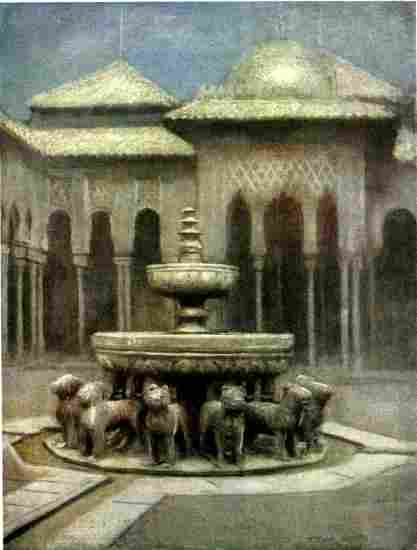
GRANADA—THE COURT OF THE LIONS: MOONLIGHT
This splendid hall and the other apartments adjacent to the Court of the Myrtles are supposed (I know not on what authority) to have constituted the official or public part of the royal residence, together with the apartments demolished to make room for the Palace of Charles V. The rest of the building, on this supposition, was the private or harem quarter. A narrow passage leads from the Court of the Myrtles to the Court of the Lions. "There is no part of the edifice that gives us a more complete idea of its original beauty and magnificence than this," says Washington Irving, "for none has suffered so little from the ravages of time. In the centre stands the fountain famous in song and story. The alabaster basins still shed their diamond drops; and the twelve lions which support them cast forth their crystal streams as in the days of Boabdil. [The fountain nowadays plays only once a year.] The architecture, like that of all other parts of the palace, is characterized by elegance rather than grandeur; bespeaking a delicate and a graceful taste, and a disposition to indolent enjoyment. When one looks upon the fairy tracery of the peristyles, and the apparently fragile fretwork of the walls, it is difficult to believe that so much has survived the wear and tear of centuries, the shocks of earthquakes, the violence of war, and the quiet though no less baneful pilferings of the tasteful traveller; it is almost sufficient to excuse the popular tradition that the whole is protected by a magic charm."
I fancy that the gifted American was himself responsible for that tradition, for the Spaniards, as Lady Louisa Tenison observed sixty odd years ago, are not an imaginative race, and whatever legends or traditions are current relate almost exclusively to the Virgin and saints. Spanish folk-lore knows nothing of fairies and goblins. The palace which Irving tells us the people regarded as enchanted had been used by them for years as a factory, as store-rooms, as a laundry, as a caravanserai. This hardly suggests that it was looked upon with superstitious awe. The truth is that the palace had enchanted Washington Irving, as it has done many others—not natives—since.
The Court of the Lions is an oblong, surrounded by a gallery formed by 124 marble columns, eleven feet in height and placed irregularly, some in pairs, some single. The arches exhibit a similar variety of curve, and the capitals are of various designs. The tile roofing of the galleries rather mars the effect, but the stucco work within them is of the richest and finest description. In the centre of the short sides are two charming little pavilions, with "half-orange" domes and basins in their marble flooring. The court is gravelled, and derives its name from the twelve marble animals that support the basin of the central fountain. These creatures are called lions, but why I am at a loss to understand. They look more like poodles than any other living quadrupeds. Ford humorously remarks: "Their faces are barbecued, and their manes cut like the scales of a griffin, and their legs like bedposts, while water-pipes stuck in their mouths do not add to their dignity." An Arabic inscription reminds us that nothing need be feared from them, as life is wanting to enable them to show their fury. That fury would no doubt have been directed in the first instance at the sculptor who had made of the unfortunate creatures such grotesque caricatures.
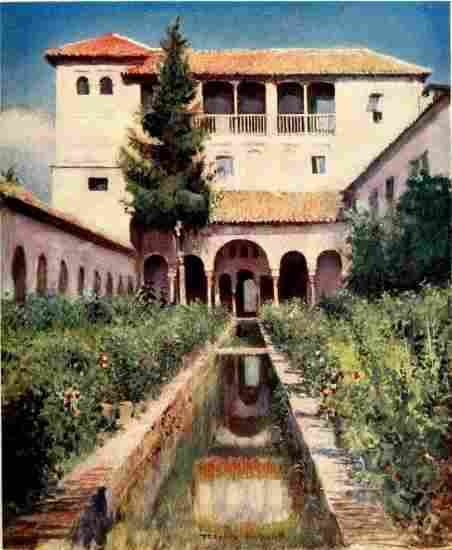
GRANADA—THE GENERALIFE: PATIO DE LA ACEQUIA
The court is surrounded by four splendid rooms—the halls of the Mocarabes, the Abencerrages, the Two Sisters, and of Justice. The second and third resemble each other, and are covered with the most marvellous specimens of the artesonado or carved wood ceiling. The stalactites or pendants, though in reality following a strict geometrical plan, exhibit complications and varieties that it is impossible for the eye to follow. The style may well have been suggested by the honey-comb. It is confusing, beautiful, glorious—certainly the most remarkable achievement of the art of the Spanish Moor. The walls are covered with lace-work in stucco of the most exquisite pattern, with mosaic dados, and friezes decorated with inscriptions in praise of Mohammed V. At the sides of the rooms are the alcoves characteristic of Oriental domestic architecture.
The Hall of the Two Sisters is so called from a couple of slabs of marble let into the flooring. The other chamber derives its name from the thirty-six chiefs of the Beni Serraj tribe, fabled to have been decapitated within it by order of Boabdil. The story was a pure invention of a Ginés Perez de Hita, a writer who lived in the sixteenth century. It has now spread through all lands, thanks to the version of Chateaubriand. The tribe is supposed in this story to have espoused the "Little King's" cause against his father, Mulai Hasan. Later on their chief, Hamet, was suspected of intriguing with the Castilians; and, what was still more criminal in the eyes of a Moslem, of carrying on a love affair with one of the sultanas. A cypress in the gardens of the Generalife is pointed out as the lovers' trysting-place. The sultan resolved to make an end of this pestilent brood, but Hamet himself, warned at the eleventh hour, escaped the fate of his kinsmen. The frail sultana would have shared their fate, had not four champions presented themselves and vindicated her reputation against all comers in the lists. Thus the affair ended happily—except for the thirty-six chiefs. Thus the story. I hope it will stimulate your imagination. For myself, there is an utter absence of the personal and human note about these gorgeous Moorish halls. It is certainly easier to believe that they sprang into existence at the bidding of an enchanter than that they were ever the scenes of men's loves and hates, hopes and fears.
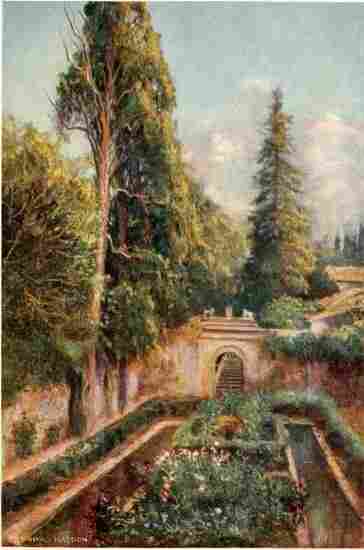
GRANADA—THE GENERALIFE: COURT OF THE CYPRESSES
The Hall of Justice (Sala de la Justicia), at the far side of the Court of Lions, is a long apartment, divided into alcoves specially remarkable for the paintings on its ceiling. These have been the subject of endless controversy. To begin with, it was doubted if a Mohammedan could have painted them, since the representation of living objects is contrary to the injunctions of the Koran. I have it on the authority of a very learned Moslem friend, a recognized authority on Mohammedan law, that the plastic arts are not forbidden by the Prophet, but merely pointed out as a possible snare and stumbling-block in the way of the believer. Painting has been a recognized art in Persia for centuries, and I have seen some pictures from that country which reveal no mean degree of skill. There is therefore no good reason to doubt that these curious works were executed by Moorish artists at the end of the fourteenth century. They are done on leather prepared with gypsum and nailed to the wooden ceiling. The colours (red, green, gold, etc.) are still vivid, but mildew is covering them in parts, and in places the gypsum is peeling off. These valuable specimens of Moorish art ought to have been taken down and placed under glass long ago. The first of the three represents ten bearded, robed, and turbaned personages, who may with some degree of probability be identified with the first sultans of the Nasrid dynasty. According to Oliver, the Moor in the green costume occupying the middle of one side is Al Ahmar, the founder of the race. Then, counting from his right, come Mohammed II., Nasr Abu-l-Juyyush, Mohammed IV., Saïd Ismaïl, Mohammed V. (in the red robe), Yusuf II., Yusuf I., Abu-l-Walid, and Mohammed III. The family likeness between these potentates is striking, and the red beards suggest a liberal use of the dye still largely used by the Oriental man of middle age. The other pictures are more interesting. The first represents hunting scenes. Moors are seen chasing the wild boar, while Spanish knights are in pursuit of the lion and the bear. In another part of the composition the huntsmen are seen returning and offering the spoils of the chase to their ladies. The Moor greets his sultana with a benign and condescending air, the Christian on his knees offers his prize to his lady. In the next picture is another hunting scene, with a page, with sword and shield, leaning against a tree, awaiting his master's return. In another quarter of the picture his master (presumably) is rescuing a distressed damsel from a wild-looking creature who is quite undismayed by the tame lion accompanying his captive. Further on, the same knight is unhorsed and overthrown by a Moorish huntsman, two ladies from a castle in the background most ungratefully applauding the Christian's discomfiture. The pictures evidently were intended to record the incidents of a border warfare not dissimilar to those commemorated in our ballad of Chevy Chase.
In this hall a temporary chapel was set up, and mass was celebrated, on the taking of the city by the Spaniards.
Crossing the Hall of the Two Sisters, we enter the beautiful Mirador de "Lindaraja," the most charming and elegant of all the apartments in the palace. Through three tall windows, once filled with coloured crystals, we look down into the pretty Patio de Daraxa, which, like the chamber, does not derive its name from an imaginary sultana, but from a word meaning "vestibule." It is a delightful garden, where shade is always to be obtained between the closely planted cypresses, orange, and peach trees, rising between twin hedges of box and bushes of rose and myrtle. In the centre is a seventeenth-century fountain. Here you will always find some artist committing to canvas his impressions of one of the fairest gardens men have fashioned for themselves.
The rooms on the other side of the patio were built by Charles V., and include the Tocador de la Reina, or Queen's Boudoir, a prettily decorated belvedere affording an entrancing view. It was in this room that Washington Irving took up his quarters. Théophile Gautier slept sometimes in the hall of the Abencerrages, sometimes in that of the Two Sisters, and was impressed by the eerieness of the palace at night. Yet there is not a manor-house in England or a château in France that is not more suggestive of the spectral and uncanny than these gilded halls and open courts. However, everyone has his own preconceptions of the weird and the picturesque.
From the Patio de Daraxa we enter the very interesting Baths, ably restored by the late Don Rafael Contreras. The Sala de las Camas, or chamber of repose, is among the most brilliantly decorated rooms in the palace, yet, as elsewhere in this neglected pile, the gilding is being suffered to fade and the tiling in the niches, I noticed, is loosening and breaking up. From a gallery running round the chamber, the music of the odalisques was wafted down to the sultan reclining in one of the divans below. He must have been in no hurry to leave this spot, where he dreamily puffed at his hubble-bubble and watched the play of the fountain. The light came from apertures in the superb artesonado ceiling. Without, on a stone seat, the eunuchs mounted guard and preserved their lord's repose from interruption. The actual baths are contained in two adjacent chambers. A staircase ascended to the Hall of the Two Sisters above, for the use, not improbably, of the ladies of the harem. On leaving the baths you may follow the tunnel across the uninteresting Patio de la Reja and beneath the Tower of Comares, to the Patio del Mexuar.
No visitor to the Alhambra must omit to walk round the outer wall or enceinte, and to inspect the towers. The Torre de las Damas, a fortified tower dating from the time of Yusuf I., was inhabited by Ismaïl, the brother of Mohammed V., and marked the palace limits on this side. It contains a tastefully decorated hall. Adjacent to it is a beautiful if gaudy little Mohammedan mihrab or oratory, approached through a private garden. Here was the house of Anastasio de Bracamonte, the esquire of the Conde de Tendilla, to whom was assigned the custody of the Alhambra at the Reconquest. The Puerta de Hierro, a little further on, was restored at the same time, and faces the gate and path leading to the Generalife. Passing the Torre de los Picos, we reach the Torre de la Cautiva, which contains a beautiful chamber, over which a lovely rosy tint is diffused by the tiles and stucco. The Torre de las Infantas, built by Mohammed VII., is a perfect example of an Oriental dwelling-house. Through the usual zigzag vestibule you reach a hall with a fountain in the centre and alcoves in three of the sides. The decoration is perhaps over elaborate. The towers on the other side of the enceinte were, as I have said, intended mainly for defence. Near the ruinous Torre del Agua, at the south-east extremity, a viaduct crosses the ravine from the Generalife, and some of the water precipitates itself over the brow of the hill in a mass of vivid living greenery. Further on, towards the Gate of Justice, is the Torre de los Siete Suelos, through which Boabdil is said to have made his last exit. It is supposed to extend far underground, and to contain much buried treasure. So at least Irving was told by the inhabitants, or possibly told them! Hence issues the Belludo, the spectral pack, which traverses the streets of Granada by night—also according to legend. This story of the Wild Huntsman crops up, in one form or another, in every part of Europe. There are the Dandy Dogs in Cornwall, the Wild Huntsman in Germany, Thibaut le Tricheur in the valley of the Loire, the Chasseur Noir of Fontainebleau, and so on. Folk-lore of this sort is easily fabricated. Foreigners in search of the picturesque ask the natives of such a place as this if ghosts do not haunt the ruins. The guide, anxious to please, says "Doubtless!" The foreigner goes on to tell him of spectres that affect this particular class of building at home; and the guide readily devises a local version of the yarn for the benefit of the next stranger. I have found that the peasantry in most European countries hear of their local traditions and folk-lore first through the medium of books. And these remarks apply with especial force to the people of Latin countries, whom, contrary to the received opinion, I know to be less imaginative and less superstitious than northerners. It is natural that the gloomy forests of Germany and Sweden, rather than the sunlit plains of Andalusia, should generate dark fancies.
Strictly speaking the Generalife, the Trianon of the Moorish kings, is a more beautiful place than the Alhambra, though it has no architectural merit. It became the property at the Reconquest of a Christianized Moor, Don Pedro de Granada, who claimed to be descended from the famous Ben Hud, and from whose family it passed into the possession of the Marquises of Campotejar. The approach lies along a magnificent avenue of cypresses and tall shrubs. Arrived at the entrance you are admitted by a very comely damsel, and allowed to wander about the lovely gardens by yourself and to stay there all day if you like. At the far end of the first court is a poor collection of portraits, among which is one—No. 11—absurdly supposed to be a portrait of Ben Hud (died about 1237), though the person is dressed in the costume of the fifteenth century. This is the portrait which English travellers, and even the usually correct Baedeker, persist in mistaking for Boabdil's.
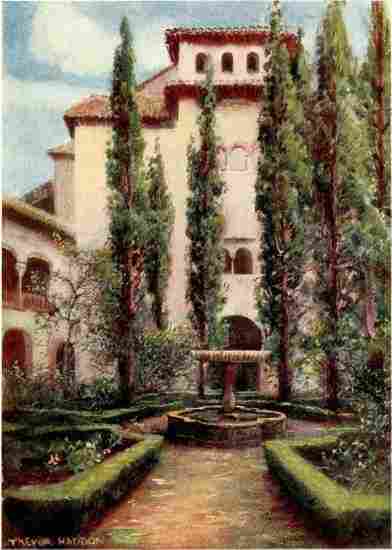
GRANADA—THE GENERALIFE: COURT OF THE CYPRESSES
The gardens of the Generalife are beyond all praise. Water bubbles up everywhere, and moistens the roots of gorgeous oleanders, myrtles, orange trees, cedars, and cypresses—the tallest trees in Spain. Beneath one of these—that to the right as you reach the head of the first flight of steps—the sultana is alleged to have kept her tryst with Hamet, the Abencerrage. Not a bad place, this, for a lovers' meeting. You rise from one flower-laden terrace to another till you reach the ugly belvedere—scribbled all over with idiots' names—whence you obtain a ravishing view of the Alhambra, the city, the Vega, and the mountains. The hours spent in the Generalife Gardens will be remembered as among the pleasantest of one's lifetime.
It may be, as a French writer states, impossible to tickle the surface of Granada without discovering Moorish remains, but certainly, outside the Alhambra, very few are to be seen above ground. The most conspicuous of them in the lower town is, on the whole, the Casa del Carbon, a dilapidated structure with a bold horseshoe archway which confronts you as you cross the Reyes Catolicos near the Post Office. The house is now used as a coal depot, but beneath the thick coating of grime you may discern the traces of graceful decorative work. The building is said to have been a corn exchange in Moorish days. More interesting are the vestiges of the ancient walls that girdled the oldest quarter, el viejo Albaicin. They were built in great part by Christian captives—perhaps by those whose chains are hung up on the walls of San Juan de los Reyes at Toledo. The Moors of Granada grew embittered by their reverses, and treated their Christian subjects harshly. The martyrs whom the monument on the Alhambra hill commemorates are not merely the creatures of pious imagination. There is an ugly story, too, of an unfortunate monk accused of heretical doctrines, who took refuge at Granada and was burnt at the stake by the Moslems.
Two of the old gatehouses on this side of the city are still standing. They are massive crenellated towers, pierced with round-headed archways. I do not consider them entrancingly picturesque; they form the northern entrances to the Albaicin quarter, which is now a perplexing congeries of squalid houses, formless convents, and churches tottering to their fall. Whatever interest its antiquity may excite is lost in disgust at its wretchedness. On the outskirts dwell the gipsies—mostly in semi-underground burrows, and left very much to themselves by the local authority. These are the poor creatures who are dragged out to bore visitors with their wearisome dances, the fee charged for which goes almost entirely into the pockets of the guides. The gipsies of Spain are not nomadic. There are people in Granada who wish they were.
In the Albaicin the Zirite sultans had their palaces, one of which was called the House of the Weathercock, from the bronze figure of a horseman that surmounted it and served as a vane. Washington Irving has written a story about it. Fragments of all these ancient buildings are incorporated with modern houses, and may be identified by those who care to take the trouble. Romantic legends (of the precise nature of which I am ignorant) cluster round the Casa de las Tres Estrellas, possibly because it affords ingress to a subterranean passage leading no man knows whither. But I do not think you will be tempted to linger long in this odoriferous, wormeaten quarter. You may be said to have escaped from it when you reach the picturesque Carrera de Darro, the embankment of that narrow stream facing the Alhambra. Here may be seen a Moorish bath at one of the private houses, and—much more delightful to the artist—a broken Moorish bridge, the Puente del Cadi, to which a path led down from the Torre de las Armas. Against the little church near this point you will notice a white corner house with a handsome doorway in the Renaissance style. At the angle of the house is a balcony, bearing the odd inscription, "Esperandola del Cielo" ("Waiting for it from Heaven"). The words are accounted for by the following story: The house was built by Hernando de Zafra, the astute secretary of Ferdinand and Isabella, and the negotiator of the capitulation of Granada. He suspected his daughter of a love affair with an unknown cavalier. To satisfy his doubts he surprised her one day, and found his page assisting the lover to escape by the window. Baulked of his prey the enraged father turned upon the lad. "Mercy," implored the page. "Look for it in Heaven!" answered the Don, as he hurled his daughter's accomplice after her lover into the street below. There are those who say that De Zafra had no daughter, and that he has been libelled in this matter. But the episode is more probable than the foreign-made yarns about the Alhambra.
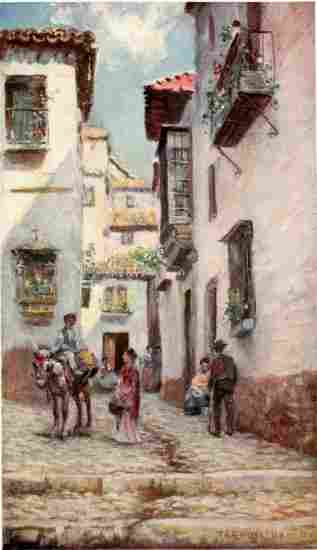
GRANADA—STREET IN THE ALBAICIN
The rivers of Granada are more spoken of than seen. At the foot of the Alhambra the Darro disappears, its channel through the town having been roofed over at different epochs. Till the middle of the last century the houses of the Zacatin looked at the back upon the stream, as may be seen from a picture by Roberts in the South Kensington Galleries. There was a local proverb which said "Ugly as the back of the Zacatin," an evidence of the persistent confusion of the ugly and the picturesque. This part of the stream is now covered by the Reyes Catolicos Street. The famous Zacatin—a lane-like thoroughfare, like those we have seen in Seville—was once the principal street in Granada, and seems to have been full of animation in Gautier's time. That brilliant Frenchman speaks of meeting there parties of students from Salamanca, playing as they went on the guitar, triangles, and castanets—truly a singular mode of taking one's walks abroad, such as even the Spaniards of the 'thirties and 'forties must have marvelled at exceedingly. Are we to understand by this remarkable passage that the alumni of Salamanca formed processions like those of the Salvation Army, whenever they met by chance in the public street, or that, like the fine lady of Banbury Cross, they were determined to move nowhere without a musical accompaniment? At all events, the Zacatin is quiet enough nowadays. It still contains some of the best shops in the town and is one of the few comparatively shady walks outside the precincts of the Alhambra. It leads you to the far-famed Plaza de Bibarrambla, with the name of which we have been familiarized by Byron's rendering of the Spanish ballad, "Ay de mi, Alhama!" The square, like so much else in Granada, has been so completely modernized that nothing remains to recall the days when the sultans here assisted at pageants and tournaments, wherein Christians often took part. It is edifying to learn that Spanish knights, forbidden in their own country to cut each other's throats, often resorted hither to do so, by gracious permission of his Moorish Majesty.
We are now in the neighbourhood of the second great sight of Granada—the Cathedral with its adjoining buildings. The church called the Sagrario is an eighteenth-century structure immediately adjoining the west front of the Cathedral, on the south side, which served for a time as the metropolitan church of Granada. The interior is sombre, heavy, and Churrigueresque—a style which, it always strikes me, might have been devised by an undertaker accustomed to a high-class business. One of the chapels, however, is interesting. It contains the bones of "the magnificent cavalier, Fernando del Pulgar, Lord of El Salar," as the inscription records. This gallant knight, during the last siege of Granada, penetrated into the city with fifteen horsemen, and nailed a paper bearing the Ave Maria on the door of the mosque. This brave exploit earned for him and his descendants the right of remaining covered in the Cathedral and before the king. In Philip II.'s time the Marqués del Salar, the representative of the family, was fined for appearing covered before the High Court of Granada. He appealed to the king, invoking the privilege conferred on his ancestor. "Not so," replied Philip; "you may wear your bonnet in the presence of the king, but not in the sacred presence of Justice." With the fine was built the staircase in the Audiencia in the Plaza Nueva.
Behind the Sagrario is the mausoleum of Ferdinand and Isabella—the Capilla Real—a temple peculiarly sacred in the eyes of all good Spaniards. The two great sovereigns lie here in the heart of the city which they recovered for Christendom, even as many great soldiers have caused their remains to be buried on the sites of their greatest victories. The chapel, founded in 1504 and completed in 1517, is a noble example of late Gothic. The exterior is very simple, the decoration consisting mainly of two highly ornate balustrades, surmounting each of the two stages. The well-known devices and monograms of the founders are interwoven with the decoration. Through a portal flanked by the figures of heralds we enter the chapel—plain, bright, and airy. The chancel is railed off by a magnificent grille of gilt ironwork, wrought by Maestre Bartolomé of Jaen, in 1522. Between this and the altar are the superb tombs of Ferdinand and Isabella, and of their daughter Joanna and her husband, Philip I. The former is ascribed to a Florentine sculptor, Domenico Fancelli.
The recumbent effigies of the Reyes Catolicos are full of expression and majesty. Both wear their crowns, and Ferdinand is in full armour. At the angles of the tomb are seated figures, and the sides are sculptured with medallions and escutcheons and the figures of angels and saints. The figures of the unhappy Joanna and her Flemish consort are less lifelike, and the decoration is much more florid. It must be admitted that the Renaissance character of these sepulchral monuments contrasts rather oddly with the Gothic surroundings. The kneeling statues of the founders at the sides of the altar are believed to be actual likenesses. The reliefs on the retablo, by Vigarni, represent the surrender of Granada and the subsequent baptism of the Moors. In the former, both the sovereigns are shown, in the compan y of Cardinal Mendoza, receiving the keys from Boabdil; in the latter, we note that the candidates for baptism are so many that the rite is being administered by means of a syringe.
Beneath the tombs is the vault containing all that was mortal of the makers of Modern Spain. The sacristan thrusts a lighted taper forward into the gloomy abode of death, and you are able to distinguish five coffins—those of Ferdinand and Isabella, Philip, Joanna, and the Infante Miguel. Philip's coffin, it will be remembered, was carried about by his lovesick widow till she had to be parted from it by force. The coffins are rude, bulging, and almost shapeless. One only, that of Ferdinand, can be identified, and this only by the simple letter F upon it. Might not this stand as well for Felipe?
The sacristan next shows you the treasury of the chapel. Among the relics are the crown, sceptre, and mirror of Isabella, her missal beautifully illuminated, and the standard embroidered by her that floated over the city. A casket is shown which was filled with jewels which she pawned to procure funds for Columbus's first voyage of discovery. Few investments have proved more profitable, as far as material wealth is concerned. You may also see Ferdinand's sword, rather interesting to those curious in ancient weapons.
The Royal Chapel is quite independent of the immediately adjacent Cathedral. The chaplains have a right of way across the Cathedral transept to the Puerta del Perdon, a privilege deeply resented by the chapter. Once when the Archbishop wished to visit the chapel, his attendant canons were refused admission. The irate prelate caused the chaplains to be arrested for this affront, and a long lawsuit followed. But all this happened a long time ago, and it is to be hoped that the two bodies of clergy now live upon good terms with each other.
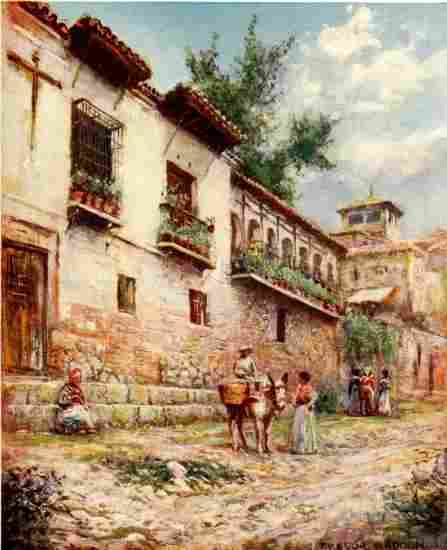
GRANADA—OLD HOUSES, CUESTA DEL PESCADO
A very beautiful arch, richly and tastefully adorned with statues, admits to the Cathedral. This church, described by Fergusson as one of the finest in Europe, was begun by Diego de Siloe, about 1525, and not completed till 1703. The exterior is far from corresponding to the majesty of the interior, though the Puerto del Perdon, already referred to, on the north side, is a beautiful piece of work. The impression produced on entering the Cathedral is rather similar to that experienced on entering St. Peter's. There is an atmosphere of loftiness, luxury, and cold purity—like that clinging to the finest classical works. This is certainly the triumph of Spanish Renaissance architecture. The effect is, of course, utterly different from that of the grand old Gothic fane of Seville. Like all Renaissance churches, as it seems to me, it lacks the devotional atmosphere. The nave, as usual, is obstructed by the choir—where, by the way, Alonso Cano was buried. The dome above the chancel is sublime, the daring of the arches wonderful. The altar is completely insulated by the ambulatory.
Before it are the grand sculptured heads of Adam and Eve by Cano. His also are seven of the frescoes decorating the upper part of the dome. The others are by his pupils. The Cathedral contains much of this irascible and wayward artist's best work. In the chapel of San Miguel is a "Virgen de la Soledad," in whose human beauty and pathos his genius finds its highest expression. In the chapel of Jesus Nazareno, Cano's "Via Crucis" does not suffer by comparison with three works of Ribera and a "St. Francis" by El Greco. The artist's studio may be seen in one of the towers flanking the west front of the Cathedral. He was a native of Granada, and a lay canon of the chapter. He died in poverty at his house in the Albaicin quarter, aged 66 years, on October 5, 1667. He was a man of hasty but not ungenerous temper, and in some of his phases of character recalls Fuseli. Justice has hardly been done to his great talent, of which he himself seems to have entertained an exaggerated estimate.
The minor churches of Granada are not of very great interest. The church of San Geronimo was built by the Great Captain as a mausoleum for himself and his wife, but such of his remains as escaped the ghoulish spoliation of the French have been transported to Madrid. The church is no longer used as a place of worship. The retablo is remarkable, and in it may be traced the dawning of Siloe's ambition to create a true Spanish Renaissance style. The church of San Juan de Dios, not far off, is filled with tawdry rubbish, petticoated crucifixes, etc. Here is buried the titular saint, a Portuguese, Joao de Robles, who in the seventeenth century devoted himself with so much energy to the sick and suffering that his contemporaries esteemed him mad. You may see the cage in which he was confined at the hospital founded by Isabella the Catholic on the arid, ugly Plaza de Triunfo, near the Bull Ring. A column in the middle of the square marks the spot where Doña Mariana Pineda was publicly garrotted in 1831. This lady is the great heroine of Granada. She perished a victim to the reactionary tendencies then prevalent in Spain. Spaniards were then crying "Hurrah for our chains!" and Doña Mariana's house was known to be a rendezvous of the Liberals of Granada. On raiding her house the police discovered a tricolour flag. This was evidence enough, and in the thirty-first year of her age this beautiful and accomplished woman suffered a shameful death. A few years later, when the nation had recovered its sanity, the magistrate who had condemned her was shot, and her remains were transported with great pomp to the Cathedral, where they have been interred close to Alonso Cano's. A monument has also been raised to her memory in the Campillo Square.
There is another story connected with the Triunfo worth telling, though it is not very well authenticated. The remains of royal personages on their way to the Capilla Real were here identified by the officers of the court. The Duke of Gandia was present on such an occasion, and was so impressed by the evidences of mortality when the coffin was opened that he vowed he would never again serve an earthly master. He entered the Society of Jesus, and after his death was canonized under the name of St. Francis Borgia. The story is a curious and suggestive one, as also is that of the duke praying that his wife might die if it were for his soul's good. St. Francis Borgia has always seemed to me an extreme example of other-worldliness.
A dusty road through most uninviting surroundings leads to the Cartuja, or Charterhouse, founded in 1516 by the Great Captain. The cloisters are painted with scenes of the martyrdom of the Carthusian monks in London by the minions of Henry VIII.
The church is an extraordinary edifice. Its style is damnable, but it is gorgeous and dazzling to a degree which compels admiration. The doors of the choir are exquisitely inlaid with ebony, cedar, mother-of-pearl, and tortoiseshell. The statue of Bruno is by Cano. In the sanctuary behind the altar coloured marbles, twisted and fluted, are combined in extravagant magnificence. Some of the slabs are richly veined with agate, and the hand of nature has traced some semblances of human and animal forms. In the adjoining sacristy are some wonderful inlaid doors and presses. They must surely be the finest works of their kind in the world. It is strange that so much genius for detail and so much costly material should have been combined to produce so tasteless a building.
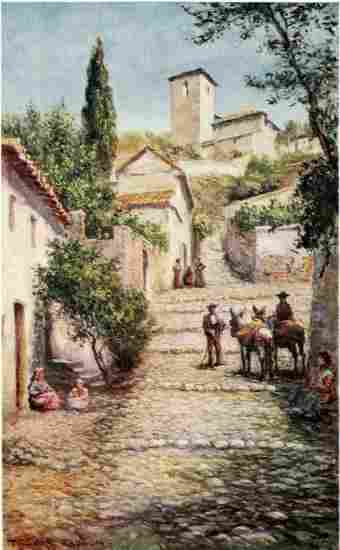
GRANADA—STREET IN THE OLD QUARTER
Outside this church there are not many places in the vicinity of Granada worth a visit. The church of Sacramonte looms rather prominently in the landscape, and you are to some extent rewarded for the trouble of a pilgrimage thither by the fine view of the city. The hill contains some caves in which, in the year 1594, one Hernandez professed to have discovered certain books written in Arabic characters on sheets of lead. The find was reported to the archbishop, Don Pedro Vaca de Castro, who examined the books and declared them to contain the acts of the martyrs, Mesito and Hiscius, Tesiphus and Cecilius, put to death by the Romans and buried in the caves. His grace's pronouncement was not considered final, and theological opinion was sharply divided on the subject for many years. At last the continuance of the controversy was forbidden by Papal decree. It seems that doubt is now thrown even on the existence of the martyrs. The church built over the place of their supposed sepulchre was for a time famous as a shrine of pilgrims. The usual rock worn away by the kisses of the devout is shown. There is a superstition that a person kissing the stone for the first time will be married within the year, if single, and released from the conjugal tie if already married. As divorce does not exist in Spain it is to be hoped that few discontented Benedicts have recourse to this stone.
St. Cecilius, at all events, was known to fame before the alleged discovery of his grave; for in the Antequeruela quarter an oratory dedicated to him existed throughout the Moorish domination, and was the only Christian place of worship within the city. I do not think that any trace of it is to be detected now. In that part of the city is the Casa de los Tiros, where you must apply for tickets for the Generalife; it is worth seeing on its own account, and it is the repository of the sword of Boabdil, which seems to have more claims to authenticity than most of the relics of the Little King. Descending towards the Puerta Real we pass the Cuarto de Santo Domingo, a private villa in which is incorporated all that remains of an Almohade palace. Near by, against the church of Santo Domingo, is an exceedingly picturesque little archway where one can fancy a bravo waiting, stiletto in hand. The Campillo, in the centre of which rises the statue of Mariana Pineda, is a quiet little square enough, referred to (as the Rondilla) by Cervantes as a resort of adventurers and desperadoes. These gentry are now more likely to be found in the immediately adjacent Alameda, outside the hotel of the same name, where the cafés and tables spread in front of them seem exceedingly well patronized.
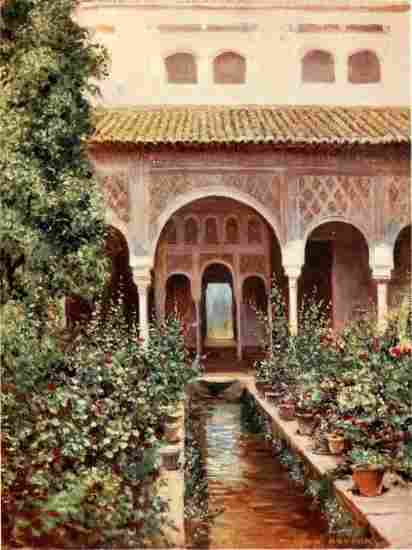
GRANADA—THE GENERALIFE: PATIO DE LA ACEQUIA
Following the Genil, and leaving the unimpressive monument of Columbus and Isabella to the left, you reach, after a walk overpoweringly fatiguing in summer, the little Ermita de San Sebastian. This was a Moorish oratory in old days, and outside it took place the surrender of the keys by Boabdil on the memorable 2nd of January, 1492. If you go farther on—and I doubt if you will be tempted to—you will come to a very old Moorish palace called the Alcazar Genil, now the property of the Duke of Gor. Here, says Simonet, were lodged the Christian princes and knights who so often found an asylum at the court of Granada. In the gardens are tanks once used, it is believed, for mimic naval fights. In the same direction, I understand, is Zubia. Here Isabella the Catholic, reconnoitring the city during the siege, narrowly escaped capture by a Moorish patrol. She concealed herself behind a laurel bush, which is still pointed out. Another instance of the small chances that determine the fate of kingdoms! To commemorate her escape the queen built near by a convent, which has long since disappeared.
You may return to the city by the Puerta Verde, near the Bab-en-Neshti or Puerta de los Molinos, through which the Spaniards entered after Boabdil's submission.
Apart from the Alhambra and the Cathedral buildings, it will have been seen that Granada has not many claims on the stranger's interest. Considering the expectations formed of it after reading Prescott and Irving, most English people will pronounce it to be a disappointment. From certain points of view it remains the pleasantest place for a protracted stay in Andalusia during the summer. It is only when you come to it from Seville or Cordova or Cadiz, that you realize how cool, in comparison, is this city on the plateau between the snow-clad mountains. Even before the sun has gone down, you can dine very pleasantly in the open, hearkening to the splash of the fountains, and inhaling the fragrance of the rose. There is no need here, as at Seville, to shut yourself, till nightfall, within walls three feet thick. By night we stroll across the Plaza of the Alhambra, and see the white city gleaming with a shimmer reflected in the luminous sky above. Granada resumes her aspect of an Oriental city beneath the crescent moon riding triumphant over Andalusia.
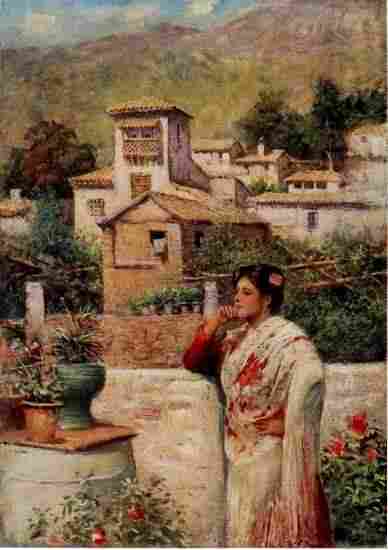
GRANADA—A CORNER IN THE OLD QUARTER
CHAPTER V
MALAGA
SECOND in size among Andalusian cities, Malaga is the least interesting. Were it not for the sea, its position would be one of singular remoteness. On the extreme verge of Europe, the mighty Sierra Nevada rises behind it, and cuts it off from the rest of Spain. Yet as a flourishing port it is one of the towns in the Peninsula best known among Englishmen. It is beloved by our sailors. From the odd phases of life to be seen in and around the harbour, they derive their notions of the people and the country. With that utter absence of curiosity noticeable in their kind, they never penetrate inland, or even into the outskirts of the town. But nothing can dispel Jack's conviction that his knowledge of Spain and the Spaniards is intimate and profound.
Malaga is not, as its appearance suggests, a city of purely modern growth. It was known to the Phœnicians and the Romans, and before it became subject to the Almoravides was an independent principality under the Hammudiya dynasty. Later it shared the fortunes of the Sultanate of Granada, and its siege and capture by Ferdinand and Isabella contributed to bring about the fall of the capital. This part of its history is dealt with in great detail by Prescott. Among the numerous incidents of the siege was a determined attempt on the part of a Moor named Ibrahim al Gherbi to assassinate the Spanish sovereign. The defence was conducted by the indomitable Hemet el Zegri, who yielded to famine rather than to the arms of the besiegers. The treatment of the fallen city leaves an indelible blot on the fame of the conquerors. The population, with the exception of a few hundreds, were sold into slavery, presents of the fairest maidens being made to the various courts of Europe. A worse fate was reserved for the Jews and renegades, who were committed to the flames.
The old Moorish fortress of Gibralfaro still frowns down on the lively city to remind us of those days. Some of the walls and towers are believed to be of Phœnician origin. The stronghold has undergone repeated restorations and adaptations to military requirements, but a great deal of Moorish work may still be detected. A horseshoe arch behind the Paseo de la Alameda serves to identify the Moslems' dockyard or Atarazanas, and to indicate how far the sea has receded in the wake of the banished race southwards towards Africa.
The Cathedral towers high above all the other buildings of the city. It is in the Classical style, and though designed by Diego de Siloe in 1528, was built for the most part in the early eighteenth century. It must be confessed that it looks better at a distance than near. The interior is solemn and cold. It is worth visiting for some specimens of Cano's art which it contains, and for Mena's magnificent carving in the choir. As at Granada, the edifice is adjoined by a smaller church called the Sagrario, founded by the Catholic Sovereigns in 1488 as the cathedral of the conquered city.
But it is not for its monuments or historical associations that Malaga is to be visited. Its interest is of to-day. And in truth it needed not the hand of man to embellish a spot where Nature has been so lavish of her choicest gifts. The gardens round Malaga abound in the finest specimens of tropical flora. Tall india-rubber plants, gigantic eucalyptus, great bamboos, the rarest exotics, such as the Pritchardia folifera, the araucaria, and the Scaforthia elegans, flourish on this favoured shore. The villas of the wealthier classes stand each in a veritable Paradise. And everywhere the white flower of the orange, the oleander, the vine, and tree-high ferns!
This luxuriant vegetation is the less to be expected since want of water is the great drawback to the prosperity of the district. Through the middle of the town runs the Guadalmedina—a broad channel, without a drain of water! The new and magnificent promenade, planted with palms, sweeps round the sea-front, as fine as anything on the Riviera. To drive along it in the sensuous southern night is to drink a deep draught of the joy of life. At one point the drive descends into the bed of the river, along which you may proceed for a mile or more. And yet at times the Guadalmedina becomes a roaring torrent, bursting its banks and sweeping away farmsteads and stock. It is difficult to say whether flood or drought has done most damage to the province.
As at Seville, you find life here focussing in lane-like streets, closed to vehicles, and lined with cafés and casinos, among the finest I have seen in Spain. Here to an early hour of the morning the men of the city gossip in garrulous, intimate groups of nine and ten, all, as it seemed to me, talking together. The number of cigarettes smoked during the progress of these tremendous conversations must be stupendous. As you will see the same group meeting night after night, you wonder what there can be in the outwardly uneventful round of life of Malaga to supply topics for conversation. To an Englishman there is a mystery about this ability to talk for five or six hours about nothing at all. You will see the same thing in the dullest provincial towns in France and Italy—the same groups of stout, bald-headed citizens talking with frantic animation every evening. Their newspapers afford the slenderest mental pabulum—their contents could be dismissed in ten minutes—and the respectable gentlemen in question are never seen to read books. How then do they recruit their stock of ideas and find an inexhaustible stock of topics for conversation?
Women are, of course, conspicuous by their absence. Here we have another illustration of the utterly false ideas Englishmen usually entertain concerning Latins. To judge from novels written fifty or even thirty years ago, John Bull appears to have regarded the foreigner with pitying contempt as a mere philanderer, always running after a petticoat; yet no one can be in Spain a fortnight without noticing the Spaniard's disinclination for female society, or at any rate how perfectly content he is without it.
I do not fancy the ladies of Malaga care very much for society either, in our acceptation of the word. Looking out of the window appears to be their favourite recreation. They do not inherit the habit from the Moors, for that people, as I have said, were nearly all expelled at the Reconquest, and the town was resettled. All the Andalusian towns were wholly or in part emptied of their Mohammedan population when taken by the Christians, and repeopled with Castilians and others from Northern Spain. This fact is forgotten by those who recognize in every trait of the Andalusian a heritage from the Moor. We might as well think we derive our chief national characteristics from the Britons or the Normans.
East of Malaga lie several coast towns of importance, within whose gates the traveller rarely sets foot. Motril, Adra, Almeria—what is there in them to reward the fatigue of a journey in a diligence along the parched shore, or in some crazy coasting craft, with timbers straining and creaking before the lightest breeze? Almeria is now connected directly by rail with Madrid and Granada. The prosperity of the whole district is bound to be greatly increased by the construction of the line so long promised from Guadix to Baza. This short link in the railway system would save the traveller from Malaga to Valencia nearly 180 miles, or its alternative—a long and exhausting diligence journey. It would also bring the southern parts of Andalusia into direct communication with the great commercial centres of eastern Spain and with Marseilles. It would supply us with a new route to Gibraltar, moreover. This, with a line from Jaca across the Pyrenees into France, and another from Huelva to connect with the Portuguese system Villa Real de São Antonio, are links of which Spain stands vitally in need.
CHAPTER VI
THE WAY SOUTH
AT Bobadilla—the Clapham Junction of Andalusia—the Spanish railway system is joined by the line of that purely British undertaking, the Algeciras Railway Company. A Spaniard told me that this line would never have been built by one of his countrymen, as no one in Spain had any desire to facilitate Gibraltar's communication with England, and the country it traversed had been sufficiently opened up. I do not think it would be difficult to demonstrate that the line may prove of very substantial benefit to Spain, but I will confine myself to thanking the promoters for having rendered accessible certainly the most beautiful part of Andalusia, and in my opinion one of the most wildly picturesque regions of Europe. The country between Ronda and Algeciras is the Andalusia dreamt of by the romancers. It is a savage, silent country, of warmer browns and greens than the rest of Spain. Here the train takes you no longer across the scorched sky-rimmed plains, but along the very edge of dizzy ravines, at the foot of which, hundreds of feet below, angry white torrents foam and froth. Now you are climbing with obvious effort the steep shoulder of a mountain, now you are racing headlong down into a valley which seems to lie almost vertically beneath you. Now you plunge into the bowels of the Sierra and emerge with a shriek of triumph in a cauldron-shaped valley, from which Nature has provided no egress. There is no want of verdure; the cork-woods, vineyards, and olives dot the lower slopes of the tawny hills. And far up against the sky-line loom shattered towers and crumbling castles, whence you seem to see trains of steel-clad knights issuing forth to do battle with the Moor.
The country is reminiscent essentially of the days of chivalry. Perhaps the ruined strongholds and the dark gorges are still haunted by the knights, who have driven away all other ghosts and will not let us think of anyone but them. The Romans were once here, and at Munda, as every schoolboy knows, Cæsar defeated with great slaughter the army led by the sons of Pompey. That town has now been identified with Ronda, the romantic capital of this most romantic region. Here the people have not forgotten Rome. They will show you a cave where in the semi-darkness you descry awful forms in stone, seeming like a ghostly and gigantic choir of monks. These are the Roman priests turned to stone upon the downfall of their gods, those of the people who cherish tradition will tell you.
The town itself you will not find very interesting, though the escutcheons displayed over every second or third house in one quarter will evoke some reflections on departed glory and the fall of the mighty. In some such solar our novelists Seton Merriman and Mr. Mason have laid the scenes of leading episodes in their two charming romances. Ronda has had a stirring past. She shared in all the vicissitudes of Granada, and towards the end of the long agony of the Reconquest was the scene of constant and ferocious border warfare.
It was here that Mohammed V. received the head of his rival Abu Saïd, who had been put to death at Seville by Pedro the Cruel. The town was taken by the army of Ferdinand and Isabella on May 22, 1485. The people of the surrounding mountains were deeply attached to the creed of Islam, and rose in revolt in 1501 against their Christian oppressors. Before they were crushed they inflicted a severe blow on their adversaries, completely wiping out a force under Don Alonso de Aguilar. Westward, on the other side of the high mountains, lies Zahara, the capture of which one December night by Mulai Hasan was the signal for the last crusade against the Spanish Moors of Granada.
But it is to its striking situation that Ronda owes its interest. Fitted rather to be the eyrie of eagles than the abode of men, it looks down from the verge of precipitous cliffs nearly three thousand feet above sea level. Midway, town and rocky hill are cleft asunder by the Tajo, an awful gorge, two hundred feet across, and twice as much in depth. Gazing down into the abyss, you realize with something of a shudder that a pebble dropped over the edge of the precipice would fall sheer and plumb, without rebound or ricochet, into the river Guadalevin, which rushes below, filling the chasm with foam and spray. The ravine is spanned by a bridge built in the eighteenth century, a wonderful construction, from which when it was near completion its architect fell headlong. Access to the river may be obtained by a flight of 365 steps called the Mina, hewn through the rock. This singular work was executed by the Moors, who thus ensured themselves a supply of water against the dangers of a siege. Numerous subterranean chambers are also ascribed to them, or rather to their Christian captives.
But the most delightful spot in Ronda is the little Alameda laid out on the edge of a perpendicular cliff. Leaning on the railing you may drink in the beauty and grandeur of a prospect hardly surpassed in Europe. The fair fertile country below is shut in by an amphitheatre of mountains which soar upwards to heights of five and six thousand feet. The eye seeks in vain for an outlet from the valley, till it discerns the white, dusty high-road winding, doubling, and finally disappearing over a dip between the ranges. The river, a thousand feet below, swirls and gurgles among the rocks, glad to have escaped from the dark gorge to which it has so long been confined.
In the evenings the air is keen at Ronda, and in summer you may often hear English spoken by officers of the garrison of Gibraltar and their families, who come here to escape the torrid heat of the Rock. With a little capital and energy the place might be developed into a flourishing health resort.
But now the way lies south and seaward. Ever downwards slowly travels the train. The night gathers over the castled crags and the mysterious forests. We detect by their gleam the rivers over which we pass. But now a bright starlike light is seen to the southward. It flashes and is gone, to reappear the next instant. We are nearing the strait, and the searchlight tells us that Britannia watches here with unsleeping eyes over the fortunes of her children in two seas and two continents.
CHAPTER VII
THE KINGDOM OF MURCIA
THE province of Murcia resembles the home of the Arab race more closely than does any other part of Europe. It is a wild, fierce region, hot and tawny like a lion's hide, furrowed by deep winding ravines, intersected by serrated mountains, on whose flanks, for the heat of the sun, no green thing can grow. Much of the land is occupied by plateaux, bare and rocky like great altars on which all that lives is offered to and consumed by the sun. From these uplands you survey vast expanses of sheer desert—fulvid, rocky, and scorching. Your gaze may travel far before you descry any fitting resting-place for man. The mountains afford no shade, even in the deepest cañons the streams are often traceable only by a narrow path of sand and pebbles, yet here and there has man successfully wrested from harsh Nature a secure foothold, an oasis kept ever green by some more constant rivulet. The waters of the Segura and the Sangonera are the life-blood of the province. Wayward and Arethusa-like, the rivers have with infinite pains been coaxed into conformity with the needs of man. To the science of irrigation the province owes its existence. Water here is above all things prized and sold like treasure to the highest bidder. Mr. Jean Brunhés in a lately published work gives some most curious and interesting particulars relating to the system of irrigation in force in Murcia and the adjoining province of Alicante. The volume of the Monegre is divided into old water and new water, the former belonging of right to the ancient riparian proprietors, the latter to the owners of the locks and reservoirs. A very vicious system prevails at Lorca. There a private company is the owner of all the water of the Guadalentin, subject to the condition of supplying the old proprietors of the adjoining lands with 500 litres per second every day. In consequence, in times of drought the company is mistress of the situation and can force up prices to a figure absolutely ruinous to the cultivators. Only in this way can it make good the losses incurred in rainy seasons. The precious fluid being sold, too, by public auction, the rich farmer is in a position to deprive his poorer rivals of their means of subsistence. To palliate this evil to some extent, the rule now obtains that the bidder who has bought the first lot can buy as many of the lots following as he may desire at the same figure. The price therefore is not forced up too rapidly. Moreover, if the company's barrage at a certain point is swept away or broken through by the current, the water which thus escapes becomes public property. This accident occurs five or six times a year, and the company is not allowed to make the barrage any stronger when it is rebuilt. Notwithstanding these concessions, it seems that the principle of private enterprise has been pushed too far in this part of the world.
Mr. Brunhés described the sale of water at Lorca in the following words:
"The sale takes place in a badly-lit hall with naked walls, on a level with the street, with which it communicates by an immense door almost its own breadth. This door remains open during the sale and the crowd of bidders stand partly in the street. The hall has no floor—you stand on the bare ground. Opposite the door at the end of the hall is a railed-off dais entered by a side door, and without any direct communication with the public side. On the dais the secretaries are seated at a large table covered by a threadbare green cloth. Behind the table are five arm-chairs. In one is seated the presiding officer (a civil engineer who must own no land in the 'Vega'). On a stool is stationed the crier.
"At eight o'clock in the morning, at a sign from the presiding officer, the crier pronounces these words in a singing monotonous voice and without any pause between the two phrases: 'In honour of the Holy Sacrament of the altar, who buys the first lot of Sotellana?' Immediately shouts go up 'Eight, nine, ten reals!' One voice overpowers the other, wide-open mouths vociferate loudly, necks are strained, muscles grow tense with excitement. The bidders press and crush each other against the iron railing, for the one nearest has the best chance of being heard. The presiding officer listens, and follows the frantic shouting with sovereign calm. Suddenly, with a quick gesture, he designates the highest bidder. At once the clamour ceases. Amid absolute silence the man indicated calls out his name, which the clerks write down.
"The men are hatless. Some wear black or dark-coloured handkerchiefs bound round their heads, but all hold their broad-brimmed hats in their hands. No one smokes or talks till the bidding recommences, and even those in the street are silent and bare-headed. It is easy to see that all are peasants. Heads are closely cropped; here are no beards or moustaches, no one wears a collar, and most carry a cloak other than the aristocratic 'Capa' on the shoulders or arm. It is a curious and impressive sight enough, these bronzed physiognomies animated by one desire to obtain possession as cheaply as may be of the supreme good, water."
Before the industry of man had harnessed the wayward streams this hot land must have been little better than an arid wilderness, yet it has been inhabited from the remotest times, and its possession was keenly contested between the great powers of antiquity. The natives were known to the ancients as the Mastiani, and are credited with the virtues which were so long supposed to have been characteristic of primitive man. This simple, blameless race fell an easy victim to the wily Phœnicians, who scented the precious metals within these barren hills. Elche, Guadix, and Jijona betray in their etymology a Semitic origin. Next came the Greek Vikings from Samos and Rhodes and Phokaia, establishing themselves at many points along the eastern shore of the Iberian land. The rivalry between the Phœnician and Hellenic colonies precipitated a contest between their respective allies, the Carthaginians and the Romans. Hasdrubal founded the port of New Carthage, the name of which is still preserved in Cartagena, whence, with a host of 90,000 foot and 12,000 horse, Hannibal started on his famous march to Rome. The fall of the city, which was bravely defended by Mago against Scipio, entailed the destruction of the Punic power in Spain.
Under the Roman yoke Carthago Nova became the capital of the vast province of Tarraconensis, and the adjoining district in consequence felt the full force of all the attacks made by rebels and barbarians on the tottering empire. Under the Visigoths it was erected into a duchy by the name of Aurariola. The Duke Theodomir, unlike most of his peers, offered a strenuous resistance to the Moslem arms, and when defeated in battle and besieged in Orihuela, succeeded by a stratagem in preserving his territory. By disguising all the women as warriors and parading them on the walls, he so deceived the Moors as to the strength of the garrison as to obtain from them a recognition of the independence of the duchy, subject to the suzerainty of the khalifa.
The province became known after its chief by the name of Todmir. It endured as an autonomous state for some sixty-eight years, its final absorption in the Moslem empire being brought about by the last dukes espousing the cause of Charlemagne or his Moorish allies. Arabic colonists poured in and soon out-numbered the Christian inhabitants. The last province of Spain to bow before the Crescent became rapidly the most Moorish of any.
Cartagena and Orihuela, the old Visigothic centres, declined, and Murcia, practically a Mohammedan foundation, took their place. The city rivalled Toledo and Cordova as a manufactory of arms and munitions of war. It underwent the usual vicissitudes of Moorish states, forming now part of one kingdom, now of another, at times independent, more often subject to Valencia, Granada, or Cordova. Finally, in 1243, Abu Bekr, the titular amir of Murcia, acknowledged the suzerainty of Castile, only to repudiate it in 1252. The war lasted some time, but the desertion of Al Ahmar of Granada left Abu Bekr at the mercy of the Christians. Murcia was taken in 1266 by Don Jaime of Aragon, who immediately handed over his conquest to his son-in-law, Alfonso of Castile. The step, though probably not dictated by motives of policy, was a wise one, for it left a sort of buffer state between Aragon and Granada, and preserved the frontiers of the former kingdom from molestation by the Moors for the next two centuries.
The town of Murcia has completely rid itself of all outward evidences of its erstwhile subjection to Islam. Gone is the Alcazar, where the amirs mimicked the state of Cordova and Toledo, gone is the wall which kept the Christian out, gone is the mosque wherein thousands of turbaned heads were bowed daily towards Mecca. Yet in the narrow dark streets like the Sierpes of Seville, across which awnings are stretched, we might recognize something of the East, were not such thoroughfares equally characteristic of the Christian South. The Calles de la Traperia and de la Plateria, however, irresistibly recall Smyrna. They lead into one of those dazzling white, dusty squares which every Southern and Eastern city boasts, and which is always named in Spain after the Constitution, in Italy after Victor Emmanuel, and in France after the Republic. Murcia is hotter than Seville, and the passage of this plaza between eleven in the forenoon and five in the afternoon requires the courage of a Mutius Scævola. In the evening you may join the citizens in their promenade upon the Malecon, which affords a charming view of the rich "huerta" or vale of the Segura. This is described by Mr. Brunhés as "an admirable zone of model agricultural establishments. The soil is levelled and prepared for irrigation with geometrical precision. To each particular crop corresponds a design with little shelving beds of special forms." Not an inch of ground is wasted; on the summit of the slopes, for instance, sweet potatoes are planted at regular intervals. The cereals and vegetables are tended with special care, almost individually. The melons are protected by coverings. No one can visit the environs of Murcia without being impressed by the extraordinary industry and thriftiness of its people. And field labour in this climate must be arduous in the extreme. But no doubt the mythical "dolce far niente" Spaniard will continue for many years to haunt the back streets of literature in company with the big-toothed English girl, her red-whiskered parent, and other creations of ignorance and prejudice.
Murcia cannot be called an interesting town. It has only one "sight"—and that not of first-class interest—the Cathedral. This occupies, as usual, the site of the mosque, and dates in its oldest part from 1368. The west front was restored in the seventeenth century, fortunately before the decay of Spanish art had become too conspicuous. The interior produces a good effect, though robbed of much of its interest by a fire some sixty years ago. The choir stalls are good, as they generally are in this country of clever wood-carvers, and came from a suppressed monastery in the neighbourhood. The reredos is modern and poor. With a glance at the urn containing the internal organs of Alfonso the Learned, we pass on to the beautiful and interesting Junteron Chapel. This was founded in 1515 by the Archdeacon of Lorca, Don Gil Junteron, and is in the most exuberant Renaissance style. It is astonishing that where the figures and designs are so numerous, so intermingled, and so complicated, each should be sculptured with such exquisite skill and correctness. The Velez Chapel is a little earlier, and was evidently modelled on the Constable's Chapel at Burgos. The style, as might be expected, reminds one also of the Chapel Royal at Granada. Parts of it, says Don Rodrigo Amador de los Rios, evidence the painful caprices and aberrations which announce the death agony of a powerful art in its decline. It would be dangerous to express such an opinion in Murcia, where the chapel is accounted the eighth and greatest wonder of the world. In somewhat more restrained terms the sacristan will call your attention to the panelling and lockers in the Sacristy, which occupies the centre of the graceful steeple, and certainly deserves the epithet of sumptuous, so liberally bestowed in Spain.
Much older than Murcia, Cartagena has preserved even fewer monuments of antiquity, though it has not lost the military character first impressed upon it by its founder Hasdrubal. For this is the first arsenal of Spain, and perhaps its strongest fortress. Its splendid sheltered harbour is defended by powerful forts and formidable batteries. Their fire has not always been directed upon the enemies of Spain. For many months in the year 1873 over them waved the red flag of the "Intransigentes," the extreme communistic republicans, who, simultaneously with the Carlists of the north, threatened ruin to Castelar's government at Madrid. The acquisition of the great national arsenal without firing a shot was, of course, of the utmost advantage to these determined revolutionaries. They disposed of 583 pieces of ordnance, including twenty-eight Krupp guns, with 180,000 shells and 4,332 quintals of powder. In addition they were supported by the ironclad frigates Numancia, Vittoria, Tetuan, and Mendez Nuñez. The garrison, in addition to the enthusiastic population, included several revolted battalions of regular troops under the command of General Contreras. The communist Junta was presided over by Don Antonio Gálvez.
Against this terrible stronghold of the revolution, General Martinez Campos advanced with an army from Madrid with orders to reduce the place with the utmost despatch. This was easier said than done. Supplies were lacking; the advantage in artillery lay entirely with the besieged. The Carlists effected diversions in favour of the Intransigentes—an odd coalition. Meantime, three of the revolutionary vessels were seized by the Prussian squadron as pirates—an utterly unjustifiable interference with the domestic affairs of another State. We might as reasonably have seized the vessels of the Confederate States in 1864. The Prussians and Italians exacted, moreover, a war indemnity of 50,000 pesetas from the Cantonal Junta, which body became a prey to internal dissensions. One of its members was assassinated. Taking advantage of these embarrassments of the besieged, the republican troops redoubled their efforts. Señor Castelar came down from Madrid to assume the supreme command, and Martinez Campos was superseded by General Lopéz Dominguez. An incessant bombardment was kept up, the besieged responding shell by shell. In January the frigate Tetuan was burnt to the water's edge, and a day or two later the explosion of the gun park destroyed hundreds of the garrison. The end was near. The city had for half a year defied almost the whole kingdom, and withstood the covert attacks of foreign Powers. Among the revolutionaries were men who burned to emulate the Numantians, and to make of themselves, the whole population, and the city, one vast blazing hecatomb. Before this desperate resolution could be executed, the Government troops forced their way into wretched, blood-drenched Cartagena. Gálvez, Contreras, and the leaders of the cantonal movement escaped by sea in the ironclad Numancia, which far exceeded the Government vessels in speed, and took refuge in Algeria. Thus collapsed a movement which was, after the Commune of Paris, the most determined organized attempt ever made to subvert the existing constitution of European society.
I have given at some length this chapter in the history of Cartagena, partly because the town has little interest in itself, and partly because these events, though so recent and so significant, are never so much as alluded to by most writers of travel books. Out of so much evil good came at last, for these wellnigh fatal disorders opened the eyes of the Spaniards to the instability of the Madrid Government, and formed the prelude to the reign of peace inaugurated by the accession to the throne of King Alfonso XII.
Apart from its historical associations, Murcia repays the attention of the traveller less than any other province of Spain. Fortunately, almost the only places of interest it contains—the ones I have mentioned—lie on or close to the direct route from Granada into the old kingdom of Valencia.
CHAPTER VIII
IN THE OLD KINGDOM OF VALENCIA
THE southernmost position of the ancient kingdom of Valencia belongs geographically and historically to Murcia. The huerta in which Orihuela stands is a continuation of the huerta of Murcia, and in the town itself we recognize the Aurariola which was the capital of the latter kingdom. I did not stop at Orihuela, but I understand that it remains distinct from all other towns in Valencia, in that its people speak pure Castilian. For that variety of the Romance tongue which I may denominate Catalan is spoken with local modifications all along the eastern coast of Spain, from the mouth of the Segura to the frontier of Rousillon. It is not, of course, a mere dialect of Castilian. It is a distinct language, believed by most authorities to have been the language of those Romanized Spaniards who were driven north of the Pyrenees by the Arabic invasion, and who reintroduced it on their reconquest of this portion of their old territory. Before Valencia was recovered by James I. of Aragon—Jaime lo Conqueridor—the Christians of the province probably spoke Castilian or a tongue akin to it. Catalan was simply the language of the new rulers, which the people soon acquired. In the province of Aragon itself Catalan, or Limousin as some call it, was never spoken. This circumstance no doubt powerfully contributed to the adoption of Castilian, in preference to the sister tongue, upon the unification of the two kingdoms. But for some reason unknown to us—unless it was merely the proximity of Murcia—Orihuela resisted the Catalanizing influence of its conqueror.
Elche, our first stopping-place, famous in its way, is very often described and compared to half-a-dozen localities in Asia and Africa. I also will venture on a comparison, and say that from certain points of view it reminded me of Ismailia. It is completely surrounded by magnificent date-palms, the number of which a French author estimates at 80,000. In the shade of the avenues formed by these majestic trees flourish the laurel, the rose, and the geranium; beyond extend crops of lucerne and wheat, watered by the carefully regulated Vinalapó. For all the shade dispersed by the palms, Elche merits its sobriquet, "the frying-pan"! The temperature completes the resemblance with Africa. From the summit of the hill on which it is built, the town is seen to be situated in a real oasis. Beyond the outer ring of cultivation extends a desert as white and as saline as that which borders the Suez Canal. The eye rests lovingly on the not far distant sea.
Elche makes an agreeable impression on most travellers. Gustave Doré has left us his impressions of it—over-imaginative as usual. Mr. Frank Barrett, that entertaining novelist, introduces the town into English fiction. In Spain it is not more celebrated for its palms (which are exported for religious uses) than for its Passion or Mystery Play, the only one of the kind in the kingdom. This institution is explained by the following legend. On the night of December 29, 1370, a mounted coastguard named Francisco Cantó, while patrolling the shore, encountered a man seated on a huge coffer. This stranger entreated the guard to carry his burden to Elche, and to deposit it at the first house where he saw a light, and having obtained his reluctant consent, abruptly disappeared. Cantó, in accordance with the mysterious man's instructions, left the chest at the Hermitage of San Sebastian. On opening it, it was found to contain an image of the Virgin and the words and music of the play as now performed. The image was regarded as miraculous, and resisted all attempts to remove it from the hermitage. It was not my good fortune to see the play, which takes place every year in the Iglesia Mayor, transformed for the purpose into a theatre. The representation lasts two days, the subject being the Assumption of the Virgin. The words, in the old Valencian dialect, are wedded to old Gregorian music. I understand that with a naïveté characteristic of medieval institutions, the Supreme Being Himself is personified on the stage.
A spectacle equally curious but not so picturesque is the daily sale of water, which takes place here as at Lorca, but with official calm and with none of the excitement to be remarked at the latter place.
From this sweltering climate we hasten to the sea-shore, where at rare intervals a refreshing breeze may be felt. Alicante, the second town in the kingdom of Valencia, is modern, commercial, and thriving. The land-locked harbour is bordered by broad white quays, glistering in the sun's rays, with heaps of tarry cordage, and canvas distilling characteristically marine odours. Trains of mules pass by dragging enormous loads of oranges. In the harbour women are busy loading an English craft which flies the Blue Peter; they swarm up and down the side like ants, or rather like the colliers so familiar to passengers through the Suez Canal. The background to this scene of light and animation is formed by the enormous rock, comparable to Gibraltar, which is crowned by the ancient castle of Santa Barbara—so called after the saint on whose festival, in the year 1248, it was taken by the Castilians. Four years later it was stormed by the Aragonese, King Alfonso the Battler being the third to enter the fortress. The Castilian governor, with his sword in one hand and his keys in the other, fell pierced with wounds at the conqueror's feet. The possession of the town, as of Orihuela, was afterwards confirmed to Aragon by treaty.
Alicante is resorted to for sea-bathing during the summer. The water, I am told, is then lukewarm—hot enough, according to one account, to shave with! The thought of the place in August makes the Northerner reach for a cooling drink. But I am assured that the heat is tempered by refreshing breezes from the sea, and that in the long shadow of the castle rock delicious evenings may be enjoyed.
So we journey northward. The country reveals the results of the most systematic and intensive culture. We are told that the Valencians are lazy, but if so it must be because the most cleverly devised schemes of irrigation and cultivation have set them free of labour.
The province of Alicante—the southernmost of the three into which the ancient kingdom is divided—contains several important towns. There is the beautifully-named Villajoyosa, Benidorm—so Provençal in sound—and Alcoy, a busy, industrial centre, situated in a blooming orchard country. Here is celebrated every April the festival of St. George, when a sort of sham fight takes place between peasants arrayed respectively as Moors and Christians. From Alcoy a short line runs to Gandía on the coast, the cradle of the famous house of Borgia.
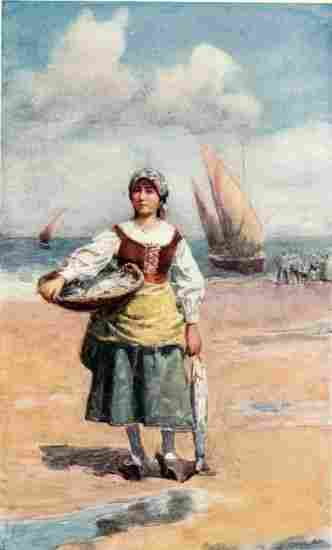
A FISHER GIRL (COAST OF MALAGA)
Every town and village in this thickly peopled region has its historical memories. Villena recalls the famous family to which it gave the title of marquis; Jativa, a desperate struggle during the War of the Spanish Succession, in which much English blood was spilled. This latter town was the birthplace of Ribera, and, as some say, of Alexander Borgia. It is situated in a country which might be described as a veritable Mahomet's paradise. The cottages in the neighbourhood are almost suffocated by the palm and orange trees. Beneath the golden fruit we find our way to the castle, or rather castles—the new and the old—built side by side upon a hill. Part of the fabric dates from the time of the Moors. Later, the stronghold served as a state prison. Within its walls languished and died the unhappy Count of Urgel, a pretender to the throne of Aragon, and here passed a ten years' captivity (1512-22) the Duke of Calabria, the rightful heir to the throne of Naples, to leave his prison on his appointment to the viceroyalty of the fair province he surveyed from its windows!
The custodian of the castle shows the usual underground chambers, which may have been, as he alleges, dungeons, but were quite as likely (as they generally were with us) store-rooms and wine cellars.
At Alcira we cross the Jucár, after the Ebro the most important Spanish river running into the Mediterranean Sea. It rises within a few miles of the source of the Tagus, in the Montes Universales, on the borders of Aragon and New Castile, and flows south through the plains of La Mancha till it enters the province of Albacete, when it takes an easterly course. In the same province of Valencia it has excavated some magnificent gorges. It is indeed a strong, impetuous stream, bursting its banks again and again and levying a heavy tribute on the surrounding country. Each time it makes for itself a new channel, sweeping away whole villages. The village of Alcocer stood on its banks, near its confluence with the Albaida. After countless harvests had been devastated and inestimable damage to some extent repaired, the two streams swelled with fury and in one day reduced a vast extent of country to a flat stretch of mud. Then, by another shifting of its bed, the terrible Jucár laid bare the foundations of the homes it had ruined. There is no security of tenure within its valley! Where your house stands to-day, ships may ride to-morrow. Yet here as everywhere else along the prolific shore, the waters form the great source of wealth, fertilizing vast rice-fields and heavy-laden orchards. The marshy and unhealthy lagoon of the Albufera, from which one of Napoleon's marshals took his title, is being gradually filled up by the débris brought down from the mountains by the rivers, and will ultimately form a "huerta" of untold fertility. Meanwhile every effort is made to encourage the afforesting of the rugged hill-sides, in order to check the violence of the floods and the denuding of the arid, desiccated soil. As a result of these wise measures, the kingdom of Valencia will within a short period become one of the two or three richest agricultural districts in all Europe.
The history of the land is that of its capital. Valencia is first mentioned as having been granted by the consul Junius Brutus to the warriors of Viriathus upon the death of their chief, and their consequent surrender. The history of few Roman colonies, as it has reached us, is of interest. The province had the usual martyrs under the persecutions of Diocletian and Decius, and was the place of banishment of the zealot Ermengild. It remained under the Moorish yoke for over five hundred years, at one time forming part of the khalifate, at other times constituting one or more petty kingdoms.
Don Téodoro Llorente speaks of "The slave kings" of Valencia, and thus describes the rulers of uncertain and various origin who, like the Janissaries of Turkey, had begun as slaves in the palace of the khalifa and won power for themselves with their swords. One of these princes added the Balearic Isles to his realms, and unsuccessfully attempted the conquest of Sardinia.
The kingdom thus founded by military adventurers was overthrown by the most famous of that warlike brood.
The history of the events which brought about the conquest of Valencia by the Cid is extremely complex. The king or amir, Kadir, was the puppet of the rival powers which aspired to the possession of his dominions, and was alternately upheld on his tottering throne by one and the other. Weary of this dishonourable tutelage, the people arose under the leadership of Ibn Jahhaf. Kadir fled disguised as a woman, but was detected and beheaded. That strange anomaly, a Mohammedan republic, was formed. In other words, Valencia was governed by an assembly of notables called the Al Jama, of which Ibn Jahhaf was the president.
The people which arrogates the right to choose its ruler has ever been considered a sort of pirate among the nations, and fair game for more powerful states. Kadir at the moment of his deposition had been nominally under the protection of the Cid. That redoubtable warrior, under the pretext of avenging his protégé's death, advanced on Valencia. The Almoravides came to his assistance, but precipitately retired. Distrusting these allies almost as much as the Christians, Ibn Jahhaf amused the Cid with negotiations, but meanwhile made preparations for defence. He became the special object of the famous warrior's hatred, and when the city fell, was burnt to death at the stake before the eyes of his horrified countrymen. The Cid now ruled Valencia as absolute lord and despot till his death, five years later, in 1097. The legend need not be related here, how his wife defended the city for two years after his death, and finally, setting his corpse fully armed upon his warhorse, won a victory over the terrified Moors and thus took him to his last resting-place at Cardeña.
Valencia was not finally wrested from the yoke of Islam till the memorable 28th of September, 1238, when the standard of the victorious Jaime I. of Aragon was hoisted over the tower of Ali Bufat. In the history of Aragon the conquest ranks with the taking of Seville in the history of Castile. Granada was the joint conquest of both kingdoms. It is curious to compare the ready submission of the Moors, and their surrender of whole kingdoms to the Christians, sometimes as the result of a single battle, with the tenacious resistance offered by their descendants in Algeria in modern times. Enervated by the climate of Spain, the Mussulmans of that country were absolutely incapable of maintaining a prolonged guerrilla warfare. If a fortified capital was taken they at once handed over the whole kingdom to the conqueror. They were not, of course, peculiar in this respect. The sentiment of nationality and physical courage are characteristic far more of the modern than of the ancient world. We have only to compare the resistance of the Anglo-Saxons to the Normans with that of the Boers to the British, of the French in the Hundred Years' War with that of their descendants in 1871, to realize how much more of manliness and endurance we possess than did our ancestors. We must go back to the days of Leonidas and Regulus to find parallels for the exploits of our own Indian army; to Numantia and Saguntum for parallels to Saragossa and Gerona. National and individual self-respect withered under feudalism, and revived only on the introduction of free institutions.
Valencia to-day, as befits the capital of a rich, prosperous province, is a handsome, modern progressive city. There is little or nothing about to remind one of its erstwhile masters, the Moors, and it has not retained more monuments of its past than most other cities. Interesting it is not from the sightseer's point of view, nor convenient from a stranger's, since indications of the names of the streets are few and far between. New avenues are being formed, and in these magnificent houses are arising, all happily in different styles, original and individual, forming a contrast to the dull uniformity of most Continental town perspectives. At two points the town is entered by massive gates of the castellated type—the Torres de Serranos and de Cuarte. The former date from the fourteenth century, and have two octagonal towers with heavy machicolations at two-thirds of their height; the machicolation is continued across the connecting storey, which is richly panelled above the narrow archway. The Torres de Cuarte are drum towers, similarly flanking a gateway; in this case the parapet is itself borne on corbels and machicolated. The work dates from the fifteenth century. These towers add much to the picturesqueness of their respective quarters. The Citadel, in another part of the town, replaces the old temple built in 1238 by the Knights Templars on the spot where the Aragonese planted their cross on entering Valencia. It contains the chapel where St. Vicente Ferrer, "the Angel of the Judgment," took the habit of St. Dominic.
A glance at the Cathedral and the Lonja, and we shall have "done" Valencia in the tourist's sense. The former building was founded in the year 1262 on the site of the principal mosque. In it the Kings of Aragon took the oath as Kings of Valencia. Repeatedly restored, and "modernized" in 1750, it presents a dreadful jumble of styles, and is far behind the cathedrals of Andalusia in beauty and interest. The Micalet Tower, however, rising at the end of the Calle de Zaragoza, presents a striking appearance. It is the great landmark of the district, and the Valencians refer to exile as "losing sight of the Micalet." The view from the summit is very fine. The main entrance to the Cathedral is poor, but the north door, called the Puerta de los Apostoles, richly sculptured and delicately moulded, exhibits the skill and imagery of the fourteenth century at its best.
Above the interesting semicircular Puerta del Palau are seen on medallions the heads of seven men and seven women—these representing the seven knights of the Conquest and the seven ladies (some say of Valencia, and others of Lerida) whom they married. From these alliances sprang the nobility of the province. This doorway was evidently constructed by the architect who designed the Puerta dels Infants at Lerida.
The interior has also suffered by restoration. The pointed arches have been rounded, the Gothic columns almost concealed by Corinthian pilasters, the walls covered with marbles. The effect is rich ("La Rica" is the surname which particularly distinguishes this Cathedral), but much of the religious antique air of the place has gone for ever. The plan is, as usual with Spanish churches, cruciform. The chancel was reconstructed in 1682, but the altar was melted down by the French in 1809. Fortunately the fine panel-shutters made for its protection in the sixteenth century have been preserved. They were carved by a carpenter named Carles, and are painted with scenes from the lives of Christ and the Virgin. These works are ascribed by some to Francisco Pagano and Pablo de San Leocadio, by others to Leonardo da Vinci himself. Hanging to one of the pillars on the Gospel side may be seen the spurs and bridle of Jaime lo Conqueridor, presented by him, on the day he took the city, to his master of the horse, Juan de Perthusa.
Over the crossing rises the fine octagonal lantern, built in 1404 and restored in 1731. The trophies which once adorned it have long since been carried off, among them the flags taken from the Genoese by Ramon Corveran, a famous sea-dog of Valencia.
The pulpit, over which is displayed a picture of St. Vicente Ferrer, was the one from which that zealous missionary actually preached. It can, however, hardly be regarded as a curiosity, as the saint must have preached in nearly every church in the Peninsula, France, and Flanders.
The choir is modern, except the rear portion or "trascoro," which dates from the end of the fifteenth century; and the chapels contain little that is of interest. Tomás de Villanueva, the holy Archbishop of Valencia, is entombed in the chapel dedicated to him. The chapel of another Valencian saint, St. Francis Borgia, is remarkable for a curious picture representing his conversion of a dying man. The penitent is depicted almost nude, and attended by comically fantastic monsters. Another painting shows the saint, as Duke of Gandía, taking leave of his relatives when about to embrace the religious state.
Leaving the Cathedral, we visit the noble Gothic Lonja, or Silk Exchange, built between the years 1482 and 1498 by Pedro Compte. Though not in the purest style, the result is imposing and dignified. A French writer (M. Paul Jousset), not addicted to laudatory language, admits that this building is worth a visit to Valencia to see. Its square tower, its crenellated chimneys, open galleries, and high windows, recall the palace-like châteaux of the Loire. Within is a noble hall divided into three by rows of spirally-fluted columns. The roof is studded with stars, and round the frieze runs the inscription: "He only that shall not have deceived nor done usury, shall be worthy of eternal life." For the commercial integrity of Valencia it is to be hoped that the business men frequenting this exchange keep their eyes fixed on the text. Another public building worthy of attention is the Audiencia, in good Renaissance style, with grand halls adorned by portraits of eminent natives of the province. In the Salon de Cortes, the old provincial States assembled till the middle of the eighteenth century.
The minor churches of Valencia are hardly worth a visit—the less so that in this climate the stranger is generally well content to "laze" his time away. He may do this very pleasantly on the Paseo de la Glorieta or Plaza Principe Alfonso, two charming shady spots, where numerous trees are reflected in the waters of the cool basins. Further off, across the parched Turia, you reach the Alameda, a leafy avenue where fountains diffuse a refreshing dew. And if you should chance to doze on one of the benches, you need not fear interruption. This charming promenade, for some occult reason, is neglected by the citizens.
The picture gallery of Valencia is important. It contains fine specimens of contemporary Spanish art, including works by Sorolla and Benlliure. Ribalta may be studied here, and also the less-known masters of the Valencian school, such as Orrente, March, Espinosa, and Juanes. There used to be several fine private collections in Valencia, but these have all been dispersed.
The country round Valencia is far more interesting than the city. In no other part of Spain, says Mr. Brunhés, has man more successfully combated and reduced natural aridity by irrigation and cultivation; so successfully indeed, that from Gandía to Valencia, for instance, a stretch of 100 kilometres, the gardens succeed each other so closely that it is easy to forget—in spite of the naked slopes on the horizon—that these oases occupy a naturally arid soil. This is, in short, the best cultivated province in the kingdom.
The numberless canals and watercourses which intersect the land in all directions are fed for the most part by the Jucár and Turia—the latter the local stream of Valencia—but every possible source is turned to account. Here the water supply, comprised in the Canal of Moncada and the Seven Canals, belongs to the community, by whom is indirectly elected the famous tribunal which meets every Thursday morning at the Apostles' Gate of the Cathedral.
The sittings of this singular court are the most interesting sight in Valencia. In the plaza a crowd of countryfolk are collected, furiously discussing their affairs and pleading their cases in advance, after the manner of litigants all the world over. Meanwhile the alguazil of the tribunal has disposed an ancient sofa in the shadow of the great Gothic portal and marked off a space before it with a railing. Presently the seven judges arrive—one for each canal. They have the air of well-to-do peasants, and such they are—grave, stoutly-built men, with tanned faces and close-cropped hair. They wear black, the colour beloved by the comfortably-situated working man all the world over; but they have not discarded the native handkerchief round their polished brows or the espadrilla, or Valencian shoe. Each is known by the name of the canal which he represents—Mislata, Cuarte, and so forth. These peasant-magistrates having taken their seats, the oldest pronounces the words "Se obri el tribunal" (The tribunal is open). For a moment absolute silence reigns. Then those who have the right to be heard first are introduced within the railing and plead their cause bare-headed before the court. Woe to the insolent wight that dare stand covered in its presence! The alguazil will tear the handkerchief off his head, and he will be mulcted, moreover, in a fine. Anyone who speaks before his turn is fined. The discipline is severe. Each must wait till the president indicates with his foot that it is his turn to be heard. Notwithstanding, the fiery Valencians find it hard to restrain their feelings. At every moment there is an explosion of wrath or indignation, a heated expostulation from one or the other of the parties. The fines thus accumulated must represent a considerable sum. The procedure is entirely verbal; even the judgments are not recorded. But no court exercises more absolute power than the Tribunal de las Aguas of Valencia.
Life in the fertile huerta of Valencia is beautifully described by the great novelist, Blasco Ibañez, a native of the city. The following roughly translated passages, though they convey little idea of the forceful and elegant style of the original, will at least enable the reader to picture a summer in the South:
"When the vast plain awakes in the bluish light of dawn, the last of the nightingales that have sang through the night breaks off abruptly in his final trill, as though he had been stricken by the steely shaft of day. Sparrows in whole coveys burst forth from the thatched roofs, and beneath this aerial rabble preening their wings, the trees shake and nod.
"One by one the murmurs of the night subside—the trickling of watercourses, the sighing of the reeds, the barking of the watchful dogs. Other sounds belonging to the day grow louder and fill the huerta. The crow of the cock is heard from every farm; the village bells re-echo the call to prayer borne across from the towers of Valencia, which are yet misty in the distance; from the farmyards arises a discordant animal concert—the neighing of horses, the bellowing of oxen, the clucking of hens, the bleating of lambs, the grunting of swine—the sounds produced by beasts that scent the keen odour of vegetation in the morning breeze and are hungry for the fields.
"The sky is suffused with light, and with light, life inundates the plain and penetrates to the interior of human and animal abodes. Doors open creaking. In the porches white figures appear, their hands clasped behind their necks, scanning the horizon. From the stables issue towards the city, milch cows, flocks of goats, manure carts. Bells tinkle between the dwarf trees bordering the high road, and every now and again is heard the sharp 'Arre, Aca!' of the drivers.
"On the thresholds of the cottages those bound for the town exchange greetings with those that stay in the fields: 'Bon dia nos done Deu!' (May God give us a good day!) 'Bon dia.'
"Immense is the energy, the explosion of life, at midsummer, the best season of the year, the time of harvest and abundance. Space throbs with light and heat. The African sun rains torrents of fire on the land already cracked and wrinkled by its burning caresses, and its golden beams pierce the dense foliage, beneath which are hidden the canals and trenches to save them from the all-powerful vivifying heat.
"The branches of the trees are heavy with fruit. They bend beneath the weight of yellow grapes covered with glazed leaves. Like the pink cheeks of a child glow the apricots amid the verdure. Children greedily eye the luscious burden of the fig trees. From the gardens is wafted the scent of the jasmin, and the magnolias dispense their incense in the burning air laden with the perfume of the cereals.
"The gleaming scythe has already sheared the land, levelling the golden fields of wheat and the tall corn stalks, which bowed beneath their heavy load of life. The hay forms yellow hills which reflect the colour of the sun. The wheat is winnowed in a whirlwind of dust; in the naked fields among the stubble, sparrows hop from spot to spot in search of stray gleanings. Everywhere are happiness and joyous labour. Waggons go groaning down the road; children frolic in the fields and among the sheaves, thinking of the wheaten cakes in prospect and of the lazy, pleasant life which begins for the farmer when his barn is filled. Even the old horses stride along more gaily, cheered by the smell of the golden grain which will flow steadily into their mangers as the year rolls on.
"When the harvest has levelled the panorama and cleared the great stretches of wheat sprinkled with poppies, the plain seems vast, almost illimitable. Farther than the eye can reach stretch its great squares of red soil marked off by paths and trenches. The Sunday's rest is rigorously observed over the whole countryside. Not a man is seen toiling in the fields, not a beast at work on the road. Down the paths pass old women with their mantillas drawn over their eyes and their little chairs hanging to their arms. In the distance resound, like the tearing of linen, the shots fired at the swallows, which fly hither and thither in circles. A noise seems to be produced by their wings ruffling the crystal firmament. From the canals rises the murmur of clouds of almost invisible flies. In a farm all painted blue under an ancient arbour there is a whirlwind of gaily coloured shawls and petticoats, while the guitars with their drowsy rhythm and the strident cornets accompany the measures of the Valencian Jota.
"In the village the little plaza is thronged with the field folk. The men are in their shirt sleeves, with black sashes and gorgeous handkerchiefs arranged mitre-like on their heads. The old men lean on their big Liria sticks. The young men, with sleeves turned up, display their red nervous arms and carry mere sprigs of ash between their huge knotted fingers.
"In the afternoon, towards the fountain, along the road bordered with poplars which shake their silvered foliage, go groups of girls with their pitchers on their heads. Their rhythmical movements and their grace recall the Athenian canephoræ. This procession to the well lends to the huerta of Valencia something of a biblical character. The Fontana de la Reina is the pride of the huerta, condemned to drink the water of wells and the red and dirty liquid of the canals. It is esteemed as an ancient and valuable work. It has a square basin with walls of reddish stone. The water is below the soil. You reach the bottom by means of six green and slippery steps. Opposite the steps is a defaced bas-relief, probably a Virgin attended by angels—no doubt an ex-voto of the time of the Conquest. Laughter and chatter are not wanting round the well. The girls cluster round, eager to fill their pitchers but in no hurry to depart. They jostle each other on the steps, their petticoats gathered in between their legs, the better to lean forward and to plunge their vessels into the basin. The surface of the water is unceasingly troubled by the bubbles rising from the sandy bed, which is covered with weeds waving in the current."
INDEX
Abades, No. 6, 70
Abbad, Mohammed Ben, 22
Abdallah, Ahmed Ben, 21
Abd-el-Aziz, 19
Abd-ur-Rahman, 89
Abd-ur-Rahman III., 21
Abu-l-Walid, 115
Adra, 168
Ælii, 16
Ahmar, Mohammed al, 27, 113
Alarcos, 26
Albaicin, 148
Alcazaba, 129
Alcazares, 35
Alcazar Genil, 161
Alcoy, 190
Alfonso VI., 24, 25, 98
Alfonso X., 114
Alfonso the Battler, King, 189
Alfonso the Learned, 4, 181
Al Hakem II., 90
Alhama, 121
Alhambra, The, 124
Alicante, 189
Al Mansûr, 90
Almeria, 168
Almohades, 26, 30, 112
Almoravides, 26, 112, 194
Aragon, Don Jaime of, 179
Arfe, Juan de, 60, 96
Aurariola, 178
Az Zahara, 97
Barbuda, Don Martin de la, 102, 119
Baths, 143
Bekr, Abu, 179
Belludo, 145
Ben Hud, 27, 113
Biblioteca Colombina, 35
Boabdil, 121
Cadiz, 1
Cadiz, Marquis of, 121
Cæsar, Julius, 16
Campaña—See Kempener
Campillo, 160
Cano, Alonso, 66, 75, 155, 165
Caños de Carmona, 81
Capilla Real, 152
Cartagena, 182
Carthaginians, 3, 14, 15
Cartuja, 84, 158
Casa de Bustos Tavera, 70
Casa del Carbon, 147
Casa de los Tiros, 160
Casa de Pilatos, 66
Cathedral, 50, 151, 155, 165, 196
Cespedes, Pablo de, 75, 103
Charles V., 95
Cid Campeador, Ruy Diaz de Bivar, 112, 193
Colon, Fernando, 57
Columbus, Christopher, 56, 160
Cordova, 86
Cornejo, Duque, 95, 96
Coronel, Doña Maria, 38
Cortes, Hernando, 83
Court of the Lions, 137
Cuarto de Santo Domingo, 160
Dance of the Seises, 81
Dávalos, Leonor, 38
Delicias Gardens, 77
Dios, San Juan de, 156
Drake, Sir Francis, 4
Elche, 187
El Greco, 60
Enrique III., 119
Ermengild, 18, 193
Ermita de San Sebastian, 160
"Esperandola del Cielo," 149
Essex, Earl of, 5
Exilona, 19
Fadrique, Don, 46
Fair of Seville, 79
Ferdinand and Isabella, 121
Fernandez, Alejo, 85
Fernando el Magno, 24
Ferrer, St. Vincent, 35
Frutet, 75
Gandía, 190
Gandia, Duke of, 157
Generalife, The, 146
Gibralfaro, 164
Gibraltar, 173
Giordano, Luca, 58
Gipsies, 84
Giralda Tower, 31
Gongora, 95
Goya, 60
Granada, 107
Great Captain, 102, 156
Guadalquivir, The, 9
Guzman el Bueno, 83
Hajjaj, Ibrahim Ibn, 20
Hall of the Two Sisters, 139
Halls of the Abencerrages, 139
Hasan, Mulai, 121
Hernandez (Gonzalo), de Aguilar y de Cordova, "the Great Captain," 102, 156
Herrera, 58, 61, 66
Herrera, The Older, 75
Illiberis, 111
"Intransigentes," 182
Irrigation, 175, 200
Isidore, St., 19
Ismaïl, Saïd Ben, 121
Italica, 15, 17, 18, 82
Jaime lo Conqueridor, 186, 194, 198
Jativa, 190
Jerez, 10
Juan II., 16
Jucár, 191
Junteron, Don Gil, 181
Kadir, 193
Kempener, Peter, 55, 58, 59
La Caridad, 74
"Las Navas de Tolosa," 26
La Trinidad, 19
Leal, Valdés, 58, 59, 74, 75
Leander, 18
Lebrija, 11
Leovgild, 18
Levi, Simuel Ben, 37
Lonja, 196, 199
Lorca, 175
Lucan, 16
Majus, 21
Malaga, 163
Malecon, 180
Marana, Miguel de, 73
Mena, Juan de, 104
Mezquita, 88
Mihrab, 144
Mirador de "Lindaraja," 142
Mohammed II., 114
Mohammed III., 114
Mohammed IV., 116
Mohammed V., 117, 171
Mohammed VI., 119
Mohammed VII., 121
Mohammed VIII., 121
Mohammedan Paintings, 140
Montañez, 58, 60, 66, 75, 83
Mote'mid, 23
Motril, 168
Munda, 170
Murcia, 174, 179, 180
Murillo, 8, 56, 58, 59, 60, 61, 73, 74, 75, 76
Musa, 19
Museo of Seville, 74
Musset, Alfred de, 7, 12, 71
Mut'adid-billah, Amir, 22
Muwallads, 20
Nasr, Abu-l-Juyyush Muley, 115
Northmen, 21
Omnium Sanctorum, 65
Oratory, 144
Orihuela, 178, 186
Osorio, Doña Urraca, 38
Padilla, Maria de, 46
Palace of Charles V., 131
Palace of St. Telmo, 76
Palacio de las Dueñas, 70
Palomino, 95
Paredes, Doña Maria de Guzman, 95
Patio de Daraxa, 142
Patio de la Alberca, 135
Patio de las Arrayanes, 135
Patio de las Muñecas, 45
Patio de los Naranjos, 34
Patio "del Mexuar," 134
Pedro the Cruel, 36
Phœnicians, The, 2, 14
Pineda, Doña Mariana, 157
Plaza de Bibarrambla, 151
Poore, Lawrence, 28
Puerta de Hierro, 144
Puerta de la Justicia, 128
Puerta del Lagarto, 53
Puerta del Perdon, 34
Puerta del Vino, 130
Puerto Santa Maria, 10
Pulgar, Fernando del, Lord of El Salar, 152
Ramon Bonifaz, 27
Recchiarus, 17
Ribera, 190
Robles, Joao de, 156
Roelas, Juan de las, 58, 65, 75
Roldán, Pedro, 61
Romanticists, 6, 7
Ronda, 170
Rueda, Lope de, 95
Sacromonte, 158
Saïd, Abu, 37, 118, 171
St. Ferdinand, 27, 55, 95
St. Isidore, 24
St. Justa, 84
St. Rufina, 84
St. Vicente Ferrer, 196, 198
Sala de la Justicia, 140
Sala de los Embajadores, 136
Salambo, 15, 84
Salon de los Embajadores, 44
San Geronimo, 156
Santa Ana, 85
Santa Paula, 64
Santo Domingo, 160
Scipio, 15
Seneca, 16
Seville, 12
Siloe, Diego de, 156, 165
Suevi, 17
Talavera, Archbishop de, 123
Tarik, 19
Tarshish, 3
Tendilla, Count of, 123
Theodomir, 178
Theudis, 17
Theudisel, 17
Tocador de la Reina, 143
Todmir, 179
Torre de Cuarte, 196
Torre de Serranos, 196
Torre del Agua, 145
Torre del Homenage, 130
"Torre del Oro," 29
Torre de la Cautiva, 145
Torre de la Vela, 129
Torre de las Damas, 144
Torre de las Infantas, 145
Torre de los Picos, 144
Torre de los Siete Suelos, 145
Torres Bermejas, 127
Tower of Comares, 136
Triana, 84
Tribunal de las Aguas, 201
Turdetani, 14
University Church, Seville, 65
Utrera, 11
Valdes, 75
Valencia, 192, 195
Vandals, 16
Vargas, Luis de, 34, 58, 59, 75
Velazquez, 75
Velez Chapel, 182
Vermilion Towers, 125
Vigarni, 153
Visigoths, 17
Yusuf I., 117
Yusuf II., 119
Yusuf III., 120
Yusuf IV., 121
Zacatin, 150
Zaghal, 122
Zahara, 121, 171
Zayda, 25
Zegri, Hamet el, 164
Ziryab, 101
Zurbaran, 58, 60, 75
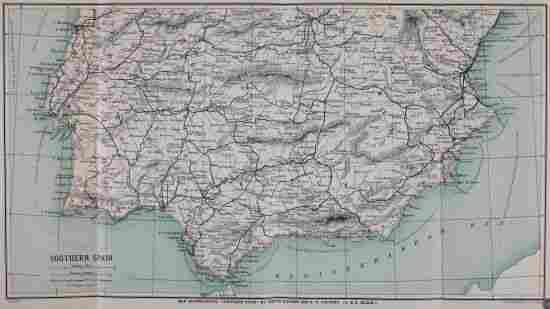
MAP ACCOMPANYING "SOUTHERN SPAIN" BY TREVOR HADDEN AND A. F. CALVERT. (A. & C. BLACK)
View Medium (1.1mb)
View Large (4.7mb)


